Table of Contents
- Important Safety Instructions
- Table of Contents
- Tables
- Figures
- 1. About this Manual
- 2. Product Description
- 3. Installing the Product
- 3.1 Grounding the Battery System
- 3.2 Arc Flash Calculations
- 3.3 Installation Procedure
- 3.4 Preparation Stage—Procedure
- 3.5 Preparation Stage—Unpacking
- 3.6 Preparation Stage—Ground Wire and Tools
- 3.7 Preparation Stage—Recommended Tools/Instruments
- 3.8 Preparation Stage—Visual Inspection
- 3.9 Rack Anchoring Stage
- 3.10 Rack Installation Stage
- 3.10.1 Front Door Removal
- 3.10.2 SMU and SMPS Assembly Installation
- 3.10.3 Battery Module Installation
- 3.10.4 Fuse-Busbar Assembly
- 3.10.5 Busbar Installation
- 3.10.6 Module and SMU Signal Cable Connection
- 3.10.7 SMPS Assembly and SMU Power Cable Connection
- 3.10.8 SMPS Assembly and SMU Signal Cable Connection
- 3.10.9 SMPS Assembly AC Input Connection
- 3.10.10 DC Link Cable Connection
- 3.10.11 AC Input Commissioning
- 3.10.12 BMS Configuration
- 3.10.13 Communication Check
- 3.10.14 Reinstall the Front Door
- 3.10.15 Reinstall the Front Panel
- 3.10.16 Switching on the MCCB
APC LIBSMG95OUL User Manual
Displayed below is the user manual for LIBSMG95OUL by APC which is a product in the UPS Battery Cabinets category. This manual has pages.
Related Manuals
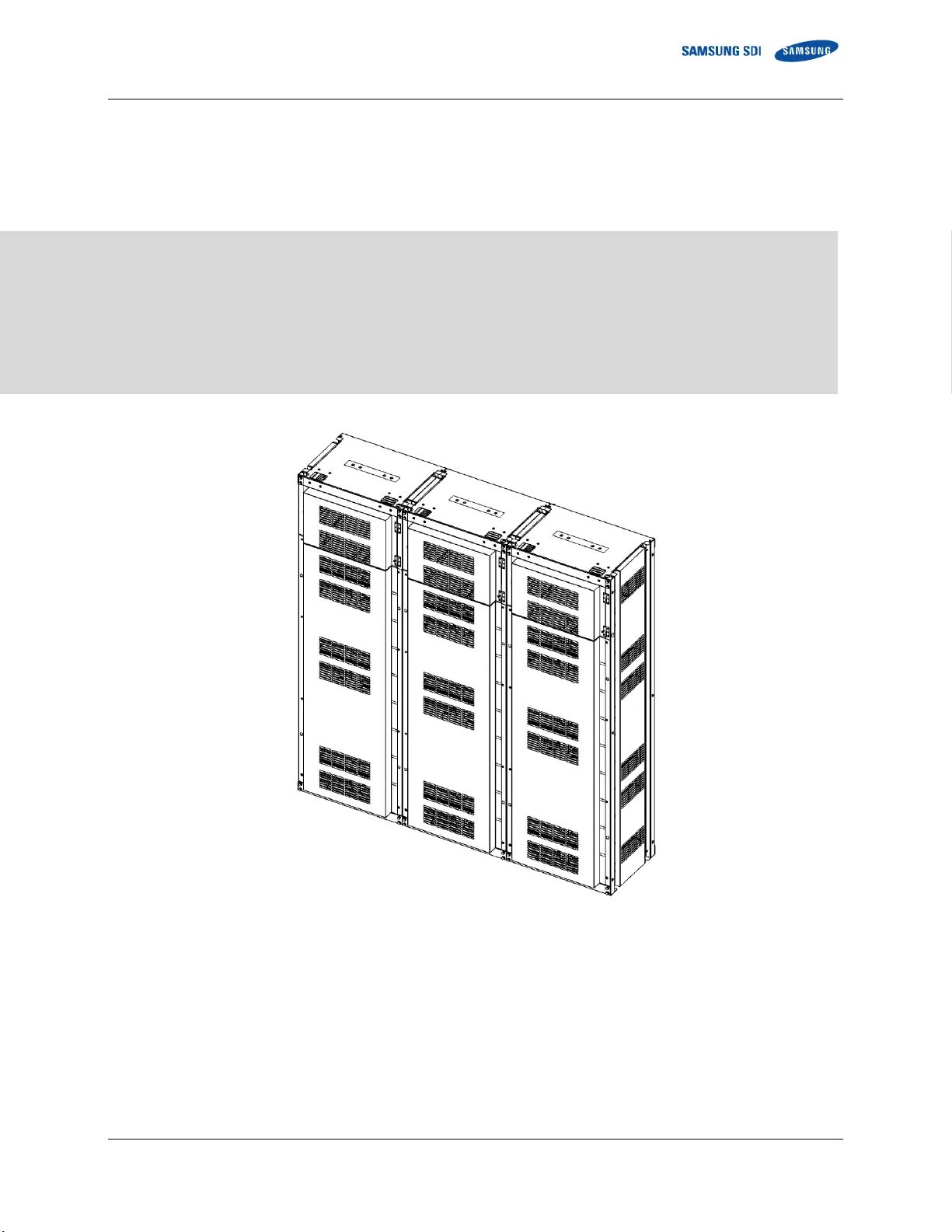
English 7/2020. Rev 0.41
LIB System for UPS – U6A4
Installation Manual
(80S)

English 7/2020. Rev 0.41
Read this manual carefully before starting to install the battery system. Keep
these instructions for future reference.

English 7/2020. Rev 0.41
Copyright © 2019 SAMSUNG SDI Co., Ltd. All rights reserved.
This document contains information that is the property of SAMSUNG SDI Co., Ltd., and provides for the sole
purpose of the installation, operation, and maintenance of products of SAMSUNG SDI Co., Ltd. No part of
this publication is to be used for any other purpose, and it is not to be reproduced, copied, disclosed,
transmitted, stored in a retrieval system, or translated into any human or computer language, in any form, by
any means, in whole or in part, without prior written consent of SAMSUNG SDI Co., Ltd.
Although every possible effort has been made to ensure the accuracy of this document, SAMSUNG SDI Co.,
Ltd. assumes no responsibility for errors that may appear herein. The information is subject to change
without notice.

English 7/2020. Rev 0.41
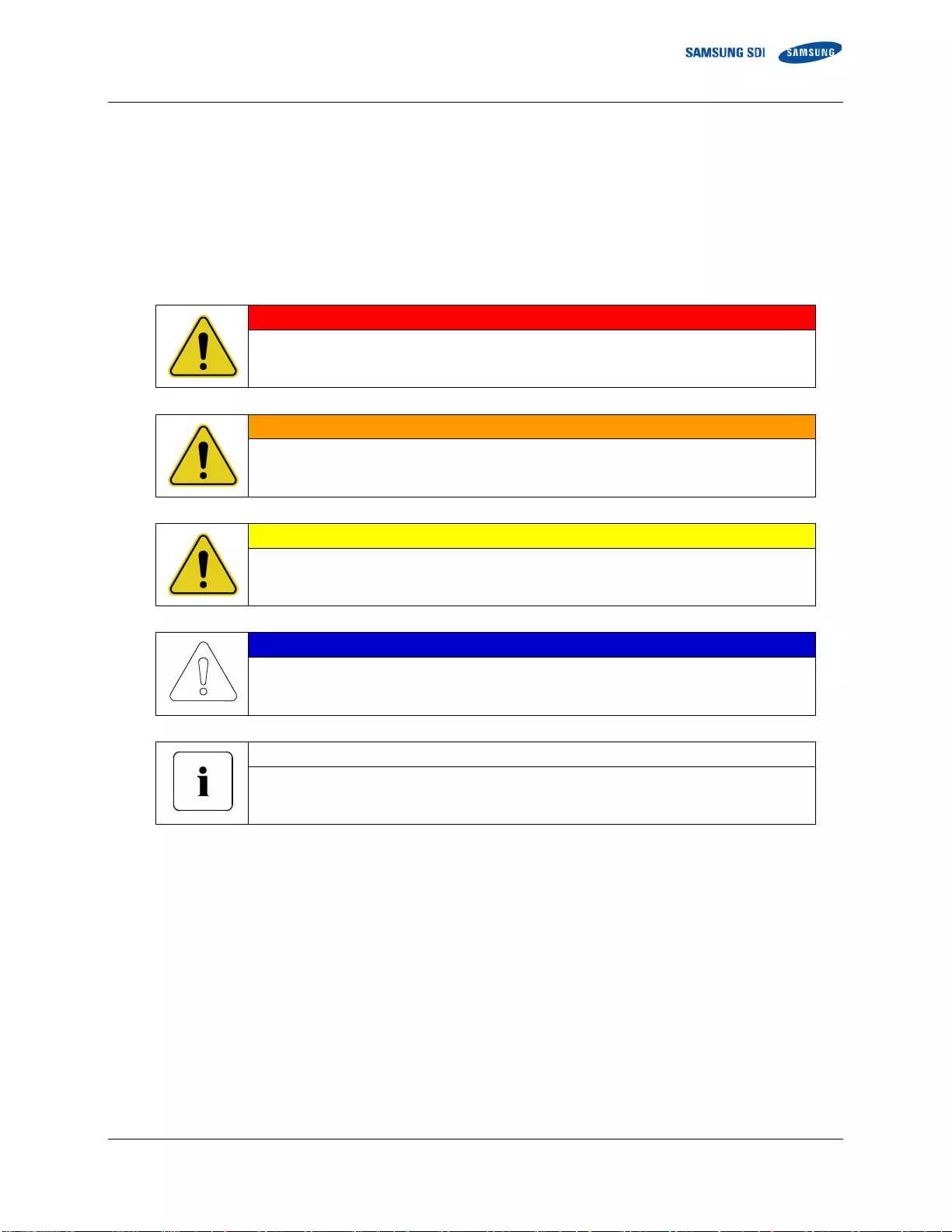
Important Safety Instructions
English 7/2020. Rev 0.41 i
Important Safety Instructions
Read and follow these instructions!
The following precautions are intended to ensure your safety and prevent property damage. Before installing
this product, be sure to read all safety instructions in this document for proper installation.
DANGER
Failure to comply with the instructions with this symbol may result in a serious accident, causing
death or a severe injury.
WARNING
Failure to comply with the instructions with this symbol may result in a serious accident, causing a
severe injury.
CAUTION
Failure to comply with the instructions with this symbol may result in minor or moderate injury.
NOTICE
Provides information considered important but not hazard-related. The information relates to
property damage.
Important
Indicates valuable tips for optimal installation and operation of the product.

Important Safety Instructions
ii English 7/2020. Rev 0.41
General Instructions
Please be aware that a battery presents a risk of electrical shock including high short-circuit current. Follow
all safety precautions while operating the batteries.
Remove watches, rings, and other metallic accessories.
Use tools with insulated handles in order to avoid inadvertent short circuits.
Wear rubber gloves and safety boots.
Do not put tools or any metal parts on the top of the batteries.
Disconnect charging source and load before connecting or disconnecting terminals.
Use proper lifting means when moving batteries and wear all appropriate safety clothing and equipment.
Batteries must be handled, transported and recycled or discarded in accordance with federal, state, and local
regulations. Do not dispose of the batteries in a fire because they can explode.
Do not open or mutilate the batteries.
Only authorized, trained technicians should perform annual preventive maintenance.
Only qualified personnel who are familiar with the batteries and safety precautions should perform
installation or maintenance of the battery.
Do not allow unauthorized personnel to contact the batteries.
Safety Precautions
The following precautions provide general safety guidelines that should be followed when working with or
near the Energy Storage System (ESS). Complete safety parameters and procedures are site-specific and
should be developed by the customer for the installation site.
Review and refer to all safety warnings and cautions in this manual before installation.
Build a clear, permanent, restricted access area around the system.
Only authorized, adequately trained electrical operators should be able to access the system.
The interior design of this equipment must be considered a “no-go area except for non-qualified personnel
who are familiar with the batteries and safety precautions,” depending on the location. Consult local codes
and applicable rules and regulations to determine permit requirements. If required, mark enclosures
appropriately before beginning work.
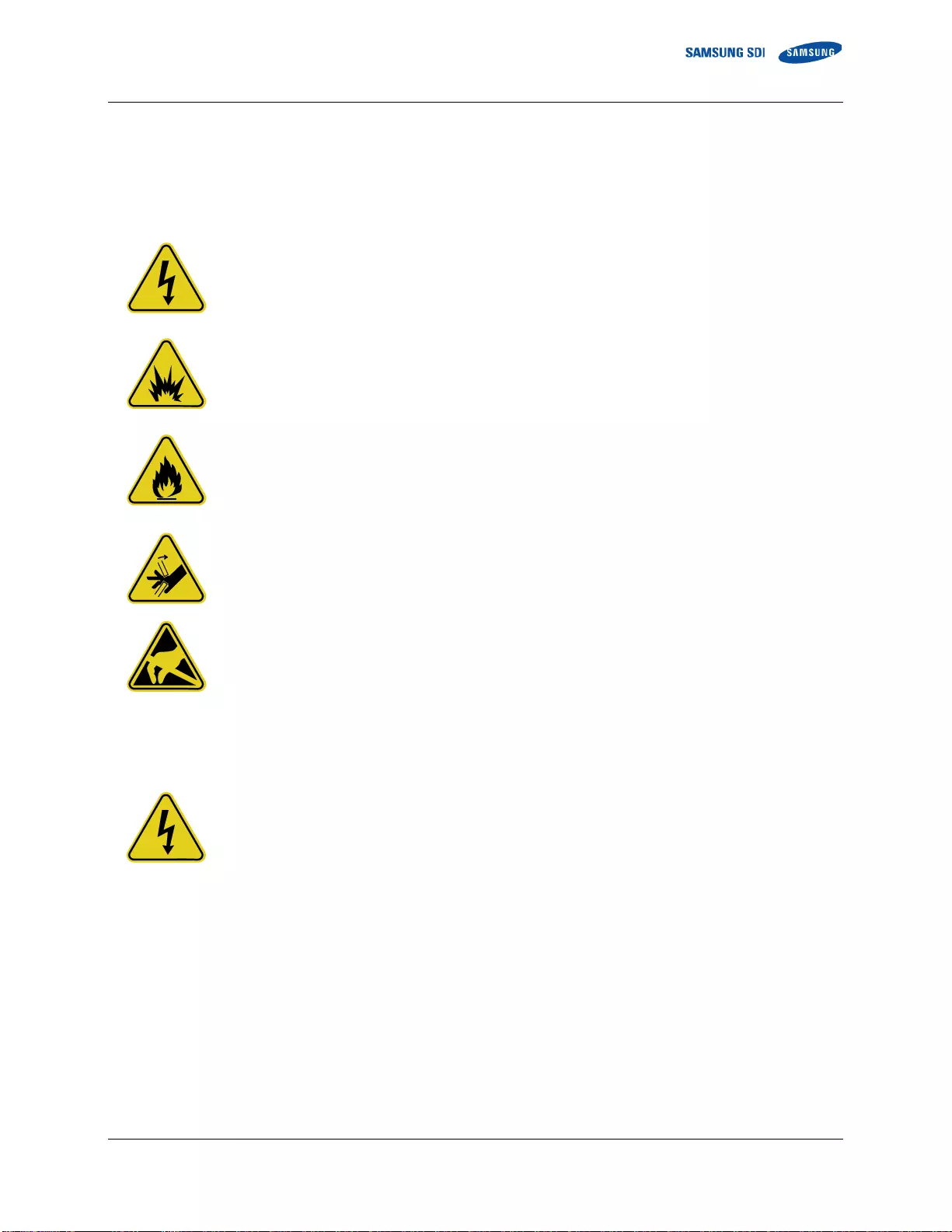
Important Safety Instructions
English 7/2020. Rev 0.41 iii
Personnel and Equipment Warnings
Personnel in contact with the battery system should be aware of the following hazards:
WARNING—SHOCK HAZARD
Do not contact system connectors or terminals. Do not open the enclosure doors unless proper lock
out/tag out procedures and related trainings are followed in accordance with the local codes and
regulations.
WARNING—ARC FLASH HAZARD
There is an arc flash hazard associated with all electrical equipment. There is a serious risk of arc flash
relating to any equipment modification (e.g. opening doors). Serious injuries can occur in arc flash
incidents. Appropriate training is required in accordance with local codes and regulations.
WARNING—FIRE HAZARD
Fire may occur under certain fault conditions.
CAUTION—PINCH POINTS
Multiple pinch-points are present in most system components. Be aware that there is a serious risk of
injury while working around and in equipment enclosures.
CAUTION—STATIC SENSITIVE
Electronic appliances can be damaged by electrostatic discharge. Proper handling procedures are
required. Be sure to wear a grounded anti-static wrist strap and to discharge static electricity by touching
a grounded surface near the equipment before touching any system components.
Dangerous Voltages
DANGER
The ESS is powered by multiple power sources. Hazardous voltages may be present in the equipment
even when it does not appear operational. Make sure that you completely understand the cautions and
warnings in this installation manual. Failure to do so may result in serious injury or death. Follow all
manufacturer-published safety procedures.
Electrical equipment can present a risk of electrical shock and can cause arc flash. The following
precautions must be observed when working on or around electrical equipment:
Remove watches, jewelry, rings, and other metallic objects.
Use tools with insulated handles.
Safety clothing and shoes must comply with local codes and regulations.
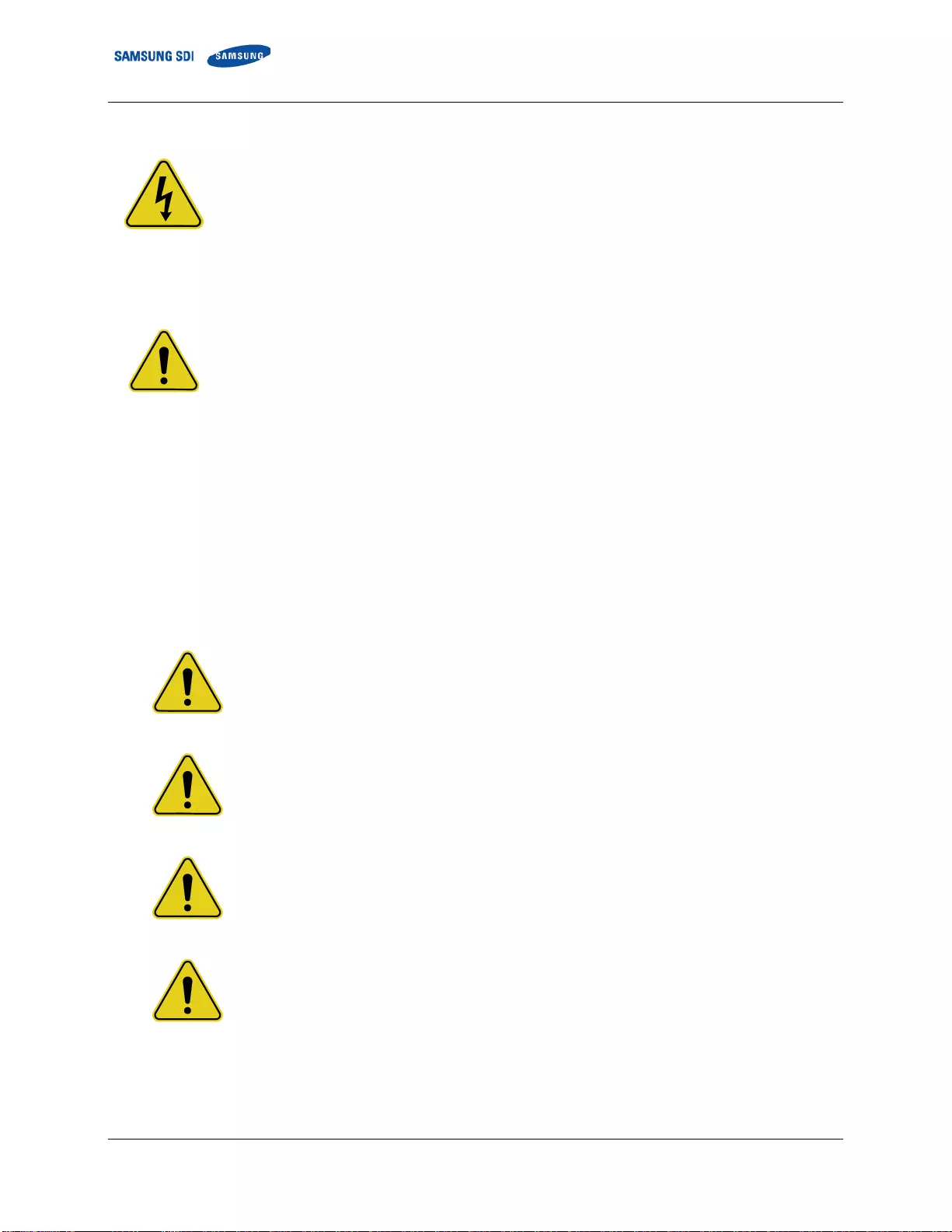
Important Safety Instructions
iv English 7/2020. Rev 0.41
Lock Out/Tag Out Guidelines
DANGER
Follow all applicable lock out/tag out procedures at all times. Failure to follow proper lock out/tag out
procedures may result in serious injury or death.
With power applied to the ESS, hazardous voltages are present on some components. To prevent
accidental death or injury, do not touch any components within the enclosure unless you are specifically
directed to do so. To reduce the risk of electrical shock, make sure that all equipment is properly
grounded. For more information, refer to 3.1 Grounding the Battery System
WARNING
Enclosure doors must remain closed except when access to the enclosure interior is required. If possible,
personnel should keep a safe distance from enclosures whenever the equipment is energized. Always
comply with local, state, and national lock out/tag out guidelines when working with or near the ESS. The
lock out/tag out procedures must meet or exceed the requirements of all guidelines presented in
SAMSUNG SDI safety documentation. Before entering potentially hazardous areas or beginning work on
the ESS, complete the following tasks:
Identify and wear protective clothing and shoes.
Identify and isolate all power and stored energy sources.
Apply appropriate lock out/tag out devices. When applying lock out/tag out to the ESS, do not touch anything within the
enclosure except as specifically directed in the work procedures.
Complete the site-specific lock out/tag out procedures and safety checklist before beginning work.
General Warnings
DANGER
When energized, this equipment presents a potential hazard of electric shock, death, and burn.
Only authorized personnel who are thoroughly familiar with the equipment and adequately
trained should install, operate, or maintain this equipment.
DANGER
To avoid death, personal injury, or damage to the product, follow all safety procedures as
regulated by Environmental Health and Safety (EHS) guidelines.
DANGER
To minimize the hazards of electrical shock, death, and burns, approved grounding practices and
procedures should be strictly followed.
WARNING
To avoid personal injury and damage to equipment, personnel must adhere to the site protocol
concerning working at heights.

Important Safety Instructions
English 7/2020. Rev 0.41 v
WARNING
To avoid personal injury or equipment damage caused by equipment malfunction, only adequately
trained personnel should modify any programmable machine.
WARNING
Always ensure that applicable standards and regulations are followed and only properly certified
equipment is used as a critical component of a safety system. Never assume that a safety-critical
control loop is functioning correctly.

Table of Contents
English 7/2020. Rev 0.41 i
Table of Contents
Important Safety Instructions ................................................................................................................. i
General Instructions ............................................................................................................................................... ii
Safety Precautions ................................................................................................................................................. ii
Personnel and Equipment Warnings ..................................................................................................................... iii
Dangerous Voltages .............................................................................................................................................. iii
Lock Out/Tag Out Guidelines ................................................................................................................................ iv
General Warnings ................................................................................................................................................. iv
Table of Contents ................................................................................................................................... i
Tables ................................................................................................................................................... iii
Figures .................................................................................................................................................. iv
1. About this Manual ............................................................................................................................ 1
1.1 Purpose ....................................................................................................................................................... 1
1.2 Target Audience .......................................................................................................................................... 1
1.3 Organization ................................................................................................................................................ 1
1.4 Revision History ........................................................................................................................................... 2
1.5 Acronyms and Abbreviations ...................................................................................................................... 3
2. Product Description .......................................................................................................................... 4
2.1 Major Components ..................................................................................................................................... 4
2.1.1 Battery Module (Type A / Type B) ...................................................................................................... 5
2.1.2 SMU (String Management Unit) ........................................................................................................ 7
2.1.3 SMPS Assembly (Type A) .................................................................................................................... 8
2.1.4 Rack Frame .......................................................................................................................................... 9
3. Installing the Product ...................................................................................................................... 10
3.1 Grounding the Battery System .................................................................................................................. 10
3.2 Arc Flash Calculations ................................................................................................................................ 11
3.3 Installation Procedure ............................................................................................................................... 12
3.4 Preparation Stage—Procedure .................................................................................................................. 14
3.5 Preparation Stage—Unpacking ................................................................................................................. 15
3.6 Preparation Stage—Ground Wire and Tools ............................................................................................. 16
3.6.1 Ground Wires .................................................................................................................................... 16
3.6.2 Ground Wire Fasteners ..................................................................................................................... 16
3.6.3 Rack Fasteners (Anchors) ................................................................................................................. 16
3.6.4 Multiple Rack Fasteners ................................................................................................................... 16
3.7 Preparation Stage—Recommended Tools/Instruments ............................................................................ 17
3.8 Preparation Stage—Visual Inspection ....................................................................................................... 19
3.8.1 Inspection of the Rack Frame .......................................................................................................... 19
3.8.2 Inspection of the Modules ............................................................................................................... 19
3.8.3 Inspecting the SMU .......................................................................................................................... 19
3.8.4 Inspecting the SMPS assembly ........................................................................................................ 20
3.9 Rack Anchoring Stage ................................................................................................................................ 21
3.10 Rack Installation Stage .............................................................................................................................. 30
3.10.1 Front Door Removal .......................................................................................................................... 31

Table of Contents
ii English 7/2020. Rev 0.41
3.10.2 SMU and SMPS Assembly Installation ............................................................................................. 33
3.10.3 Battery Module Installation ............................................................................................................. 37
3.10.4 Fuse-Busbar Assembly ...................................................................................................................... 40
3.10.5 Busbar Installation ............................................................................................................................ 43
3.10.6 Module and SMU Signal Cable Connection .................................................................................... 65
3.10.7 SMPS Assembly and SMU Power Cable Connection ...................................................................... 74
3.10.8 SMPS Assembly and SMU Signal Cable Connection ....................................................................... 75
3.10.9 SMPS Assembly AC Input Connection ............................................................................................. 77
3.10.10 DC Link Cable Connection ................................................................................................................ 80
3.10.11 AC Input Commissioning .................................................................................................................. 83
3.10.12 BMS Configuration ............................................................................................................................ 84
3.10.13 Communication Check ...................................................................................................................... 84
3.10.14 Reinstall the Front Door ................................................................................................................... 85
3.10.15 Reinstall the Front Panel................................................................................................................... 86
3.10.16 Switching on the MCCB .................................................................................................................... 87

Table of Contents
English 7/2020. Rev 0.41 iii
Tables
Table 3-1: Estimated time for installation (based on 136S 3P installation) .................................................................... 13
Table 3-2: Parts for 80S 2P Rack ..................................................................................................................................... 15
Table 3-3: Ground Wire Specifications ........................................................................................................................... 16
Table 3-4: Ground Wire Fastener Specification .............................................................................................................. 16
Table 3-5: Rack Fastener Specifications .......................................................................................................................... 16
Table 3-6: Rack Fastener Specifications (Side by side) .................................................................................................... 16
Table 3-7: Recommended Tools and Instruments .......................................................................................................... 17
Table 3-8: Module Voltage and Internal Impedance ...................................................................................................... 19
Table 3-9: Rack Clearance Distances ............................................................................................................................... 21

Table of Contents
iv English 7/2020. Rev 0.41
Figures
Figure 2-1: Battery Module Type A ................................................................................................................................... 5
Figure 2-2: Battery Module Type B ................................................................................................................................... 6
Figure 2-3: SMU ................................................................................................................................................................ 7
Figure 2-4: SMPS Assembly Type A ................................................................................................................................... 8
Figure 2-5: Rack Frame ..................................................................................................................................................... 9
Figure 3-1: Installation Procedure .................................................................................................................................. 12
Figure 3-2: Clearance Distance for Single Rack Frame .................................................................................................... 22
Figure 3-3: Clearance Distance for Multiple Rack Frames Installed Side-by-Side ........................................................... 22
Figure 3-4: Clearance Distance for Multiple Rack Frames Installed Side-by-Side and Rear-to-Rear ............................... 23
Figure 3-5: Front panel screws (eight) ............................................................................................................................ 23
Figure 3-6: Front panel hooks (four) ............................................................................................................................... 24
Figure 3-7: Side panel screws (six) .................................................................................................................................. 24
Figure 3-8: Side panel hooks (four) ................................................................................................................................. 25
Figure 3-9: Rear panel screws (eight) ............................................................................................................................. 25
Figure 3-10: Rear panel hooks (four) .............................................................................................................................. 26
Figure 3-11: Rack Anchoring Points (4 EA) ...................................................................................................................... 26
Figure 3-12: Holes on the sides of the rack (six) ............................................................................................................. 27
Figure 3-13: Reattaching the Side Panels (four hooks and six screws for each panel) ................................................... 28
Figure 3-14: Reattaching the Rear Panels ....................................................................................................................... 29
Figure 3-15: Front door ajar ............................................................................................................................................ 31
Figure 3-16: Removing the earth cable ........................................................................................................................... 31
Figure 3-17: Removing the front door ............................................................................................................................ 32
Figure 3-18: All doors and front panels removed. .......................................................................................................... 32
Figure 3-19: Inserting SMU ............................................................................................................................................. 33
Figure 3-20: Attaching a SMU to a Rack Frame .............................................................................................................. 33
Figure 3-21: Ground Cable Connection to the SMU ....................................................................................................... 34
Figure 3-22: Inserting SMPS Assembly ............................................................................................................................ 35
Figure 3-23: Attaching the SMPS Assembly .................................................................................................................... 35
Figure 3-24: Ground Cable Connection to the SMPS Assembly ...................................................................................... 36
Figure 3-25: Insertion of Modules on the Ninth Shelf from the Bottom......................................................................... 37
Figure 3-26: Battery Module Arrangement on the Eighth Shelf ..................................................................................... 38
Figure 3-27: Battery Module Arrangement .................................................................................................................... 38
Figure 3-28 : Module Number ........................................................................................................................................ 39
Figure 3-29: Insertion of modules on 5th shelf ................................................................................................................ 39
Figure 3-30: Fuse Busbar Left Assembly ......................................................................................................................... 40
Figure 3-31: Fuse Busbar Left Assembly (Fuse Cover) .................................................................................................... 41
Figure 3-32: Fuse Busbar Right Assembly ....................................................................................................................... 42
Figure 3-33: Fuse Busbar Right Assembly (Fuse Cover) .................................................................................................. 42
Figure 3-34: Contact Resistance Probe Points (Battery Module Terminal to Busbar) .................................................... 44
Figure 3-35: Copper Busbar Appearance ........................................................................................................................ 45
Figure 3-36: Removing the Module #1’s Cover and SMU B- Terminal Cover .................................................................. 46
Figure 3-37: Connect SMU B- and Module #1 B- ............................................................................................................ 46
Figure 3-38: Restore SMU’s B- Terminal ......................................................................................................................... 47
Figure 3-39: Remove Battery Module #2’s Front Cover.................................................................................................. 47
Figure 3-40: Connect Battery Module #1 B+ and Battery Module #2 B-......................................................................... 48
Figure 3-41: Reattach Battery Module #1’s Front Cover ................................................................................................ 48
Figure 3-42: Remove Battery Module #2’s Front Cover.................................................................................................. 49
Figure 3-43: Connect Battery Module #2 B+ and Battery Module #3 B-......................................................................... 49
Figure 3-44: Reattach Battery Module #2’s Front Cover ................................................................................................ 50
Figure 3-45: Remove Battery Module #4’s Front Cover.................................................................................................. 50
Figure 3-46: Connect Battery Module #3 B+ and Module #4 B-. .................................................................................... 51
Figure 3-47: Reattach Battery Module #3’s Front Cover ................................................................................................ 52
Figure 3-48: Remove Battery Module #5’s Front Cover.................................................................................................. 52
Figure 3-49: Connect Battery Module #4 B+ and Battery Module #5 B-......................................................................... 53

Table of Contents
English 7/2020. Rev 0.41 v
Figure 3-50: Reattach Battery Module #4’s Front Cover ................................................................................................ 54
Figure 3-51: Remove Battery Module #6’s Front Cover.................................................................................................. 54
Figure 3-52: Connect Battery Module #5 B+ and Battery Module #6 B-......................................................................... 55
Figure 3-53: Reattach Battery Module #5’s Front Cover ................................................................................................ 56
Figure 3-54: Remove Battery Module #7’s Front Cover.................................................................................................. 56
Figure 3-55: Connect Battery Module #6 B+ and Battery Module #7 B-......................................................................... 57
Figure 3-56: Reattach Battery Module #6’s Front Cover ................................................................................................ 58
Figure 3-57: Remove Battery Module #8’s Front Cover.................................................................................................. 58
Figure 3-58: Connect Battery Module #7 B+ and Battery Module #8 B-......................................................................... 59
Figure 3-59: Reattach Battery Modules #7’s Front Cover ............................................................................................... 60
Figure 3-60: Remove Battery Modules #9’s Front Cover ................................................................................................ 60
Figure 3-61: Connect Battery Module #8 B+ and Battery Module #9 B-......................................................................... 61
Figure 3-62: Reattach Battery Modules #8’s Front Cover ............................................................................................... 61
Figure 3-63: Remove Battery Modules #10’s Front Cover .............................................................................................. 62
Figure 3-64 Connect Battery Module #9 B+ and Battery Module #10 B-........................................................................ 62
Figure 3-65: Reattach Battery Module #9’s Front Cover ................................................................................................ 63
Figure 3-66: Remove SMU B+ Terminal Cover ................................................................................................................ 63
Figure 3-67: Connect SMU B+ and Module #10 B+. ........................................................................................................ 64
Figure 3-68: Reattach Battery Module #10’s Front Cover and SMU B+ Terminal Cover ................................................ 64
Figure 3-69: SMU to Module #1 Signal Cable ................................................................................................................. 65
Figure 3-70: Module #1 to Module #2 Signal Cabling ..................................................................................................... 66
Figure 3-71: Module #2 to Module #3 Signal Cabling ..................................................................................................... 66
Figure 3-72: Module #3 to Module #4 Signal Cabling ..................................................................................................... 67
Figure 3-73: Module #4 to Module #5 Signal Cabling ..................................................................................................... 67
Figure 3-74: Module #5 to Module #6 Signal Cabling ..................................................................................................... 68
Figure 3-75: Module #6 to Module #7 Signal Cabling ..................................................................................................... 68
Figure 3-76: Module #7 to Module #8 Signal Cabling ..................................................................................................... 69
Figure 3-77: Module #8 to Module #9 Signal Cabling ..................................................................................................... 69
Figure 3-78: Module #9 to Module #10 Signal Cabling ................................................................................................... 70
Figure 3-79: Pre-Punched Hole for Signal Cable ............................................................................................................. 71
Figure 3-80: Signal Cabling Examples of Left Alignment of SMU .................................................................................... 72
Figure 3-81: Termination Resistor Setting for Last SMU ................................................................................................. 73
Figure 3-82: DC Power Cables from SMPS Assembly 3 Phase Type A to SMU ................................................................ 74
Figure 3-83: DC Power Cables from SMPS Assembly 1 Phase Type A to SMU ................................................................ 74
Figure 3-84: CAN Signal Cable Connection from SMPS Assembly 3 Phase Type A to SMU ............................................. 75
Figure 3-85: TCP/IP Cable Connection to SMPS Assembly .............................................................................................. 75
Figure 3-86: Dry Contact Cable Connection to SMPS Assembly ..................................................................................... 76
Figure 3-87: MCCB Extra Auxiliary Connection ............................................................................................................... 76
Figure 3-88: AC Input Terminals of SMPS Assembly 3 Phase Type A .............................................................................. 77
Figure 3-89: AC Input Terminals of SMPS Assembly 1 Phase Type A .............................................................................. 77
Figure 3-90: SMPS Assembly 3 Phase Type A - AC Input Terminals with Cables Attached ............................................. 78
Figure 3-91: SMPS Assembly 1 Phase Type A - AC Input Terminals with Cables Attached ............................................. 78
Figure 3-92: AC Input Terminals of SMPS Assembly 3 Phase Type A .............................................................................. 79
Figure 3-93: AC Input Terminals of SMPS Assembly 1 Phase Type A .............................................................................. 79
Figure 3-94: Grounding Points (2 EA) .............................................................................................................................. 80
Figure 3-95: Connecting the DC Link High Current Terminals ......................................................................................... 81
Figure 3-96: Reattaching the Front Door ........................................................................................................................ 85
Figure 3-97: Reattaching the earth cable. ....................................................................................................................... 85
Figure 3-98: Front panel hooks (four) ............................................................................................................................. 86
Figure 3-99: Front panel screws (eight) .......................................................................................................................... 86
Figure 3-100: MCCB Handle in Trip Position ................................................................................................................... 87
Figure 3-101: MCCB Handle in Off Position .................................................................................................................... 87
Figure 3-102: MCCB Handle in On Position ..................................................................................................................... 87

1. About this Manual
English 7/2020. Rev 0.41 1
1. About this Manual
To make sure that you understand the proper procedures for safe operation, this section briefly describes the
purpose, audience, organization, revision history, and acronyms and abbreviations.
1.1 Purpose
The purpose of this manual is to provide information for the safe and successful installation of the product
The instructions in this manual are based on assembly of a three-cabinet system. Other configurations are
possible and the instructions can be reduced or expanded to accommodate installation of those systems.
1.2 Target Audience
This installation manual is intended for system administrators and operators who install and configure the
product.
1.3 Organization
This manual is composed of the following chapters:
Chapter 1, “About this Manual,” outlines this document.
Chapter 2, “Product Description,” describes the major components of the product.
Chapter 3, “Installing the Product,” explains how to install the product.
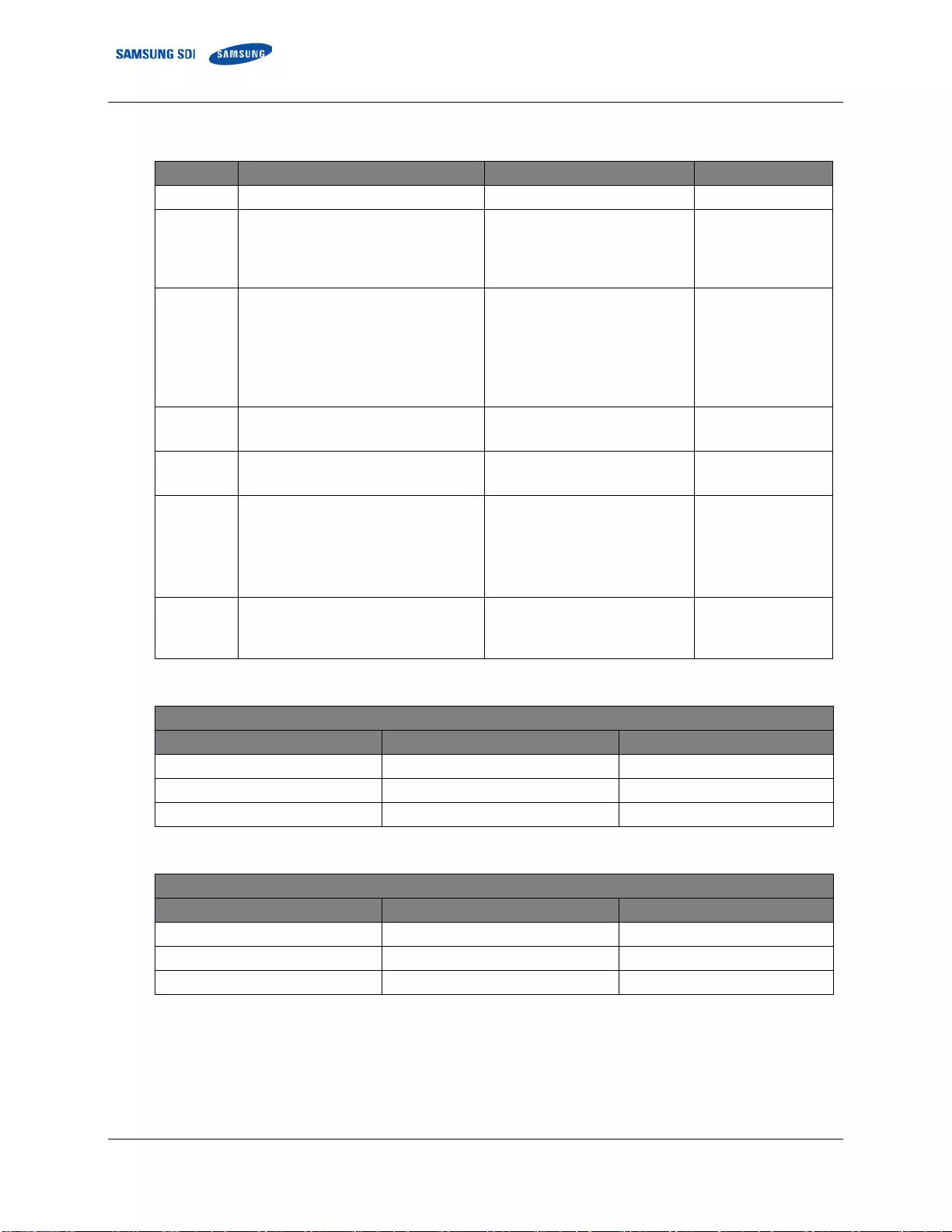
1. About this Manual
2 English 7/2020. Rev 0.41
1.4 Revision History
Rev.
Description
Author
Date
0.0
First Draft
2019.08.20
0.1
Revised module voltage check level.
SMU Auxiliary switch and SMPS Status
auxiliary contact electrical ratings added
(Table 2-1, Table 2-11)
2019.09.05
0.2
Updated Table 3-7: Recommended Tools
and Instruments
Revised Table 3-2: Parts for 80S 2P Rack
Revised 3.10.5 Busbar Installation
Revised 3.10.12.3 System BMS
Configuration
2019.12.27
0.21
Revised 3.10.5 Busbar Installation
Revised for 128S Configuration
2019.02.28
0.3
Revised for 80S configuration
Version for Schneider Electric
2020.03.27
0.4
Revised from Rev0.3
Revised Table 3-2: Parts for 80S 2P Rack
Revised Table 3-7: Recommended Tools
and Instruments
Revised 3.10.5 Busbar Installation
2020.07.01
0.41
Version for Schneider Electric end
customer
Removed confidential watermark
2020.07.01
Approved By:
Name
Signature
Date
Reviewers
Name
Signature
Date
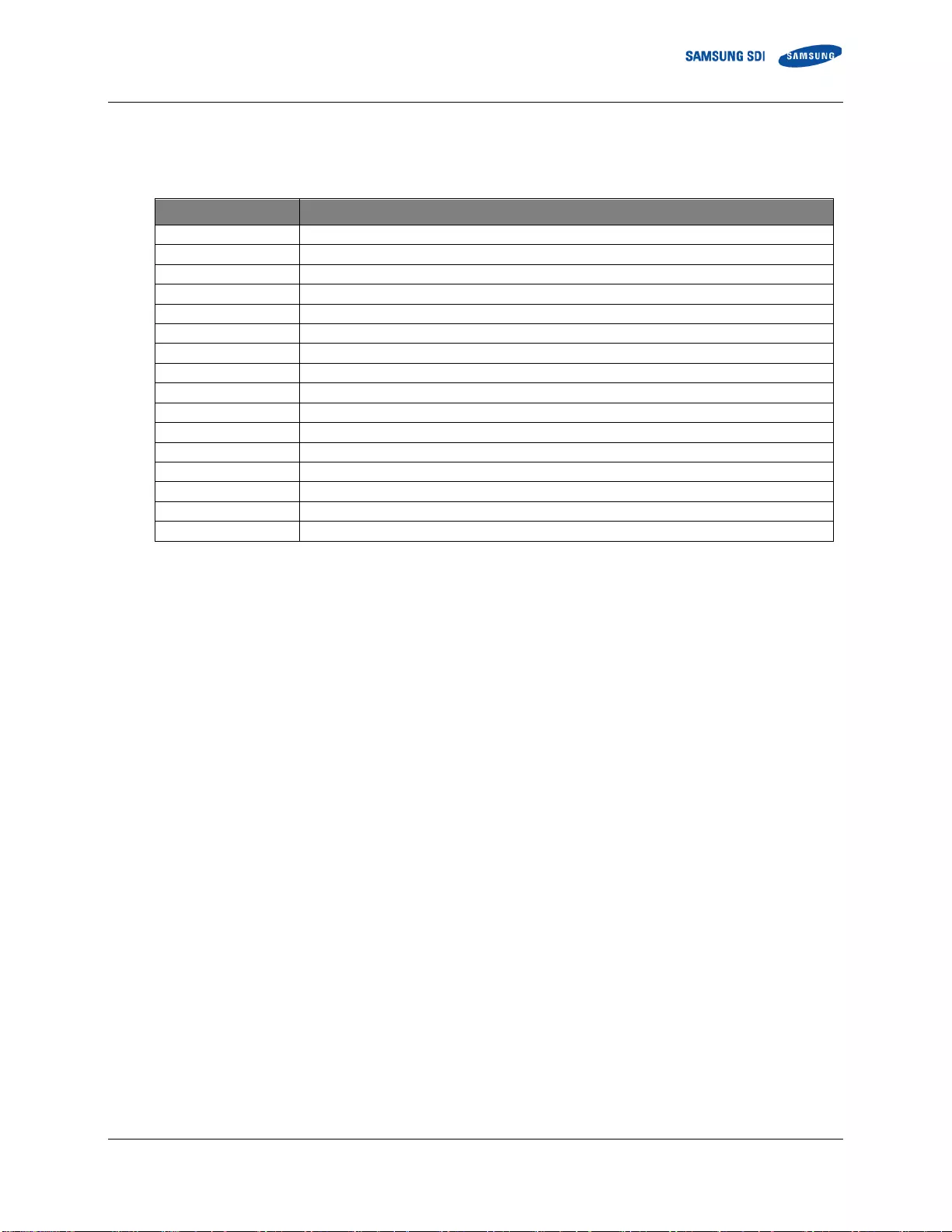
1. About this Manual
English 7/2020. Rev 0.41 3
1.5 Acronyms and Abbreviations
The following acronyms and abbreviations are used in this manual.
Abbreviations
Full Name
AED
Automated External Defibrillator
BMS
Battery Management System
EHS
Environmental Health and Safety
ESS
Energy Storage System
LOTO
LOCK OUT/TAG OUT
OT
Overtemperature
OVP
Overvoltage Protection
PCS
Power Conversion System
SMU
String Management Unit
SMPS
Switched Mode Power Supply
SOC
State Of Charge
SOH
State Of Health
SG
Switchgear
UT
Undertemperature
UVP
Undervoltage Protection
UPS
Uninterruptible Power Supply

2. Product Description
4 English 7/2020. Rev 0.41
2. Product Description
Check the components for installation. For more information, please refer to the product specification.
2.1 Major Components
This product has the following components:
Battery Module (Type A / Type B)
SMU
Rack BMS (Embedded in SMU)
Rack Frame
SMPS Assembly (Type A)
System BMS (Embedded in SMPS Assembly Type A)
Refer to the “Product Specification” document for detailed specifications of the components.
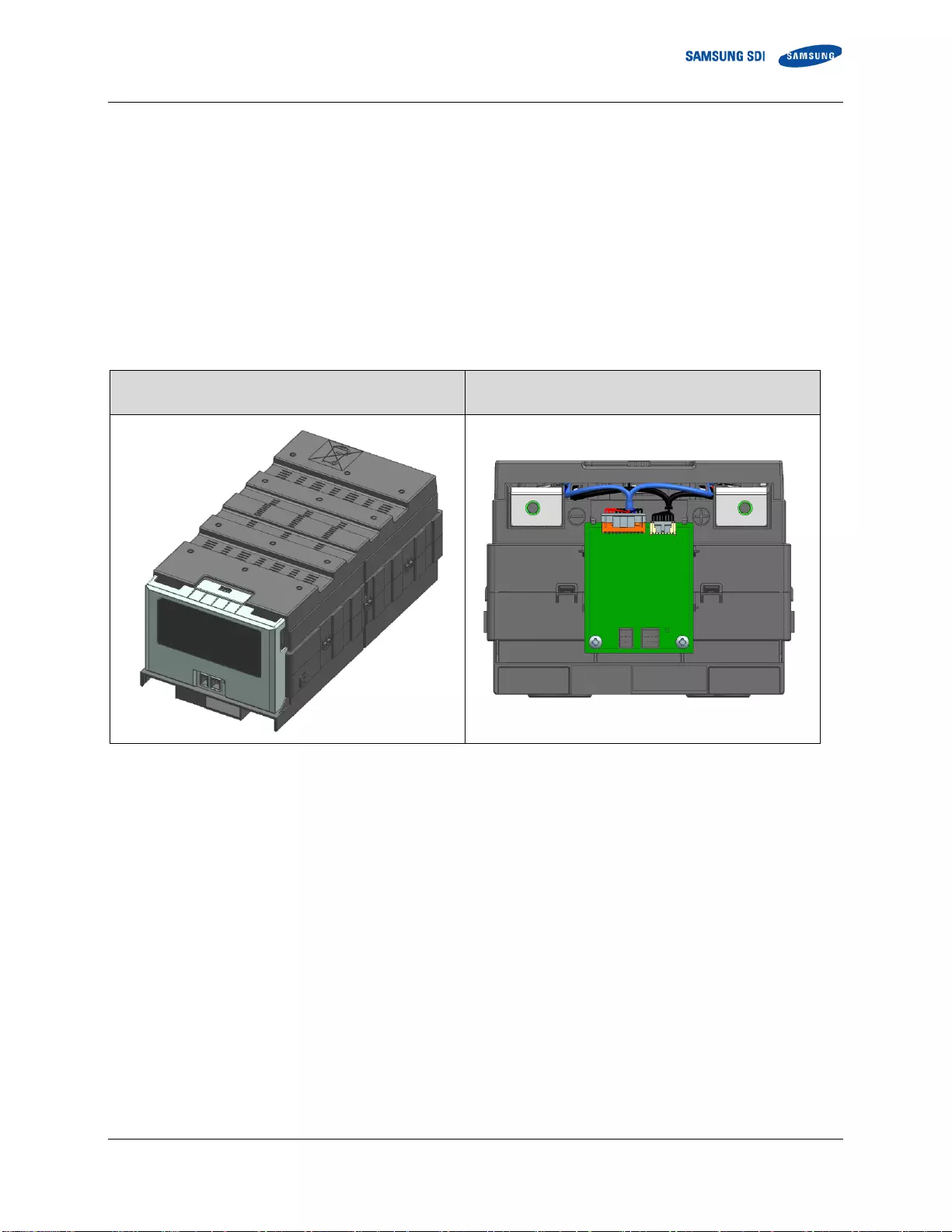
2. Product Description
English 7/2020. Rev 0.41 5
2.1.1 Battery Module (Type A / Type B)
Battery Module is the most basic component of the Battery System and it contains the energy storing battery cells.
There is a Module BMS inside each Battery Module. Module BMS checks the status of a Battery Module by
measuring its voltage and temperature. It also communicates with the SMU to send all measured voltage and
temperature data, and to receive commands to control cell balancing.
There are two types of 8S1P Battery Module depending on the position of terminal’s polarity.
Type A’s plus(+) terminal is on the right side. Type B is on the left.
Type A: EM2031AE001A
Type B: EM2031AE002A
Battery Module Type A (Isometric)
Battery Module Type A
(Front. Front cover removed)
Figure 2-1: Battery Module Type A
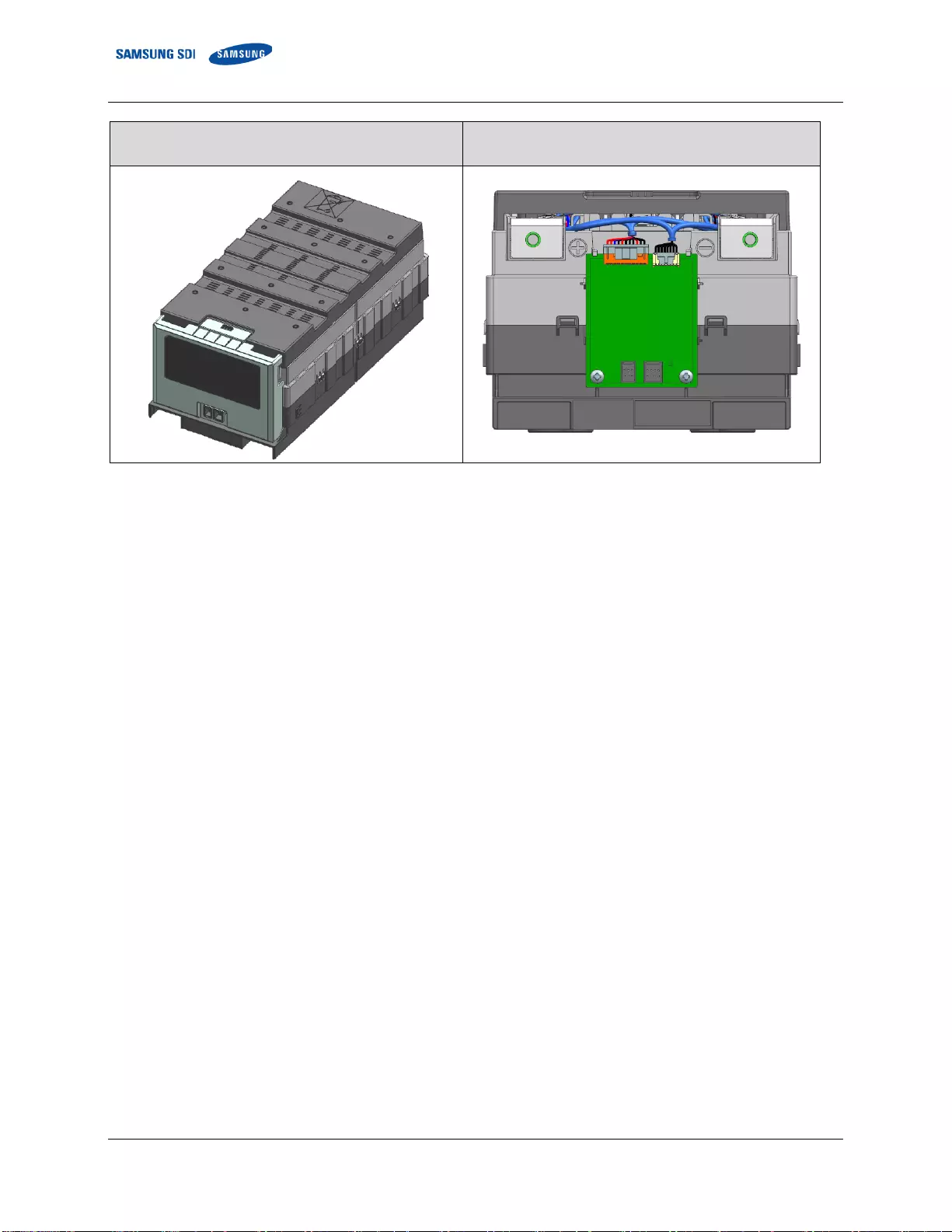
2. Product Description
6 English 7/2020. Rev 0.41
Battery Module Type B (Isometric)
Battery Module Type B
(Front. Front cover removed)
Figure 2-2: Battery Module Type B
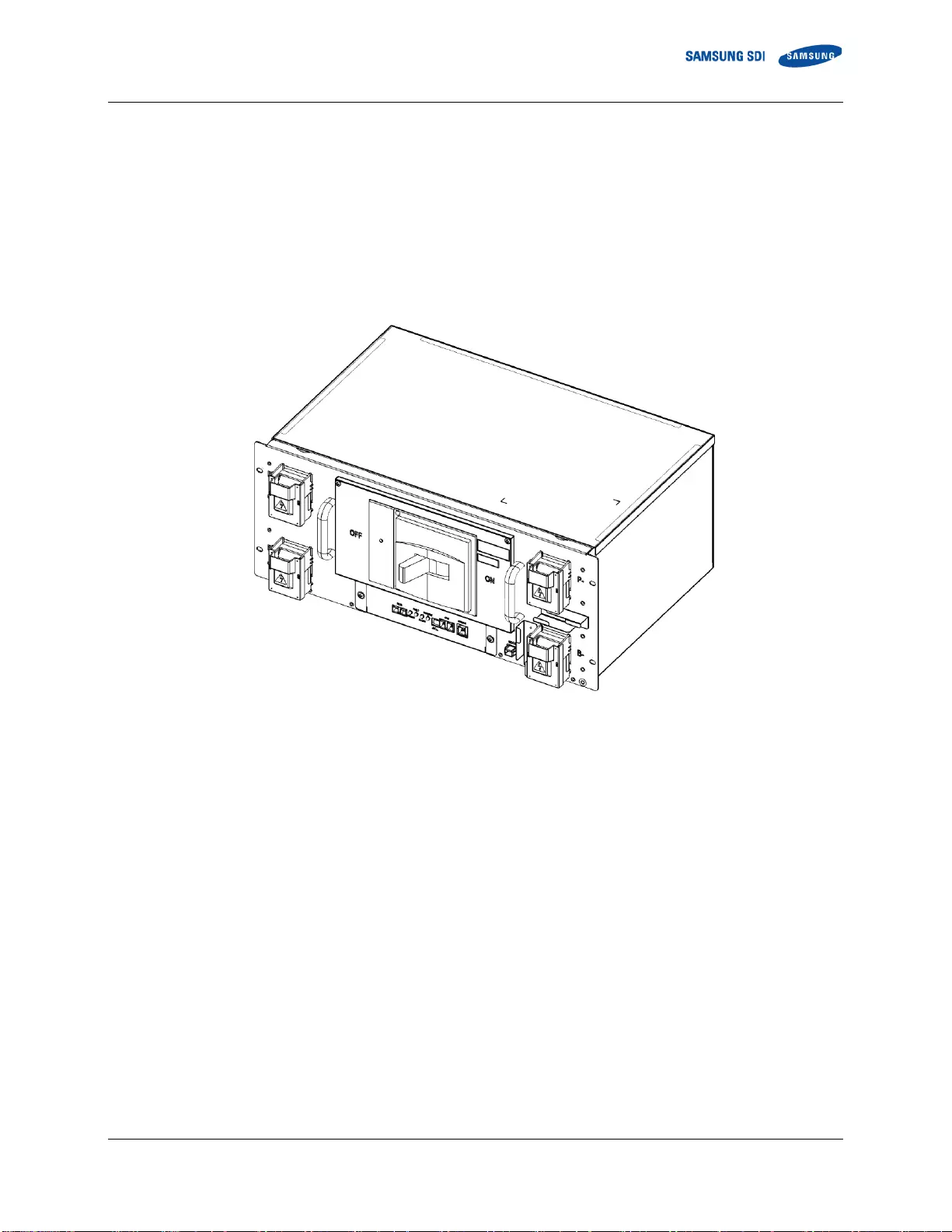
2. Product Description
English 7/2020. Rev 0.41 7
2.1.2 SMU (String Management Unit)
SMU collects all information about the battery system and controls the battery system by switching the main
power line and controls each Battery Module by cell balancing. SMU calculates the state-of-charge (SOC) and state-
of-health (SOH) of the battery system. Key components in the SMU are Rack BMS, MCCB, and shunt resistor. Rack
BMS is the main controller that takes all data from the Module BMS, measures the string voltage and current,
determines the state of the battery and controls the MCCB accordingly.
UL: V049-0011BA
Figure 2-3: SMU
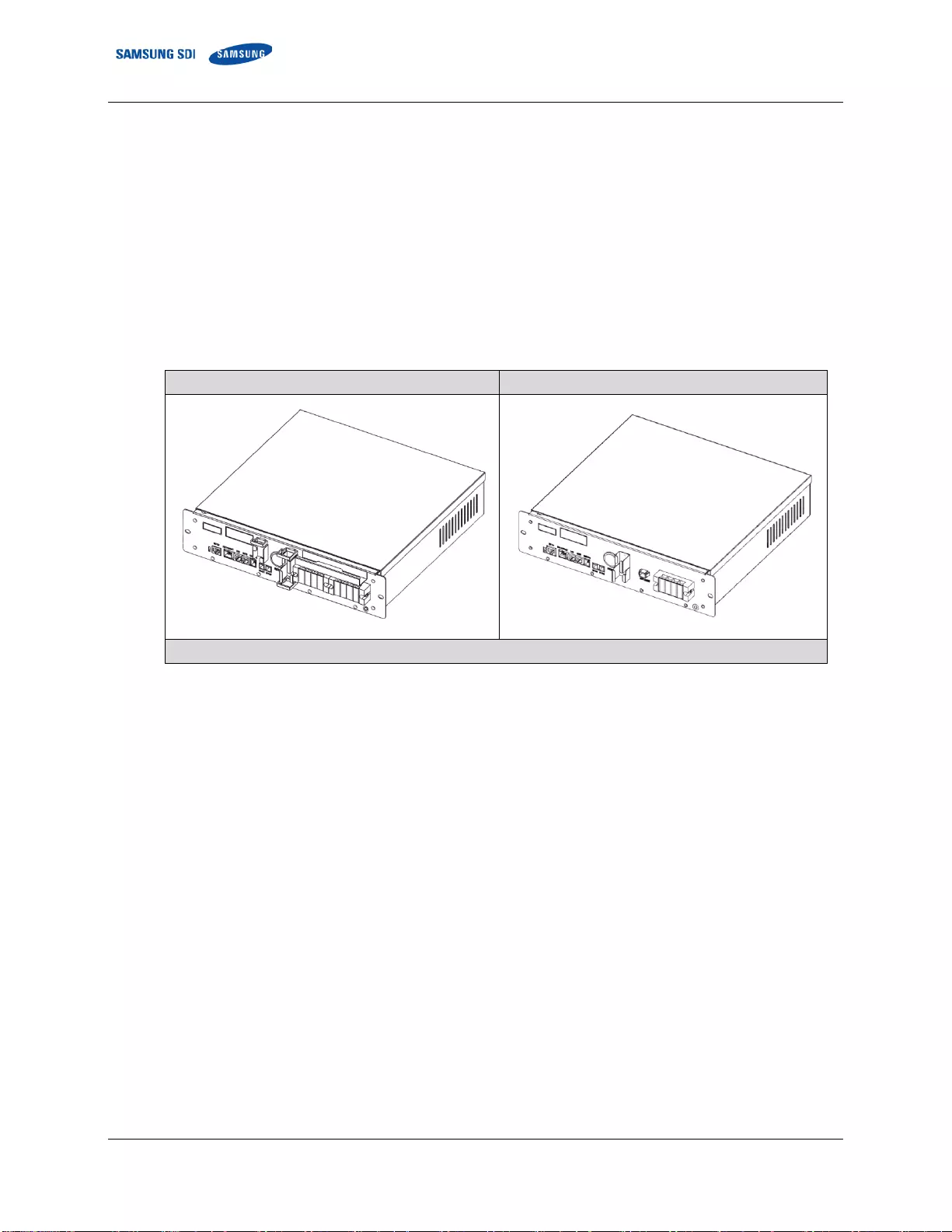
2. Product Description
8 English 7/2020. Rev 0.41
2.1.3 SMPS Assembly (Type A)
3-Phase Type A (with System BMS): V044-0006BA
1-Phase Type A (with System BMS): V044-0004BA
SMPS Assembly houses the System BMS and SMPS, which provides power to the System BMS and SMU. Two
options are available for the SMPS depending on the AC input range and cabling: 3 phase and 1 phase. The System
BMS assembly provides data to the external systems (i.e. building management system, UPS, etc.) while controlling
and monitoring all connected Rack BMS.
There are two types of SMPS Assembly: Type A is with System BMS and Type B is without System BMS.
SMPS Assembly with 3 Phase AC Input
SMPS Assembly with 1 Phase AC Input
Type A (with System BMS)
Figure 2-4: SMPS Assembly Type A
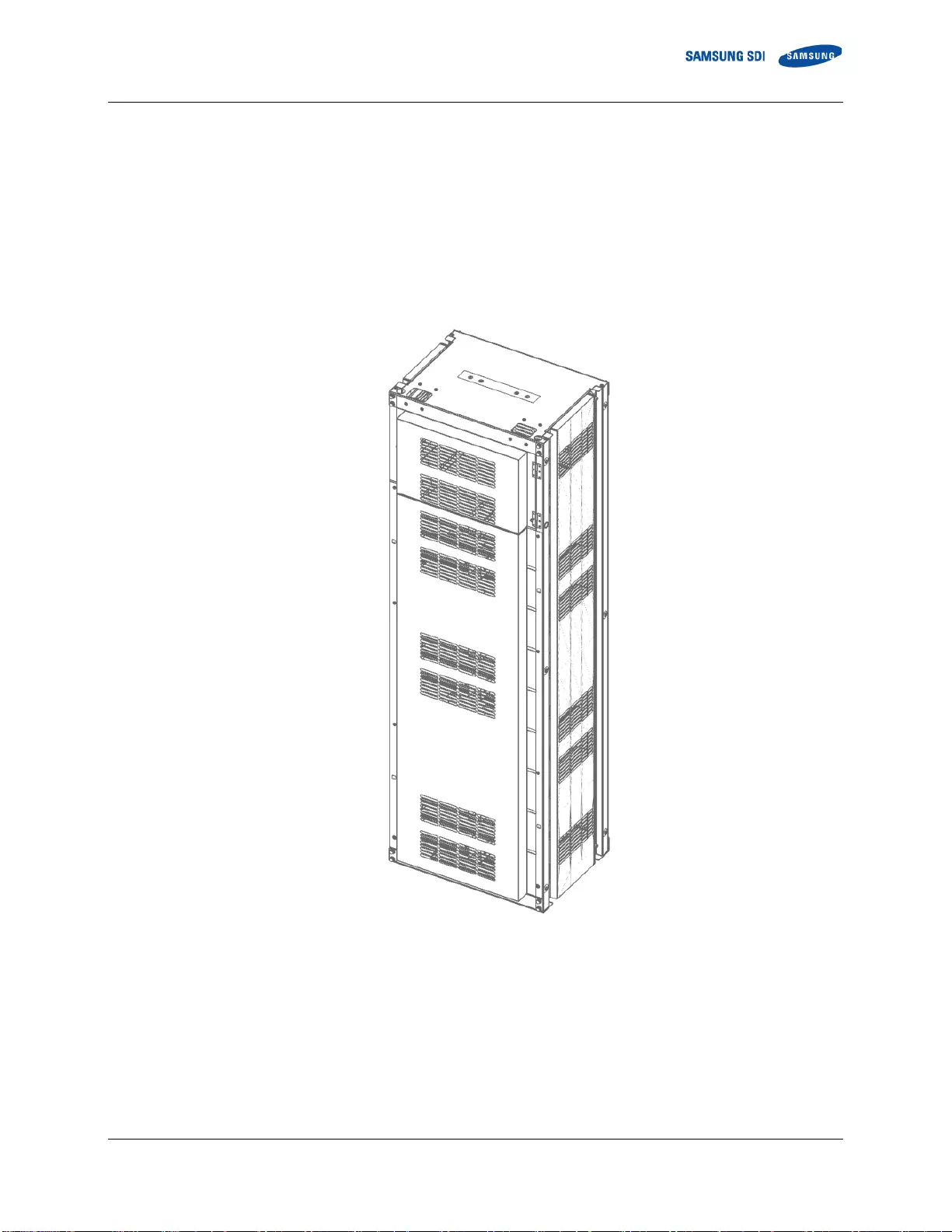
2. Product Description
English 7/2020. Rev 0.41 9
2.1.4 Rack Frame
White: V808-00066A
The Rack Frame is used to mount the modules, SMU and SMPS assembly and provides ground connections for SMU
and SMPS Assembly.
(Grounding cable/busbar for the rack frame is necessary for the SMU and SMPS Assembly as they are grounded to
the rack frame when installed. An equipment grounding conductor is required to ground the rack frames together
and to the UPS module).
Figure 2-5: Rack Frame
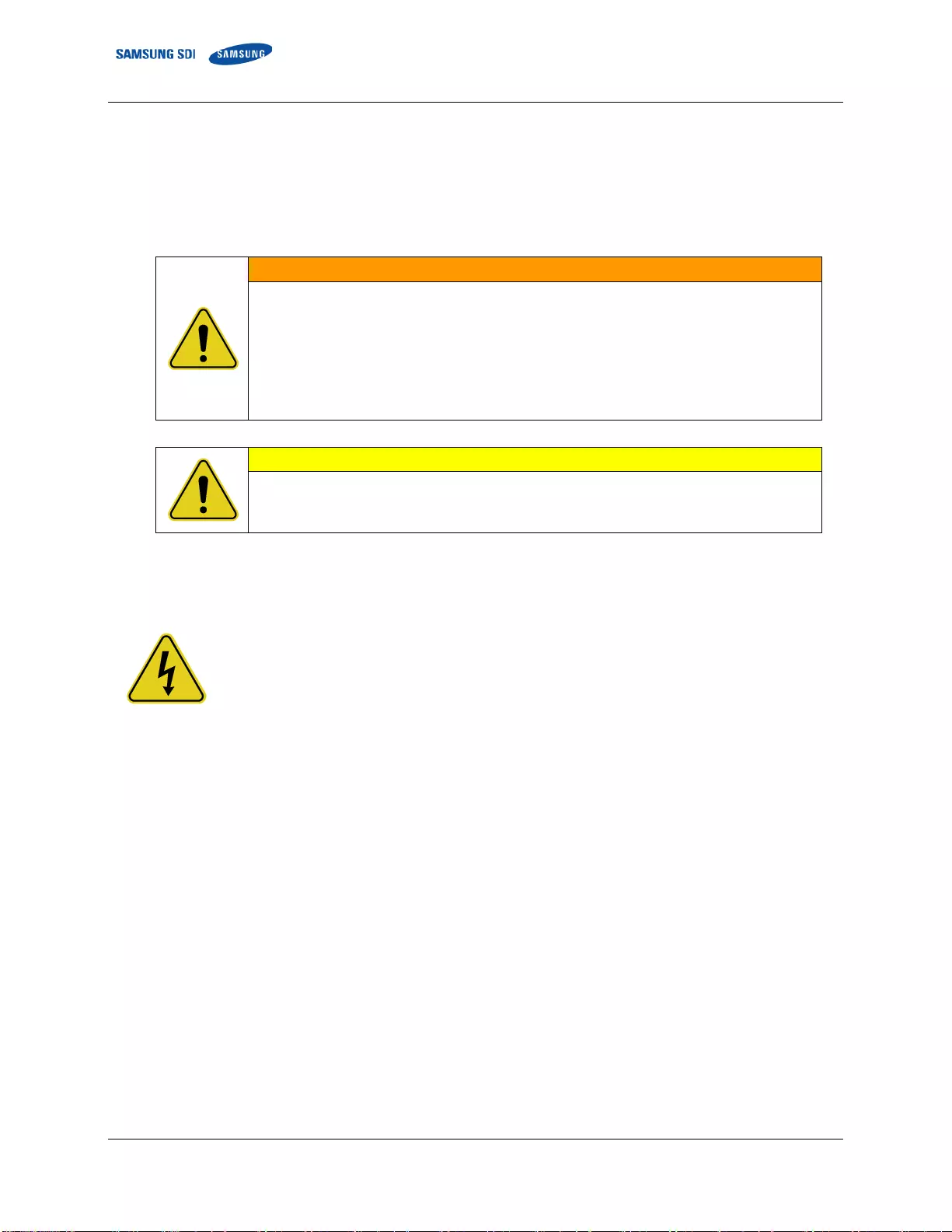
3. Installing the Product
10 English 7/2020. Rev 0.41
3. Installing the Product
Because this product has a battery with more than 300V present when fully assembled, installer must follow
the general safety instructions. This system must be installed by qualified, trained workers familiar with the
required instruments. Use appropriate lifting methods when moving the batteries.
WARNING
The power terminal cap must be left in place on the power terminal of the tray for insulation.
Be sure to use insulated tools (torque wrench, extension, socket, etc.).
All the instruments must be insulated and no metal articles (e.g. watch, ring) should be present
in the installation area.
All power switches must be turned off in advance.
Prepare a CO2 fire extinguisher, a first aid kit, and an AED (automated external defibrillator)
before installation.
CAUTION
If available, use a mechanical lift for lifting heavy (22 kg [50 lb.]) components. If there is no lift,
two or three workers must move items weighing more than 22 kg (50 lb.).
The ambient temperature range must be 23°C ±5°C during installation.
3.1 Grounding the Battery System
WARNING—SHOCK HAZARD
Verify with a voltmeter that no power is present on the system before beginning work on the battery
system or other part of the UPS system. Use lock out/tag out procedures to secure the UPS and batteries
Do not contact system connectors or terminals. Follow all applicable safety measures.
Follow all local and national codes and regulations.
Grounding methods and wiring must comply with NEC Article 250.
Grounding is required to prevent electric shock hazards and reduce or eliminate damage caused by electrical noise.
Ground connections and ground wire routing vary significantly depending on system configuration and equipment
layout. Samsung provides grounding strip on top of each rack. See Figure 3-94: Grounding Points (2 EA).

3. Installing the Product
English 7/2020. Rev 0.41 11
3.2 Arc Flash Calculations
Arc flash related calculation of the battery system is estimated with the Direct-Current Incident Energy Calculations
referenced in Informative Annex D of NFPA 70E Standard for Electrical Safety in the Workplace.
The following battery system is assumed to estimate the worst-case scenario
Battery configuration: 136S
Battery voltage: 571.2V
Battery internal resistance (AC IR): 65mohm
Arc flash related calculation based on this battery system is as follows:
Bolted fault current (Ibf ): 9000A
1/2 Bolted fault current (1/2 Ibf ): 4500A
Protective device clearing time (Tarc): 6ms
Protective device current interrupt capability (i2t): 110000A2s
Estimated DC arc flash incident energy at the maximum power point (IEm): 0.072cal/cm2

3. Installing the Product
12 English 7/2020. Rev 0.41
3.3 Installation Procedure
This product must be installed by following the procedure below:
Figure 3-1: Installation Procedure
Preparation Stage
Procedure
Unpacking
Ground Wire and Tools
Recommended Tools/Instruments
Appearance Inspection
Rack Anchoring Stage
Transport the rack frame to the installation location after unpacking
Arrange the rack frame after checking the positions of holes in the frame and anchoring points
Perform the anchoring and ground connections
Rack Installation Stage
Transport the battery modules to the installation location
Insert the SMU in the rack frame
Insert the SMPS Assembly in the rack frame
After all components are inserted in the rack frame, attach them to the rack frame
Place the battery modules in the rack frame
Connect the busbars
Connect the signal cables from SMU to module, and module to module
Connect the signal cables from SMU to SMU
System Installation Stage
Connect the SMPS Assembly to AC power source
Prepare the items for BMS configuration
Configure the BMS
Perform installation checks
Estimated time for each step is listed below.
1. Preparation
Stage 2. Rack Anchoring
Stage 3. Rack
Installation
Stage 4. System
Installation Stage
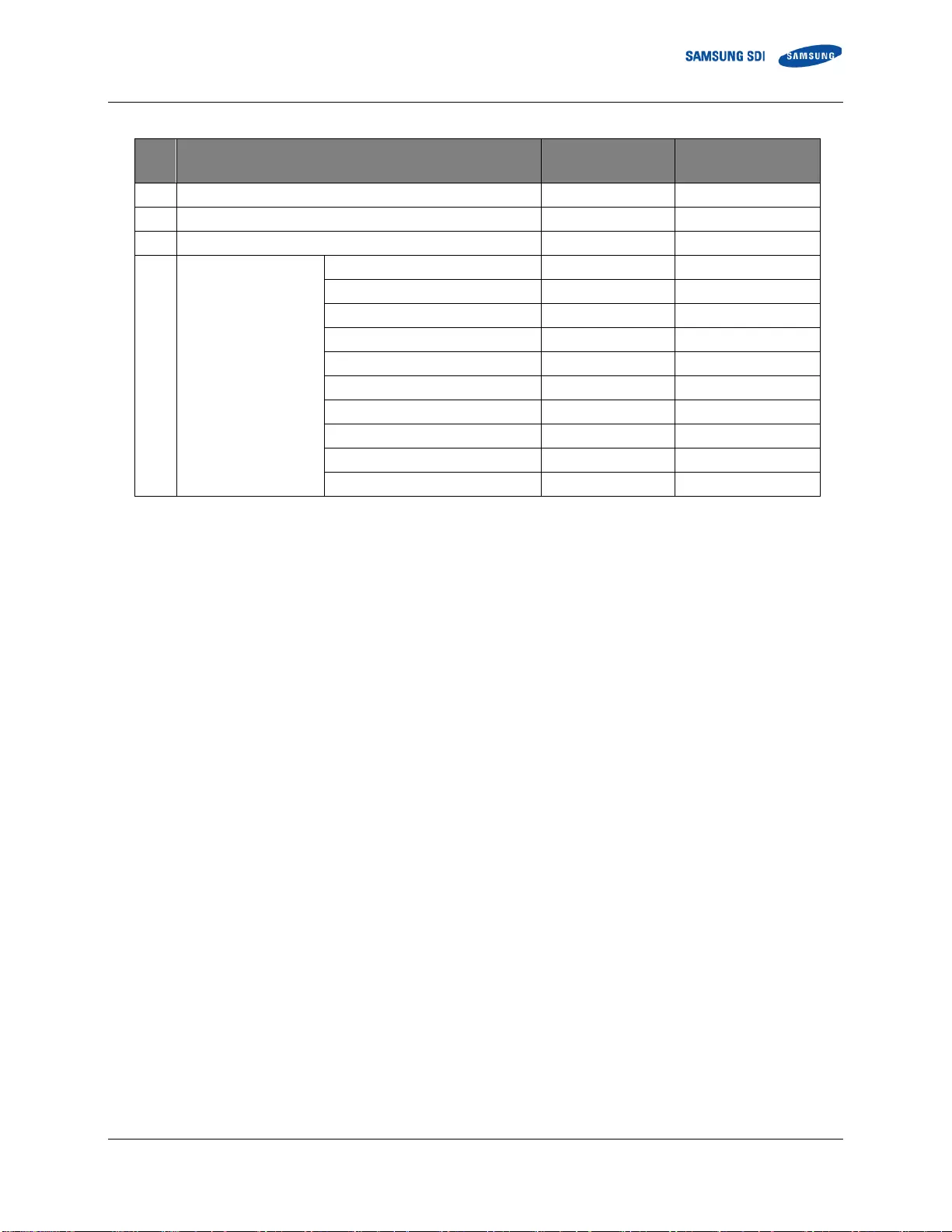
3. Installing the Product
English 7/2020. Rev 0.41 13
Table 3-1: Estimated time for installation (based on 136S 3P installation)
No.
Step
Estimated Time
(HH:MM)
Aggregated Time
(HH:MM)
1
Unpacking
00:30
00:30
2
Inspection
01:00
01:30
3
Rack Anchoring
04:00
05:30
4
Rack Installation
Battery Module
00:20
05:50
SMU
00:10
06:00
SMPS Assembly
00:10
06:10
Rack Fuse Assembly
00:30
06:40
Busbar
01:00
07:40
Signal Cables
00:20
08:00
Power and Control Cables
00:20
08:20
AC Input Installation
00:20
08:40
Cable Installation
00:10
08:50
BMS Configuration
00:10
09:00
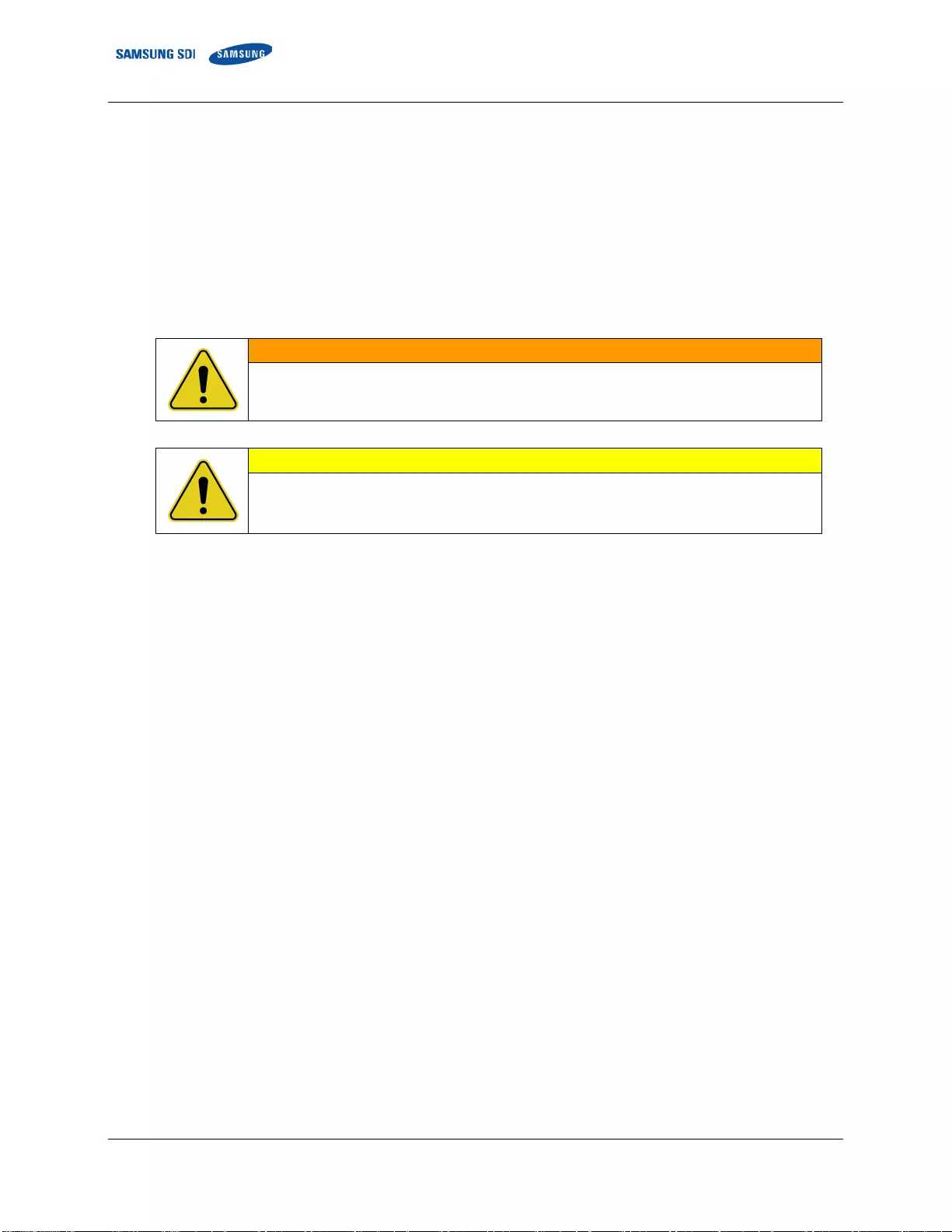
3. Installing the Product
14 English 7/2020. Rev 0.41
3.4 Preparation Stage—Procedure
For the preparation stage, perform the following steps:
1. Create the installation plan and check the equipment and instruments for installation.
2. Check the arrival schedule of the parts required.
3. Unpack the equipment.
4. Inspect the equipment.
WARNING
Do not wear watches, rings, jewelry, or any other metal objects.
Wear electrically insulated gloves and safety shoes.
CAUTION
Store the product in a dust-free place with the moisture level of below 60% and the
temperature level of 23°C ±5°C.
Keep components out of direct sunlight.
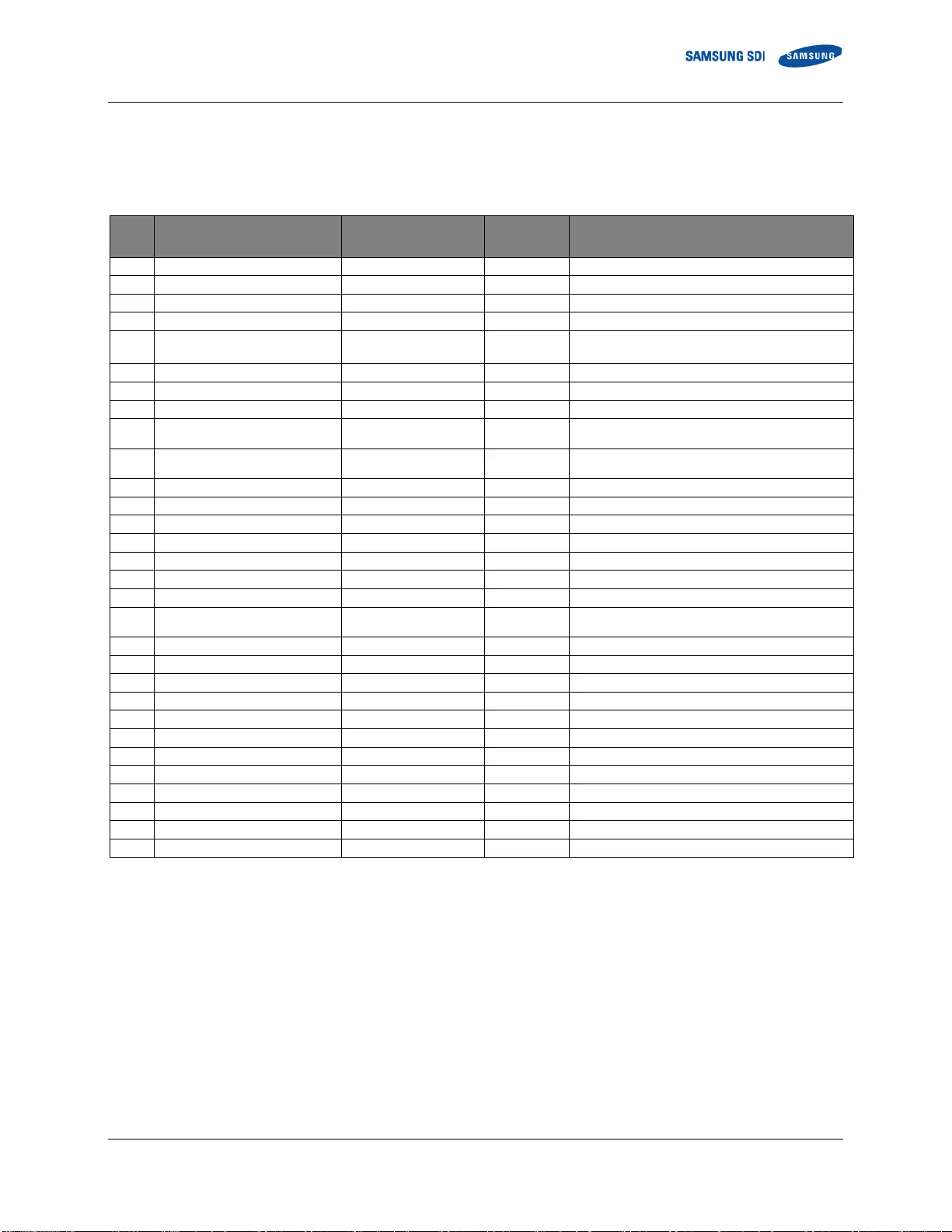
3. Installing the Product
English 7/2020. Rev 0.41 15
3.5 Preparation Stage—Unpacking
Check the following parts during unpacking:
Table 3-2: Parts for 80S 2P Rack
No.
Items
Part No.
Amount
(Unit: EA)
Remarks
1
RACK FRAME
V808-00066A
2
V808-00066A: White, UL
2
BATTERY MODULE Type A
EM2031AE001A
8
3
BATTERY MODULE Type B
EM2031AE002A
12
4
SMU
V049-0011BA
2
5
SMPS ASSEMBLY Type A
(WITH SYSTEM BMS ASSEMBLY)
V044-0004BA (1 Phase)
V044-0006BA (3 phase)
2
6
BUSBAR M TO SMU
V050-00051A
4
Connect modules and SMU
7
BUS-BAR MAIN
SJ66-00863A
12
High current bus bar connection for modules
8
BUSBAR_80S
V050-00052A
2
Connect between modules #3 and #4
9
FUSE
3601-001835
4
Connect between modules #3 and #4,
and between modules #9 and #10
10
FUSE COVER #2
V143-00002A
8
Fuse cover for fuse between modules #3 and #4,
and between modules #9and #10
11
FUSE BUSBAR LEFT UPPER
V050-00002A
2
Connect between modules #9and #10
12
FUSE BUSBAR LEFT LOWER
V050-00001A
2
Connect between modules #9and #10
13
FUSE BUSBAR RIGHT UPPER
V050-00003A
2
Connect between modules #3and #4
14
FUSE BUSBAR RIGHT LOWER
V050-00004A
2
Connect between modules #3and #4
15
WIRE ASSY RACK TO MODULE
V046-0005BA
2
Connect Battery Module #1 and SMU.
16
WIRE ASSY MODULE TO MODULE #1
SJ39-00673A
16
Signal Connection for Modules
17
WIRE ASSY RACK TO RACK #2
SJ39-00674A
1
Connect Rack between #1 and #2
18
WIRE ASSY RACK TO SYSTEM
SJ39-00719A
1
Connect the Rack BMS CAN connector in the SMU to the System BMS
CAN connector in the SMPS ASSEMBLY.
19
WIRE ASSY RACK TO SMPS
SJ39-00718A
4
Connect the Rack BMS DC IN to SMPS ASSEMBLY DC OUT
20
WIRE ASSY MODULE TO MODULE #2
SJ39-00678A
2
Signal connection between modules #5and #6
21
WIRE ASSY EARTH
SJ39-00725A
4
Connecting SMPS Assembly and SMU to Rack Frame.
22
SCREW M5 X 10
SJ60-00068A
20
Mounting SMU, SMPS, and WIRE ASSY EARTH to Rack Frame
23
SCREW M8 X 18
V701-00089A
40
Mounting Busbar to Module
24
SCREW M12 X 25
SJ60-00138A
8
Mounting Busbar to Switchgrear
25
SCREW M12 X 16
SJ60-00137A
8
Mounting Fuse Busbar to Fuse
26
SCREW M10 X 25
SJ60-00082A
8
Mounting Rack Frame to Rack Frame side by side
27
NUT M10
SJ81-01208A
8
Mounting Rack Frame to Rack Frame side by side
28
M10 FLAT WASHER
SJ60-00073A
8
Mounting Rack Frame to Rack Frame side by side
29
WIRE ASSY MCCB AUX
SJ39-00807A
2
Connect to MCCB Aux Contact
30
WIRE ASSY DRY CONTACT
SJ39-00808A
1
Connect to SMPS Assembly DRY CONTACT
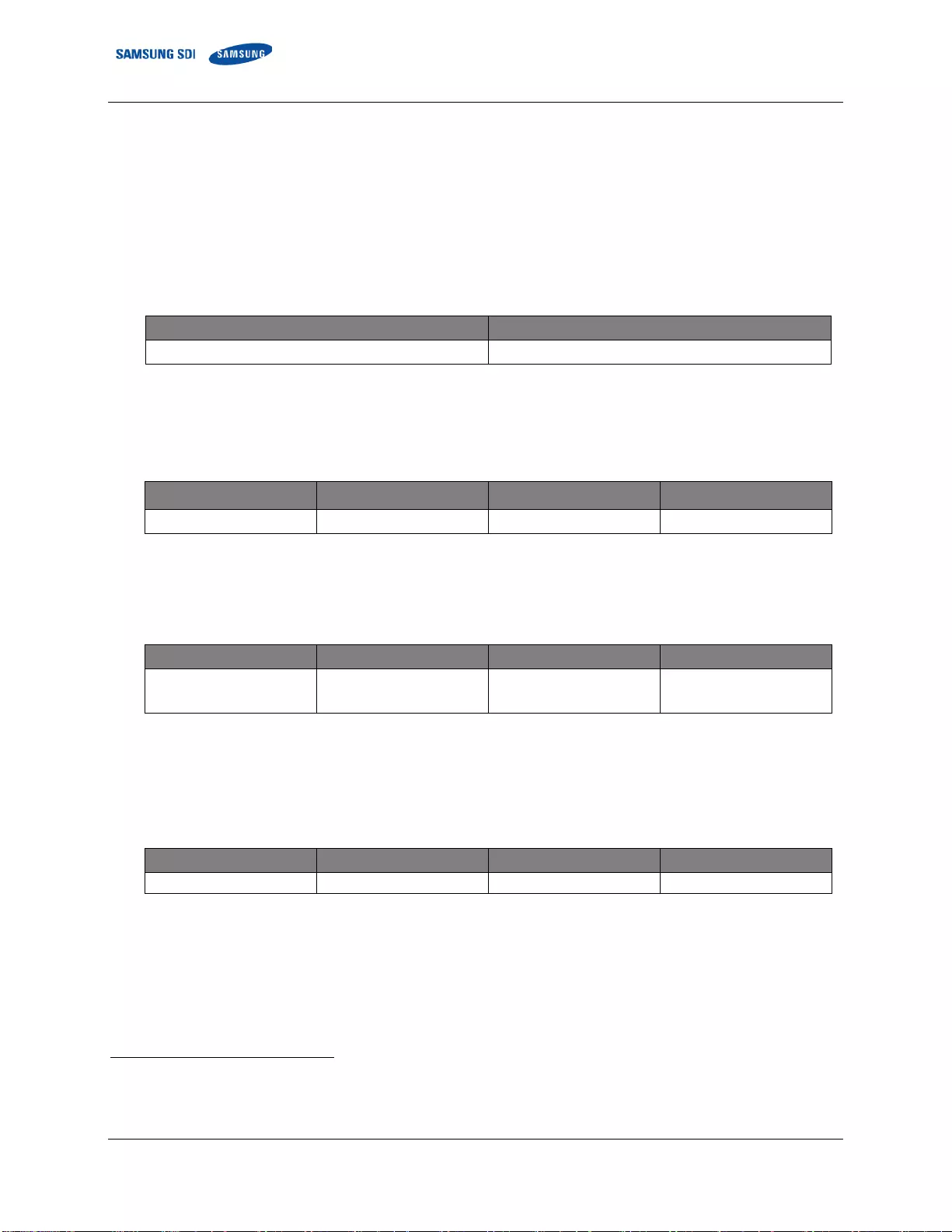
3. Installing the Product
16 English 7/2020. Rev 0.41
3.6 Preparation Stage—Ground Wire and Tools
Ground wires for the racks must be provided by the installer. Installer-supplied ground wires must meet the
specifications below.
Refer to 3.1 Grounding the Battery System for details on grounding.
3.6.1 Ground Wires
Use ground wire that is 70 sq mm. The ground wire specifications are:
Table 3-3: Ground Wire Specifications
1
Wire No.
Terminal Type
70 sq mm or thicker
M12 2 Hole Ring Terminal
3.6.2 Ground Wire Fasteners
Specifications for the ground wire fastening screws are:
Table 3-4: Ground Wire Fastener Specification
2
Size
Hardness
Thread Pitch
Material
M12–30L
70 (Grade 7)
1.25 mm (0.05 in)
SS304
3.6.3 Rack Fasteners (Anchors)
Specifications for the rack fastener screws for anchoring the rack frame to the floor are:
Table 3-5: Rack Fastener Specifications
3
Size
Hardness
Thread Pitch
Material
M16–L
(Bottom Anchor)
70 (Grade 7)
2.0 mm (0.08 in)
SS304
3.6.4 Multiple Rack Fasteners
Rack fasteners are factory-provided. Refer to Table 3-2: Parts for 80S 2P Rack for part number and quantities.
Specifications for the rack fastener screws for installing multiple rack frames side-by-side are:
Table 3-6: Rack Fastener Specifications (Side by side)
Size
Hardness
Thread Pitch
Material
M10–25L (Side)
70 (Grade 7)
1.5 mm (0.06 in)
SS304
1
Not provided. Must be provided by the installer or customer.
2
Not provided. Must be provided by the installer or customer.
3
Not provided. Must be provided by the installer or customer.
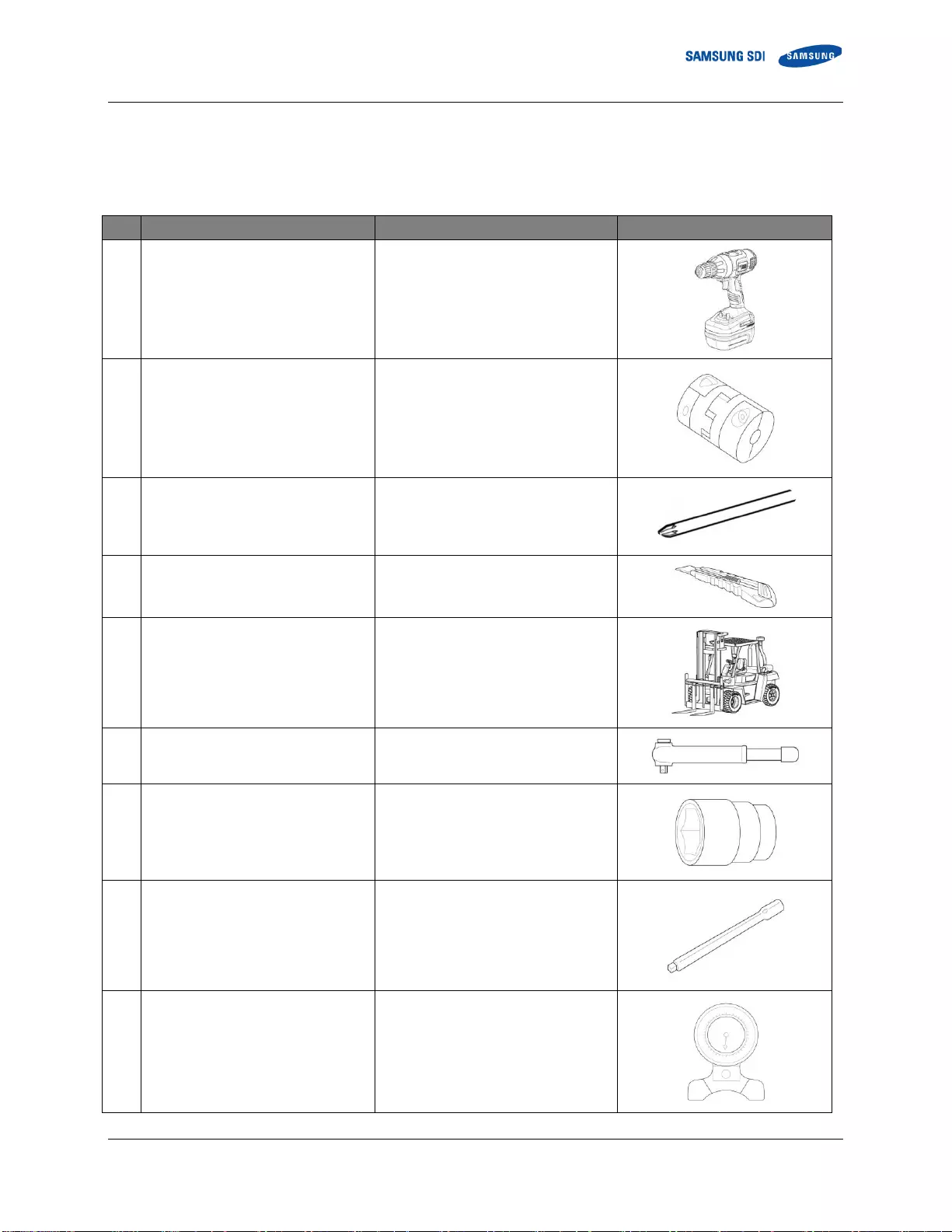
3. Installing the Product
English 7/2020. Rev 0.41 17
3.7 Preparation Stage—Recommended Tools/Instruments
Installers must provide these tools for installing the battery:
Table 3-7: Recommended Tools and Instruments
No.
Items
Usage
Appearance
1
Power Screwdriver/Drill
(Max torque: 26Nm/270 kgf/cm)
To fasten SMU and SMPS assemblies to
the rack frames
(5.1–6.1Nm/50–60 kgf/cm)
2
Torque Limiter
For use with torque wrench
3
Phillips Screwdriver or Bit
To fasten SMU and SMPS assemblies to
the rack frames
(M5 Tip)
4
Box Cutter
Opening boxes
5
Forklift
Moving rack frames and pallets
containing modules and SMU
6
Insulated Torque Wrench
Installing a high-current cable
(10~50 N.m / 100 ~ 500 kgf.cm)
7
Insulated Sockets
(13 mm, 17mm and 19mm)
Installing power cables and busbars
8
Insulated Extension for Socket
Installing a power cable
9
Inclinometer/Level
Installing a rack frame
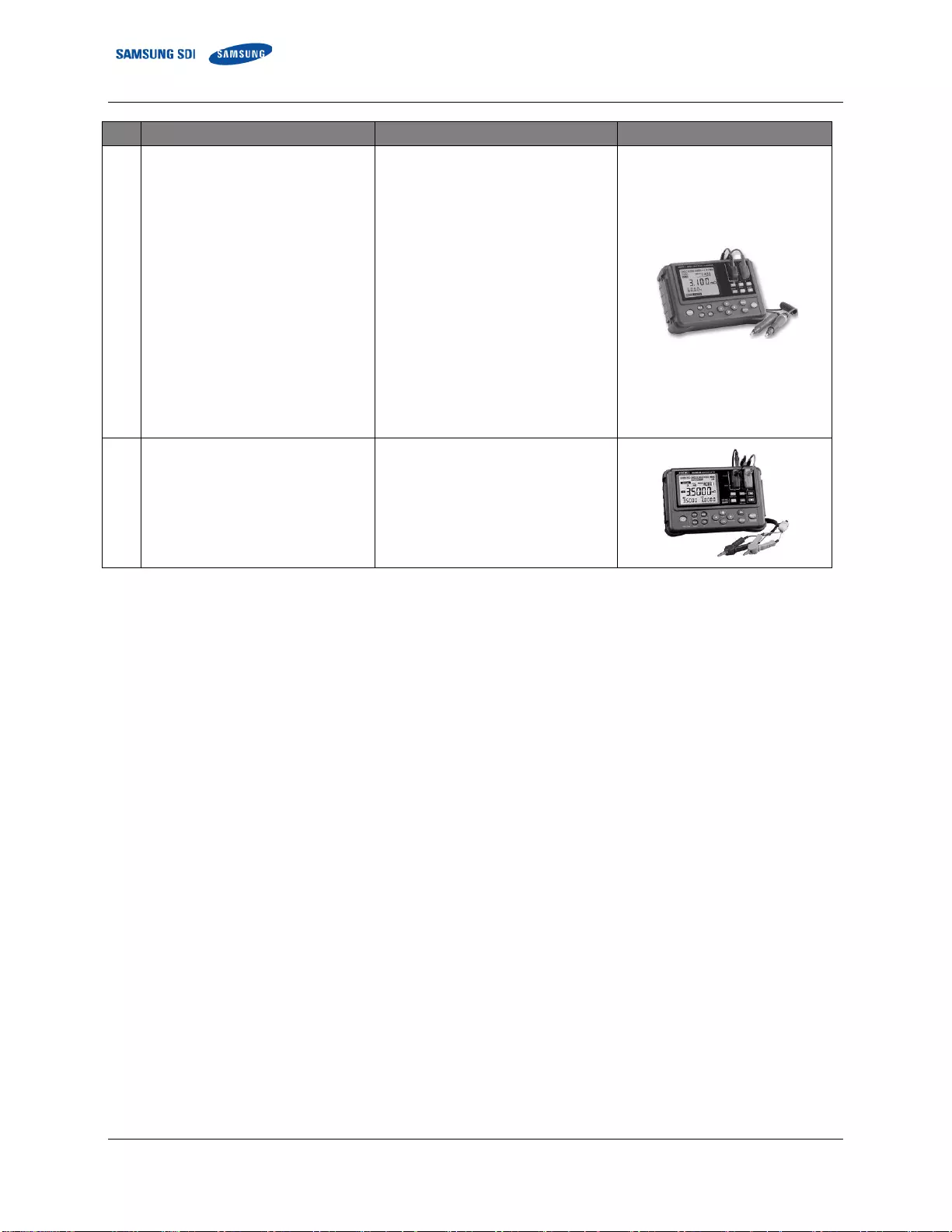
3. Installing the Product
18 English 7/2020. Rev 0.41
No.
Items
Usage
Appearance
10
Battery Tester
Measure battery module’s voltage and
internal impedance
Hioki BT3554, Fluke BT521 or meters
with the same or better voltage and
resistance measurement resolution and
accuracy is recommended.
- Voltage resolution: 1mV
- Voltage accuracy: ±0.1% of reading
- Resistance resolution: 0.001mΩ
- Resistance accuracy: ±1% of reading
Battery tester may be used to measure
the contact resistance between bus bar
and the joining terminal if a dedicated
resistance meter is unavailable.
11
Resistance Meter
Measure the contact resistance
between bus bar and the joining
terminal
(Hioki RM3548 or meters with the
same or better resistance
measurement accuracy is
recommended)
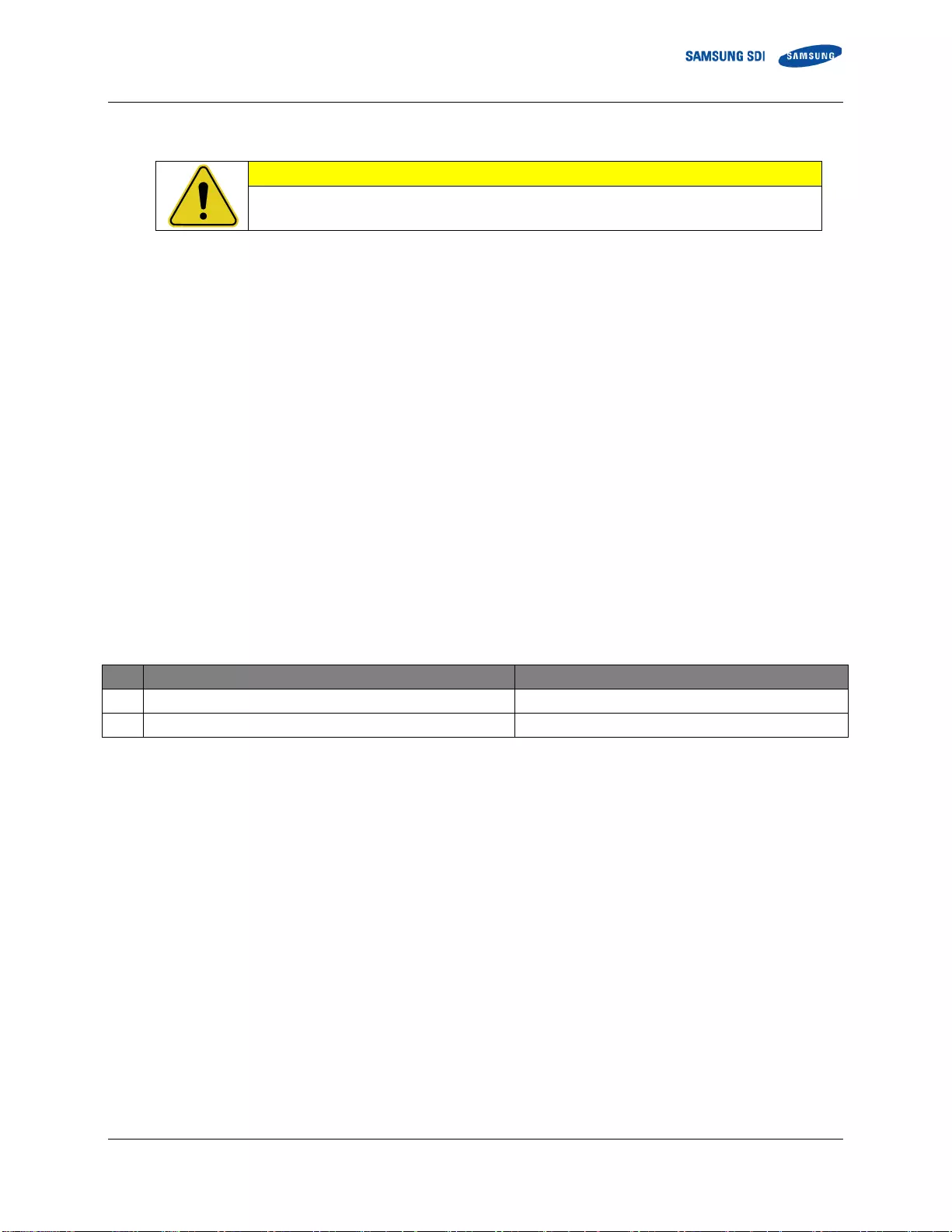
3. Installing the Product
English 7/2020. Rev 0.41 19
3.8 Preparation Stage—Visual Inspection
CAUTION
If any defects are found during the inspection, contact the SAMSUNG SDI customer service
department.
3.8.1 Inspection of the Rack Frame
After transporting the rack frame to the installation location, check for:
Structural damage
Paint peeling
Damaged or protruding screws.
After completion, install or package the rack for protection during storage.
3.8.2 Inspection of the Modules
After transporting the modules to the installation location, check for:
Physical damage to the exterior
Damaged or protruding screws
Proper voltage and internal impedance of the battery modules using the battery tester.
Table 3-8: Module Voltage and Internal Impedance
No.
Items
Value
1
Voltage Check
28.080 ~ 29.104V
2
Internal Impedance Check
3.0 ~ 4.3 mΩ
After completion, install the battery module in the previously installed rack or return the battery module to
its original packing for protection during storage.
3.8.3 Inspecting the SMU
After transporting the SMU to its installation location, check for:
Physical damage
Paint peeling
Damaged or protruding screws.
After completion, install the SMU in the previously installed rack or return the SMU to its original packing for
protection during storage.

3. Installing the Product
20 English 7/2020. Rev 0.41
3.8.4 Inspecting the SMPS assembly
After transporting the SMPS Assembly to its installation location, check for:
Physical damage
Paint peeling
Damaged or protruding screws.
After completion, install the SMPS in the previously installed rack or return the SMPS to its original packing
for protection during storage.
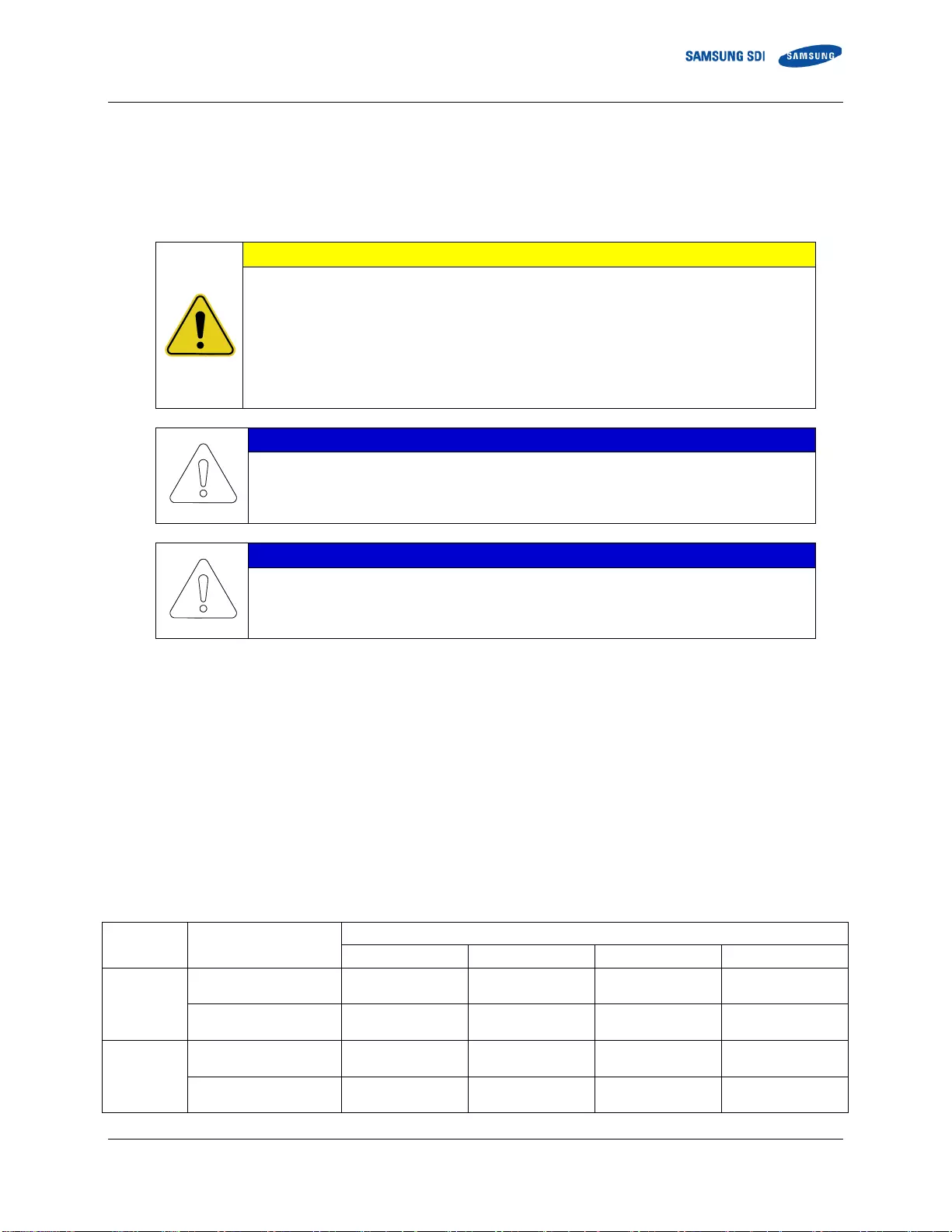
3. Installing the Product
English 7/2020. Rev 0.41 21
3.9 Rack Anchoring Stage
Install the rack frame on a flat, level surface.
To attach the rack and perform the related works
CAUTION
Use a proper transportation method considering the weight of the rack frame.
Ensure that the safety of the working place is maintained.
When using a forklift, lift the rack frame from the front.
When a forklift cannot be used, use a mechanical lift or move it by hand with three or more
people.
Use lock washers to prevent bolts from loosening.
Use an inclinometer or carpenter’s level to ensure that the rack frame is plumb.
NOTICE
Failure to anchor the rack frame on a flat and level surface may distort the rack frame after
installing the racks side-by-side.
Frame distortion may make the rack doors difficult or impossible to open.
NOTICE
In seismically active areas, the front panel and the rear panel of the rack frame must be
installed.
In order to anchor the racks in all four points, racks are recommended to be placed according to the workable
distances listed in the table below. In seismically active areas, all four anchor points of the rack must be installed.
To reduce the product footprint, the racks can be installed side-by-side and rear-to-rear against a wall or next to
another rack. In this case, only two anchor points on the front side of each rack can be installed. Proper cooling and
ventilation of the installed area is recommended for racks installed with no side and rear clearance. Front side of
the rack must be cleared for installation, maintenance, service access, and ventilation and cooling.
Clearance from the top of the rack frame is not required and the top of the rack frame can be covered to prevent
any foreign objects from falling into the battery rack frame.
Table 3-9: Rack Clearance Distances
Configuration
Anchor points per rack
Clearance Distance (mm)
Side (end)
Side (adjacent)
Rear
Front
Single Rack
2 (Front)
not rated for seismic event
0
n/a
0
Workable distance
(1000 recommended)
4 (All) – Telcordia Zone 4
Workable distance
(800 recommended)
n/a
Workable distance
(800 recommended)
Workable distance
(1000 recommended)
Multiple Racks
(Side-to-Side)
2 (Front)
not rated for seismic event
0
0
0
Workable distance
(1000 recommended)
4 (All) – Telcordia Zone 4
Workable distance
(800 recommended)
0
Workable distance
(800 recommended)
Workable distance
(1000 recommended)
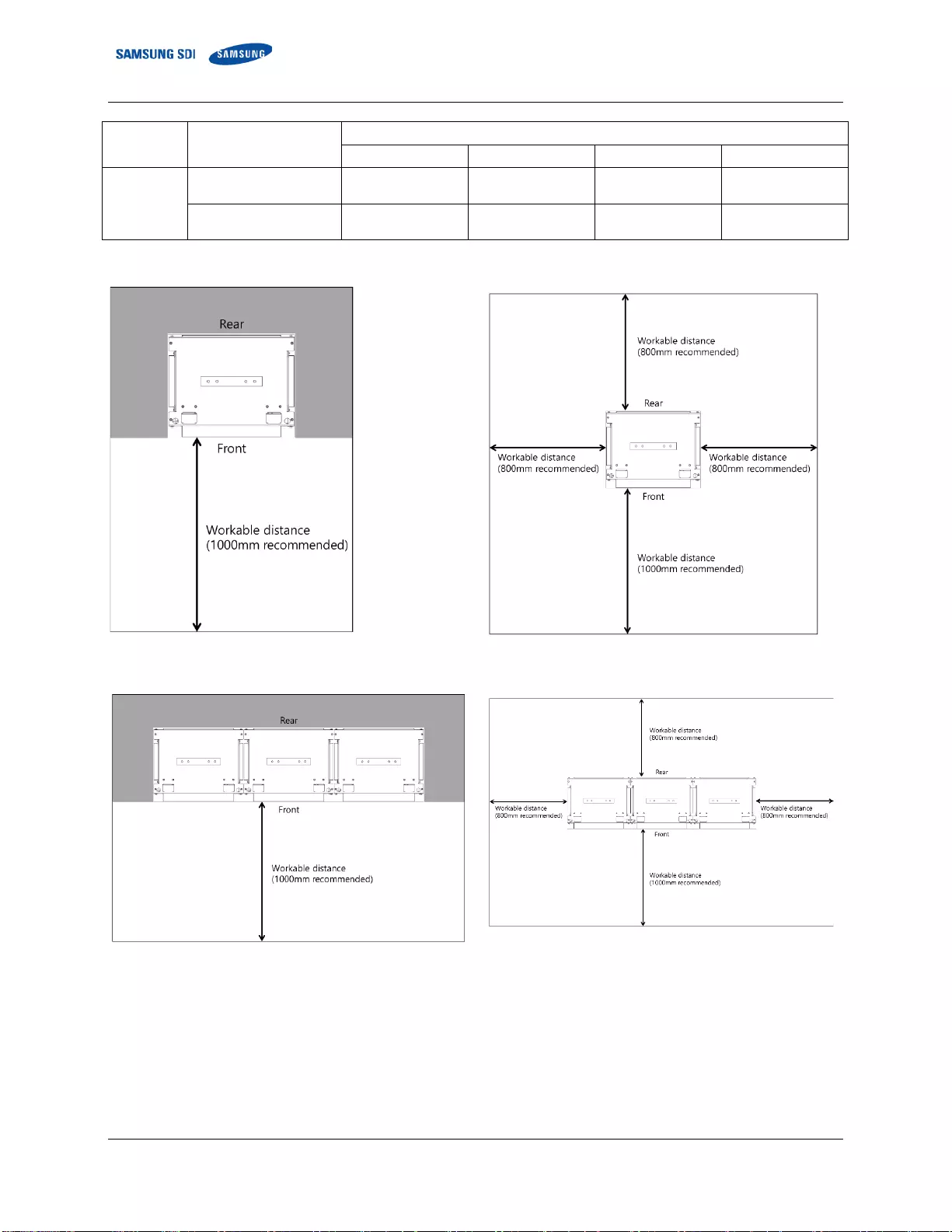
3. Installing the Product
22 English 7/2020. Rev 0.41
Configuration
Anchor points per rack
Clearance Distance (mm)
Side (end)
Side (adjacent)
Rear
Front
Multiple Racks
(Side-to-Side
and Rear-to-
Rear)
2 (Front)
not rated for seismic event
0
0
0
Workable distance
(1000 recommended)
4 (All) – Telcordia Zone 4
Workable distance
(800 recommended)
0
Workable distance
(800 recommended)
Workable distance
(1000 recommended)
Two anchor points (not rated for seismic event)
Four anchor points (Telcordia Zone 4)
Figure 3-2: Clearance Distance for Single Rack Frame
Two anchor points (not rated for seismic event)
Four anchor points (Telcordia Zone 4)
Figure 3-3: Clearance Distance for Multiple Rack Frames Installed Side-by-Side
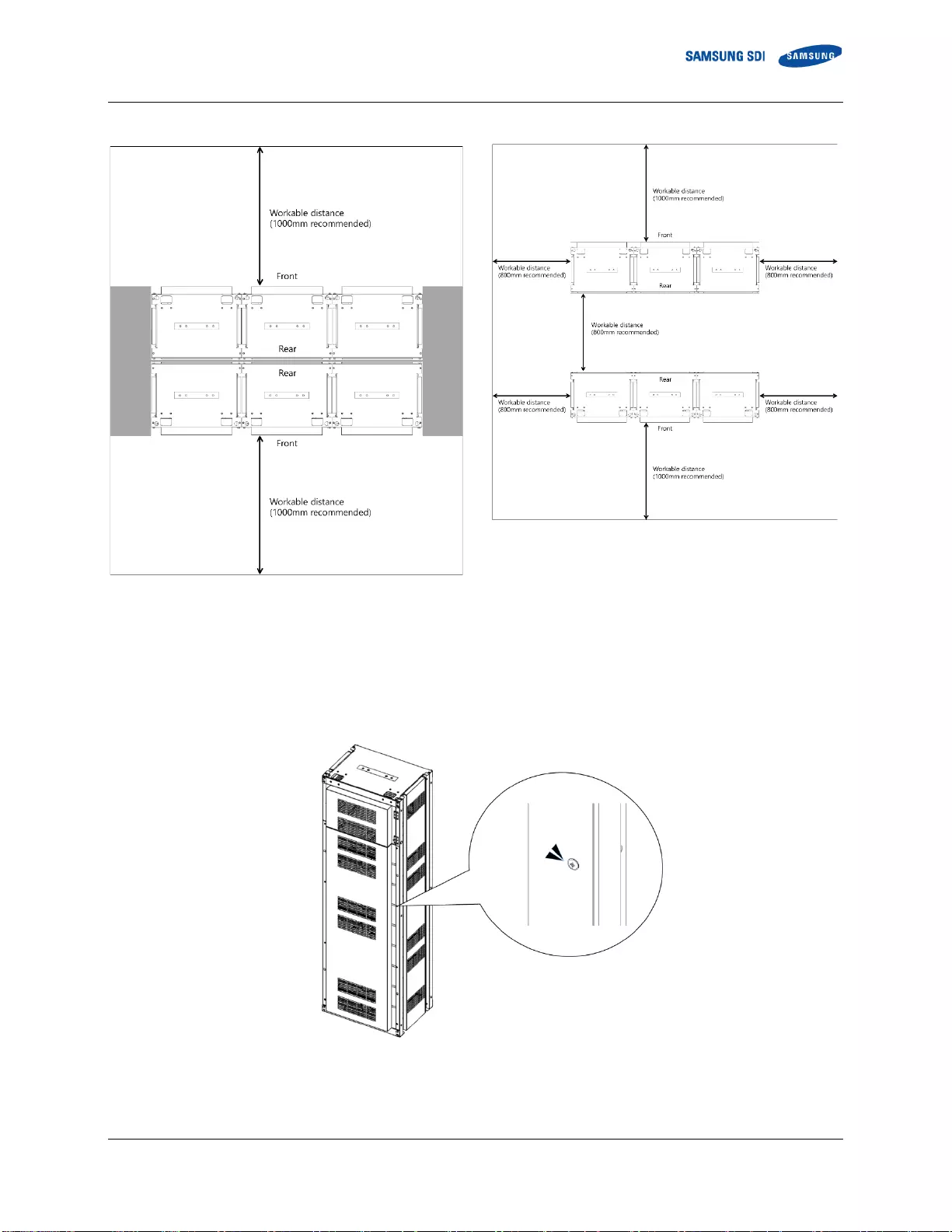
3. Installing the Product
English 7/2020. Rev 0.41 23
Two anchor points (not rated for seismic event)
Four anchor points (Telcordia Zone 4)
Figure 3-4: Clearance Distance for Multiple Rack Frames Installed Side-by-Side and Rear-to-Rear
1. After unpacking the rack frame, transport it to its installation location.
2. Remove the front panels, side panels and rear panel from the rack frame. Unscrew the screws on each panel and lift the
panel to undo the hooks to the frame on each panel. Do not misplace the screws, as they are needed when installing the
panels back after anchoring the rack frame.
Figure 3-5: Front panel screws (eight)
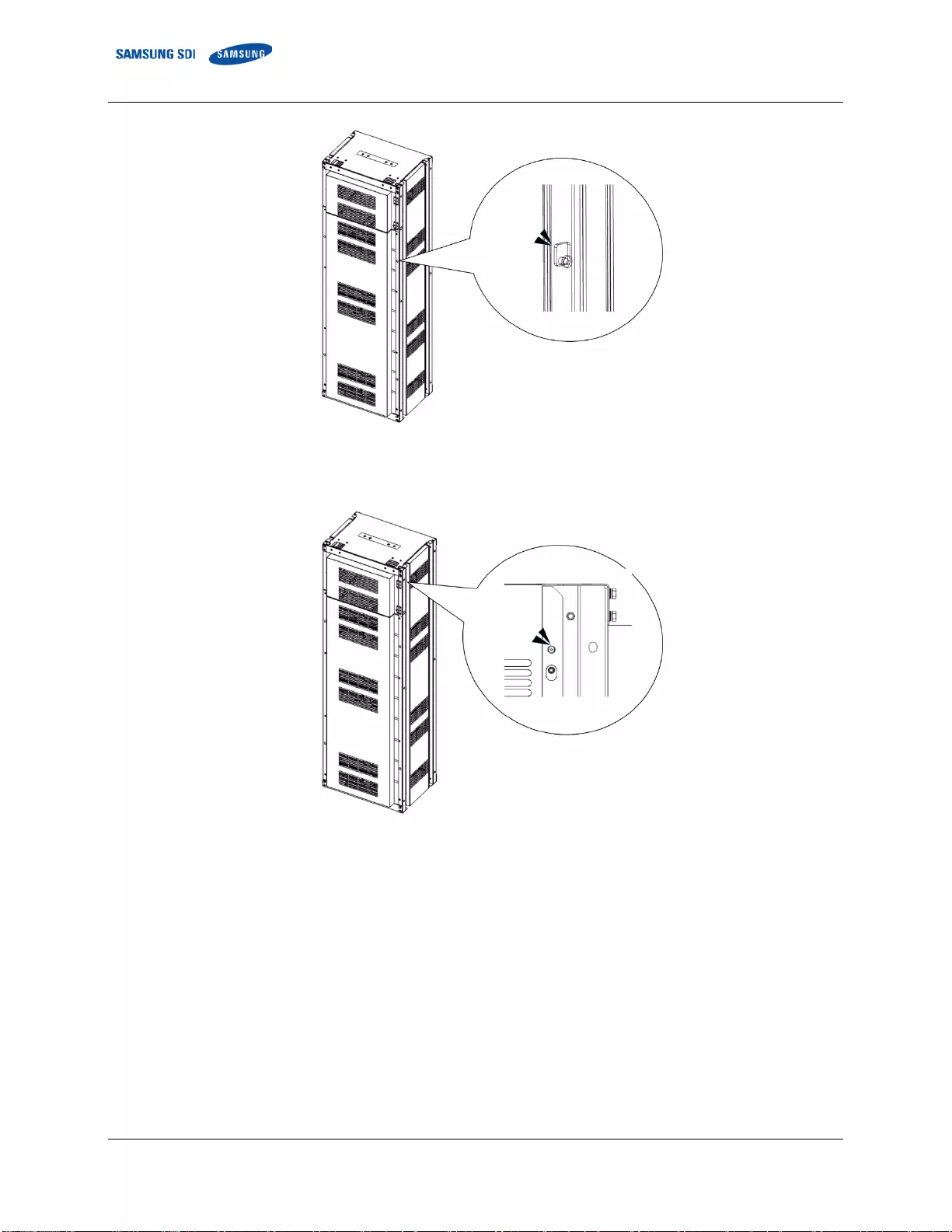
3. Installing the Product
24 English 7/2020. Rev 0.41
Figure 3-6: Front panel hooks (four)
Figure 3-7: Side panel screws (six)
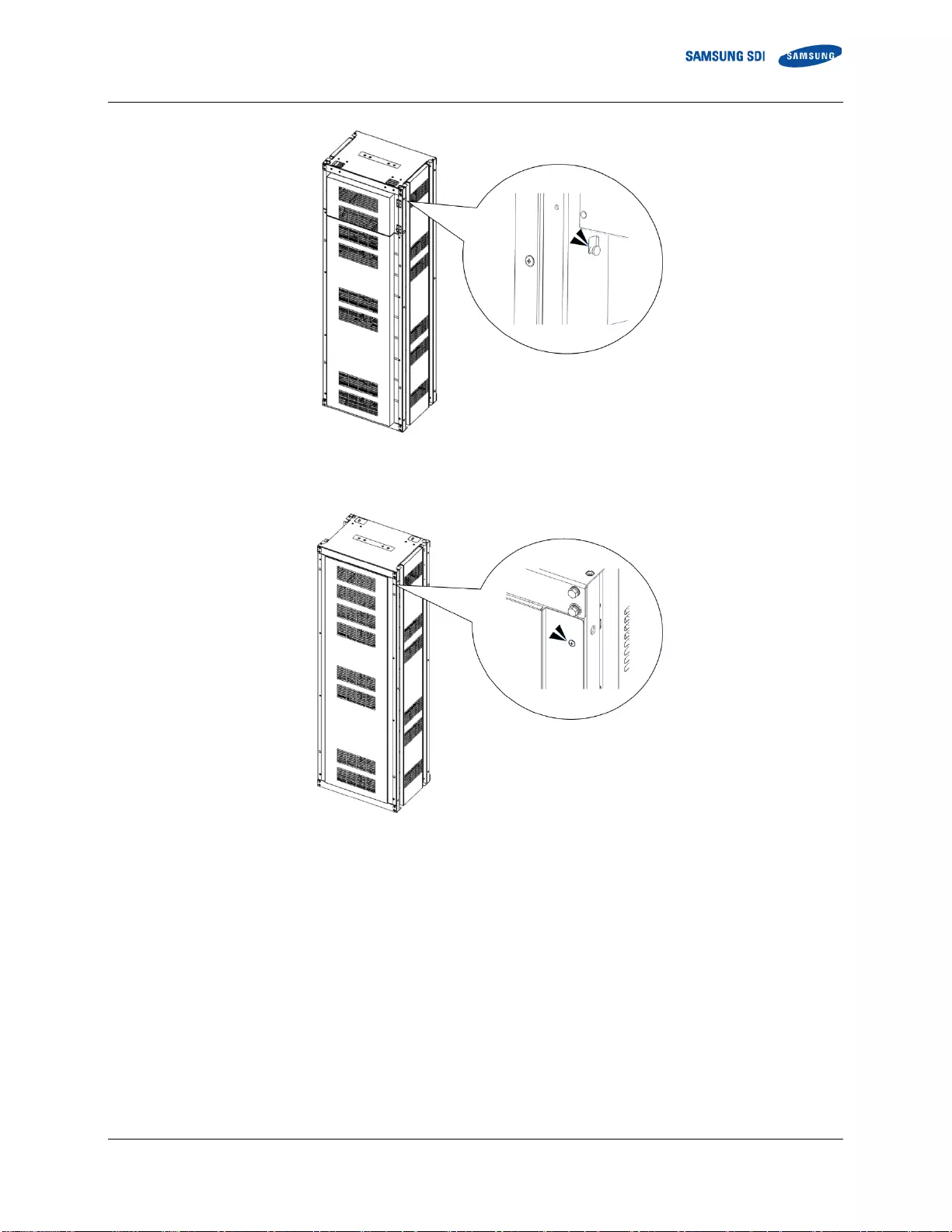
3. Installing the Product
English 7/2020. Rev 0.41 25
Figure 3-8: Side panel hooks (four)
Figure 3-9: Rear panel screws (eight)
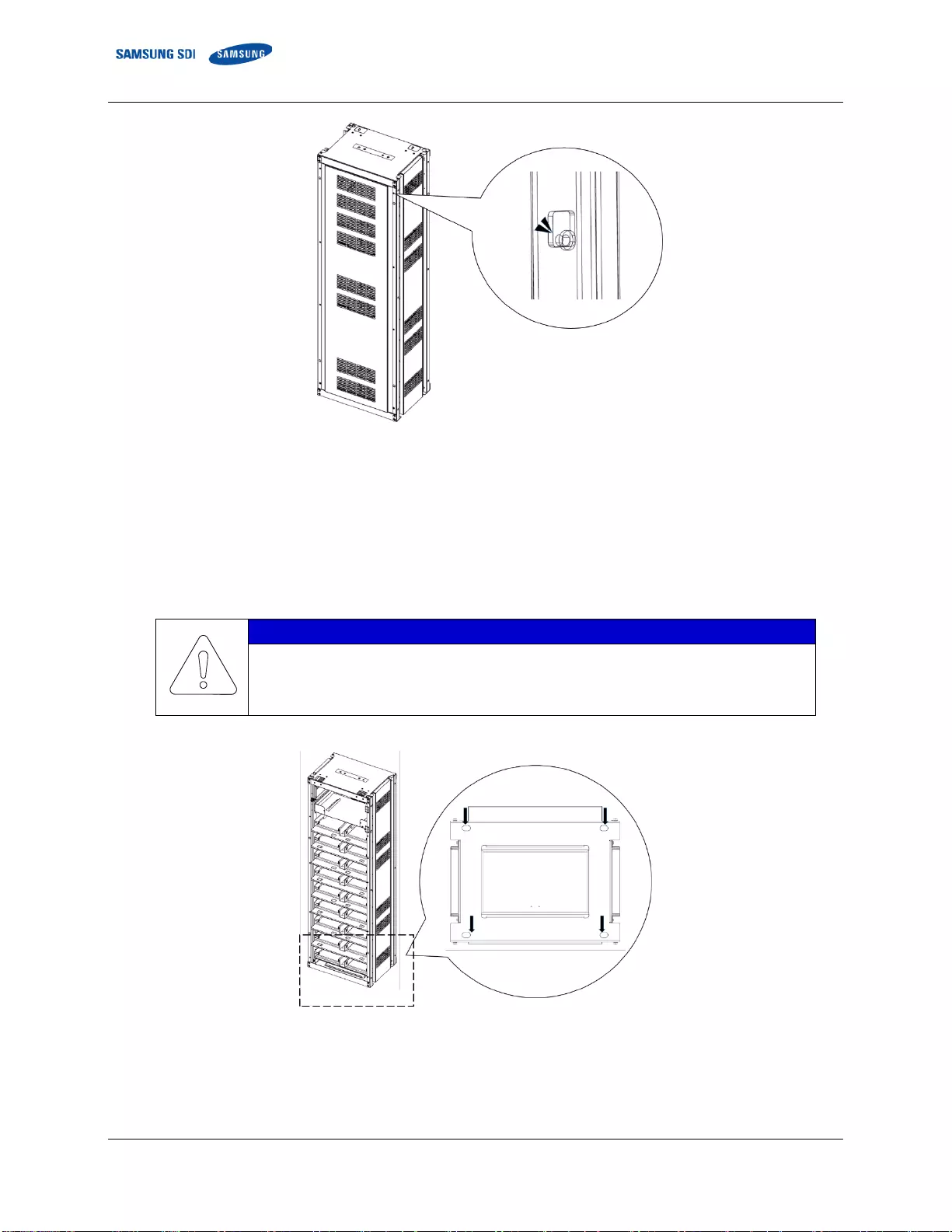
3. Installing the Product
26 English 7/2020. Rev 0.41
Figure 3-10: Rear panel hooks (four)
3. Arrange the rack frame after verifying that the holes in the frame and anchoring points are aligned.
4. Connect four anchoring points on the bottom of the rack.
NOTICE
Anchor the frame with M16 bolts and nuts.
The fastening torque should be 140Nm / 1,425kgf cm.
Check the rack and other parts for distortion caused by unpacking.
Figure 3-11: Rack Anchoring Points (4 EA)
Bottom of the Rack Frame
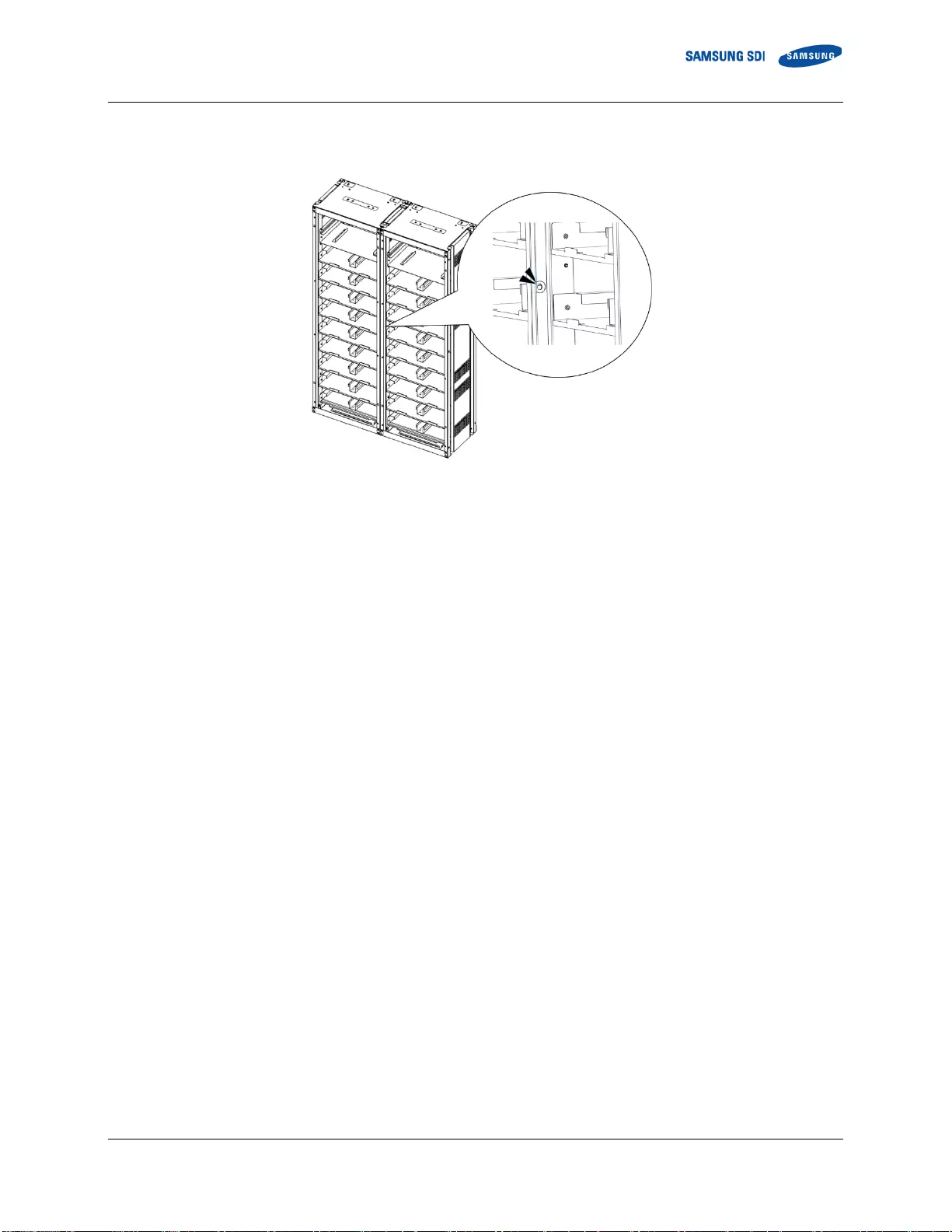
3. Installing the Product
English 7/2020. Rev 0.41 27
5. Connect the racks together using M10 hardware through holes in the sides (“SCREW M10 X 25,” “M10 FLAT WASHER” and
“NUT M10”). Torque the bolts to 30Nm (300kgf cm).
Figure 3-12: Holes on the sides of the rack (six)
6. Optional step: After all the rack frames are anchored and connected, reattach the side panels to the outermost rack frames
using the provided M5 Screws for each side panel. Fasten the screws using torque of 5.1–6.1 Nm (50–60 kgf/cm). Make sure
all the hooks are inserted to the slot and the panel is flush with the rack frame before screwing.
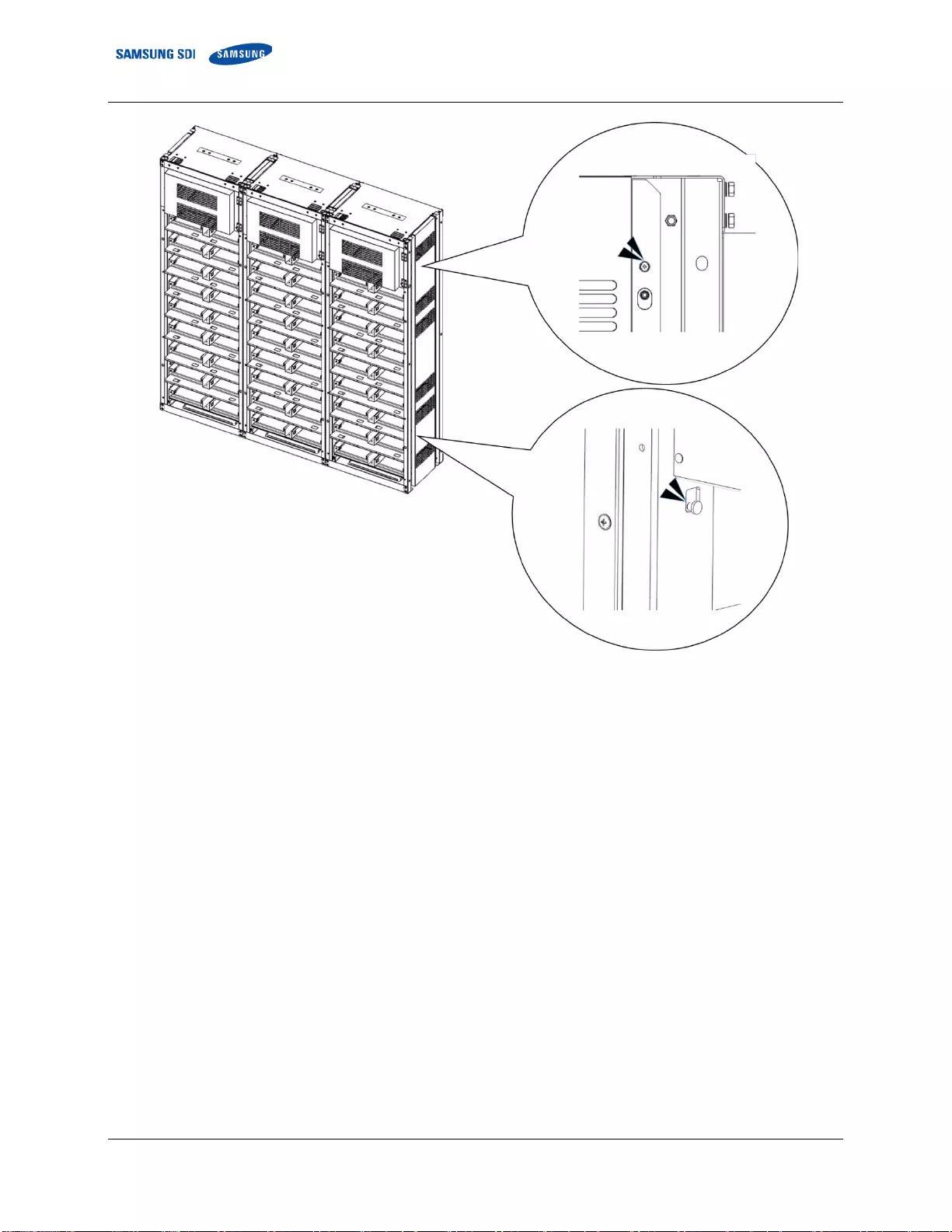
3. Installing the Product
28 English 7/2020. Rev 0.41
Figure 3-13: Reattaching the Side Panels (four hooks and six screws for each panel)
7. Reattach the rear panels to the rack frames using the provided M5 Screws for each rear panel. Fasten the screws using
torque of 5.1–6.1 Nm (50–60 kgf/cm). Make sure all the hooks are inserted to the slot and the panel is flush with the rack
frame before screwing.
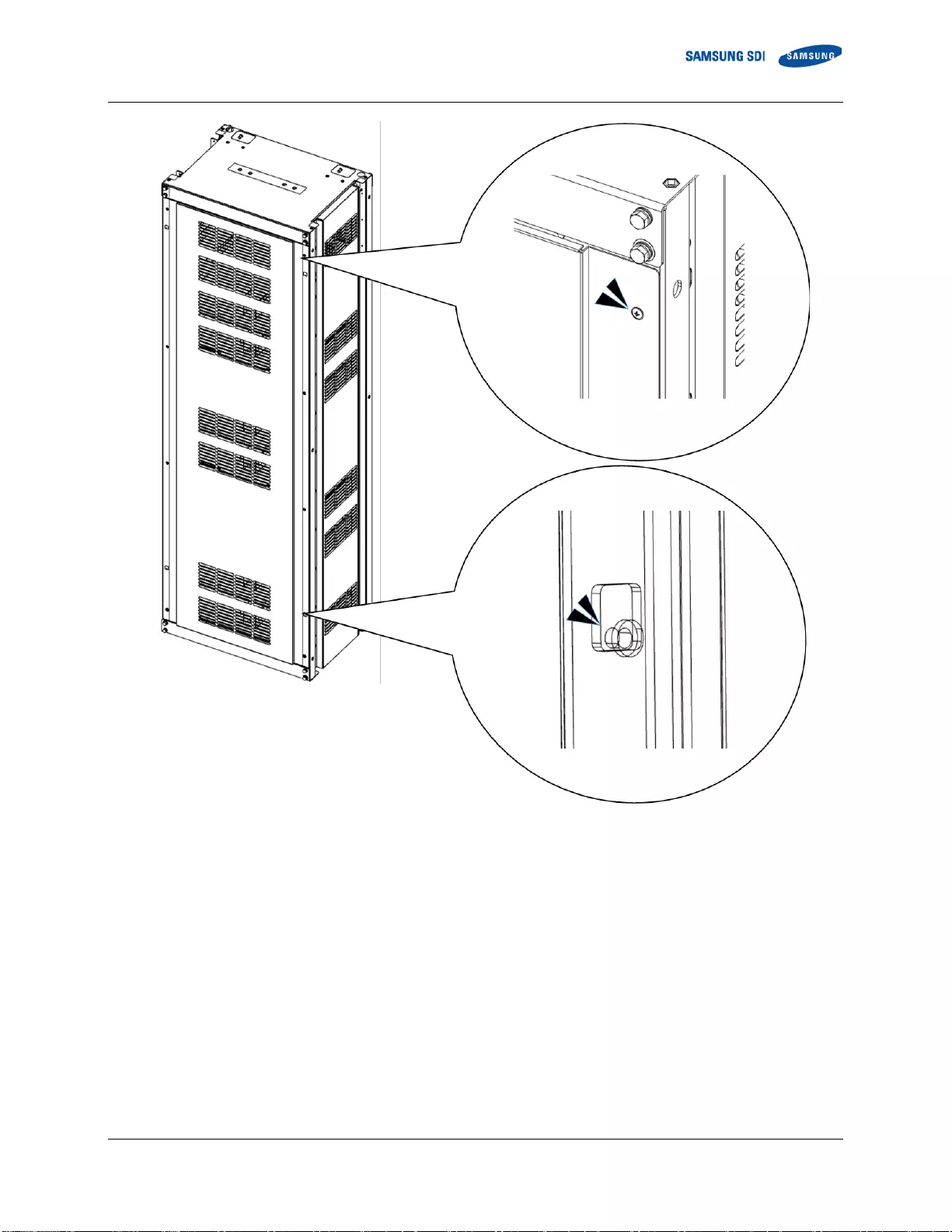
3. Installing the Product
English 7/2020. Rev 0.41 29
Figure 3-14: Reattaching the Rear Panels
8. Front panels will be reattached after all the components are installed.
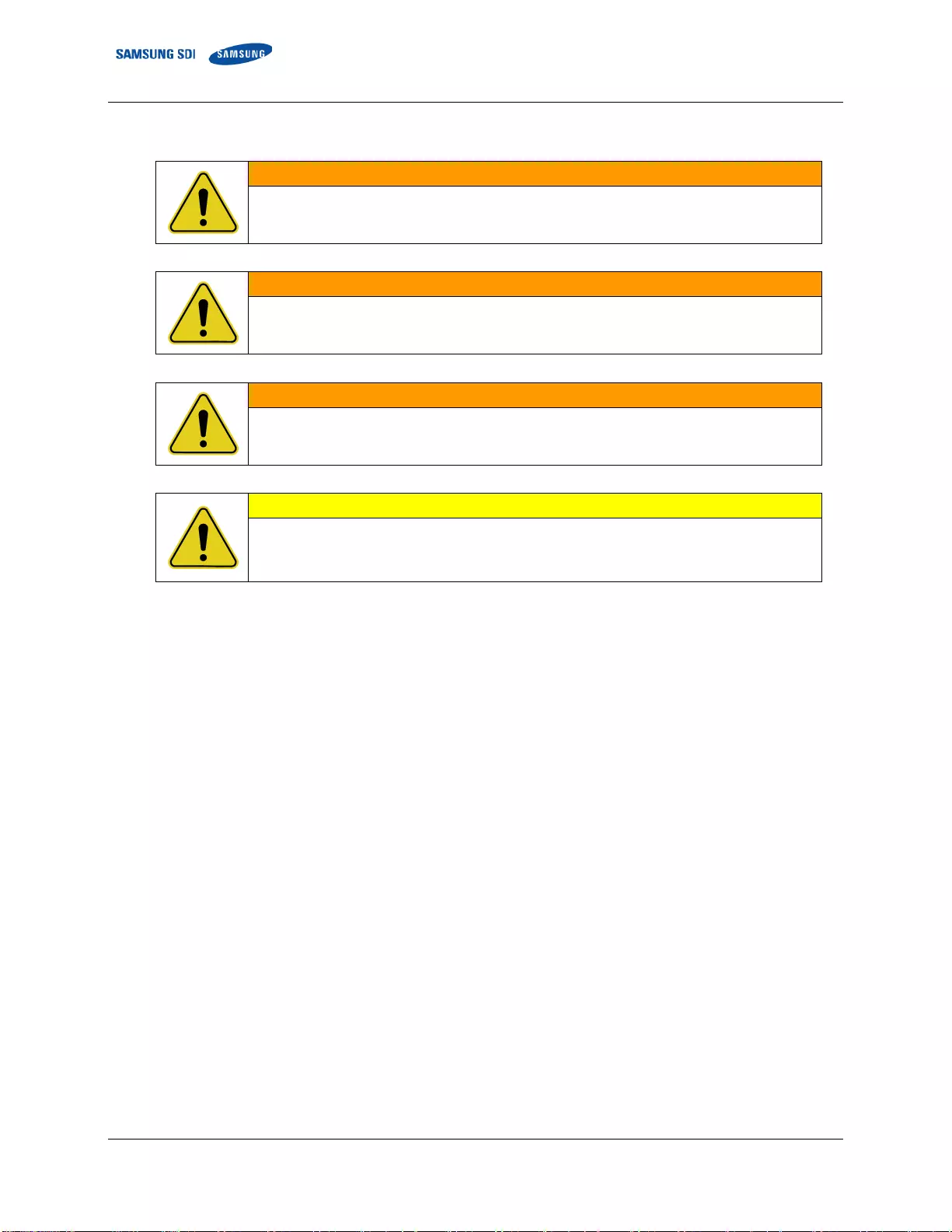
3. Installing the Product
30 English 7/2020. Rev 0.41
3.10 Rack Installation Stage
WARNING
Arc Flash and Shock Hazard
Insulated tools are required for any work on this energized equipment.
WARNING
Sharp Edges
Wear gloves and other protective gear to prevent injury.
WARNING
Pinch Point
Use caution when working in the enclosure to prevent injury.
CAUTION
Heavy Object
Can cause muscle strain or back injury.
Use lifting aids and proper lifting techniques when moving trays, batteries and other heavy objects.
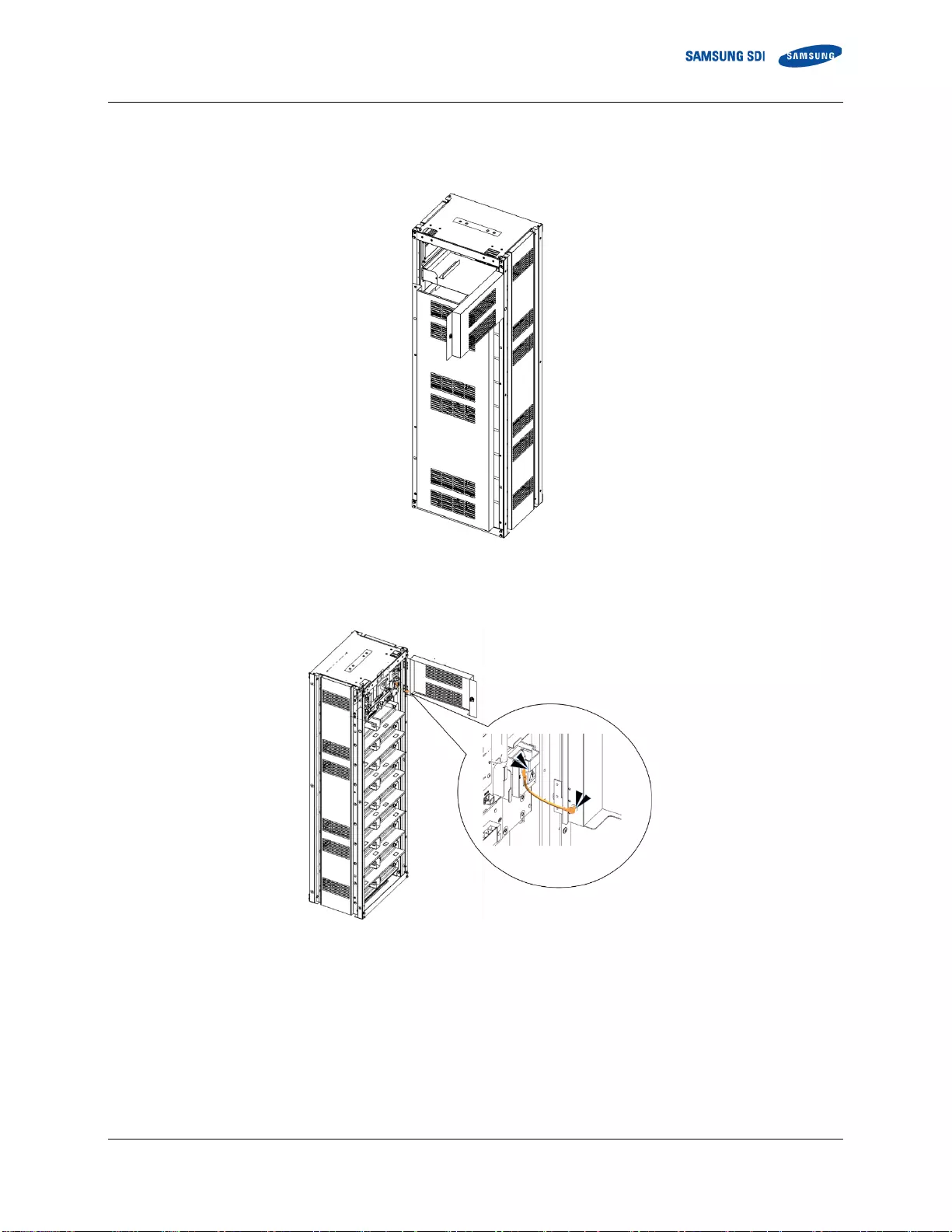
3. Installing the Product
English 7/2020. Rev 0.41 31
3.10.1 Front Door Removal
1. Open the front door of the panel using the provided key.
Figure 3-15: Front door ajar
2. Remove the earth cable from the rack frame to the front door. Do not misplace the two screws and the earth cable.
Figure 3-16: Removing the earth cable
3. Lift the front door to remove it from its hinge. Do not misplace the door.
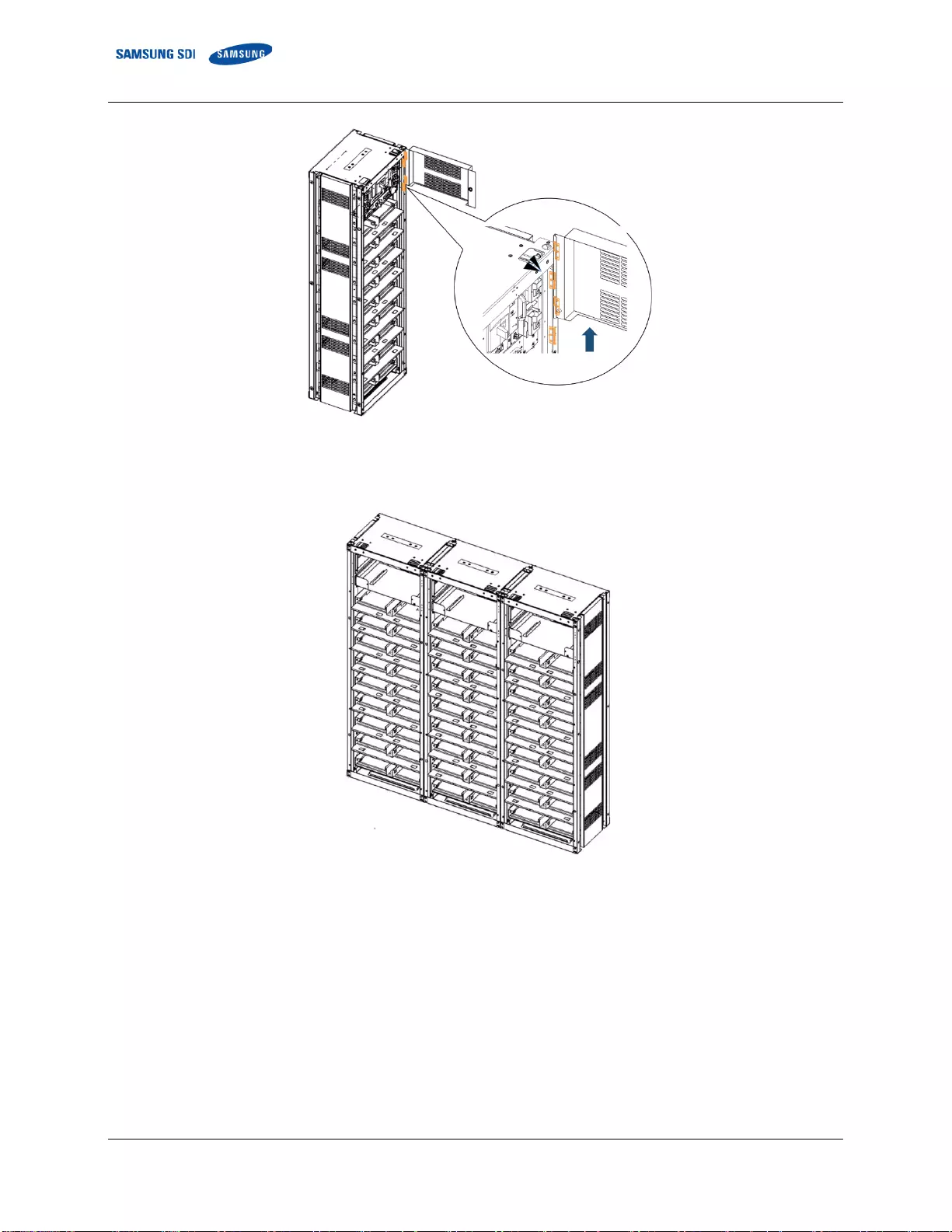
3. Installing the Product
32 English 7/2020. Rev 0.41
Figure 3-17: Removing the front door
4. If installing more than one rack, remove all the doors.
Figure 3-18: All doors and front panels removed.
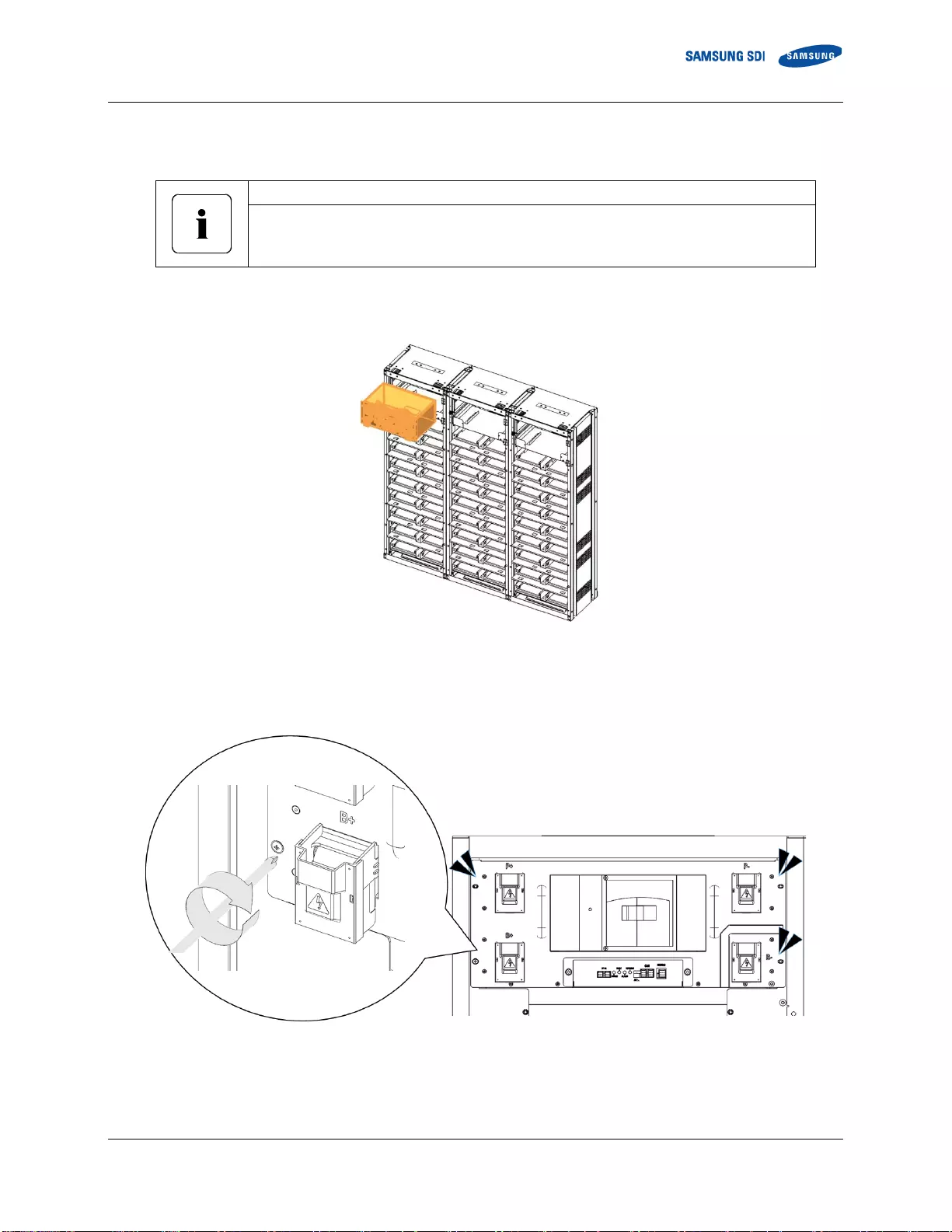
3. Installing the Product
English 7/2020. Rev 0.41 33
3.10.2 SMU and SMPS Assembly Installation
Important
Attach each SMU to its rack frame with four M5 x 10L screws. (Torque: 5.1–6.1 Nm [50–60 kgf
cm])
Verify that the torque setting is correct.
1. Insert the SMU through the front of the rack as shown in Figure 3-19: Inserting SMU
Figure 3-19: Inserting SMU
2. After all SMU’s are inserted in the rack frames, attach each to the rack frame with four M5 x 10L bolts. (Torque: 5.1–6.1 Nm
[50–60 kgf cm])
Figure 3-20: Attaching a SMU to a Rack Frame
3. After all SMU’s are inserted into the rack frame, connect the ground cable.
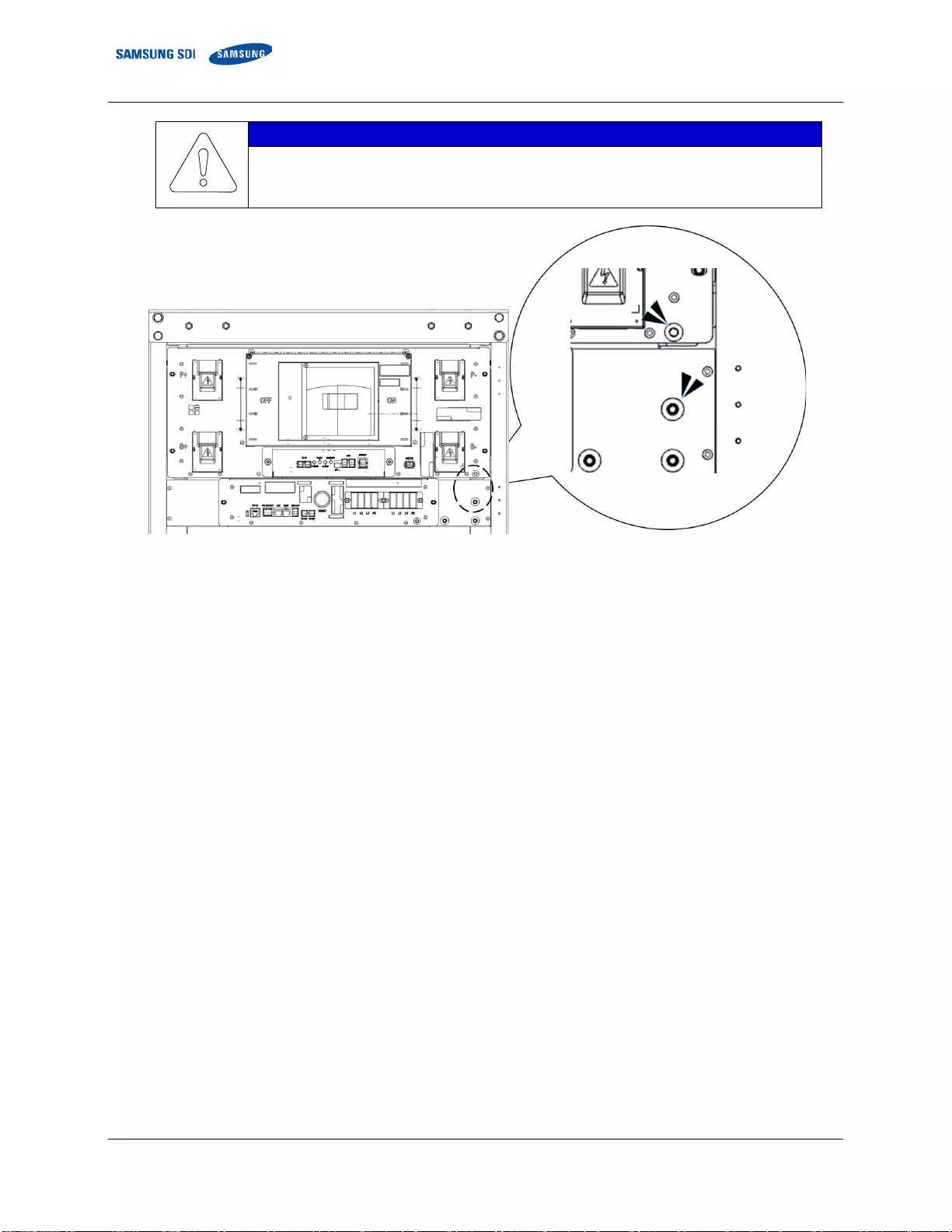
3. Installing the Product
34 English 7/2020. Rev 0.41
NOTICE
Connect a ground cable between the SMU and the Rack Frame (SCREW M5 x 10L). (Torque:
5.1–6.1 Nm [50–60 kgf∙cm])
Verify that the torque setting is correct.
Figure 3-21: Ground Cable Connection to the SMU
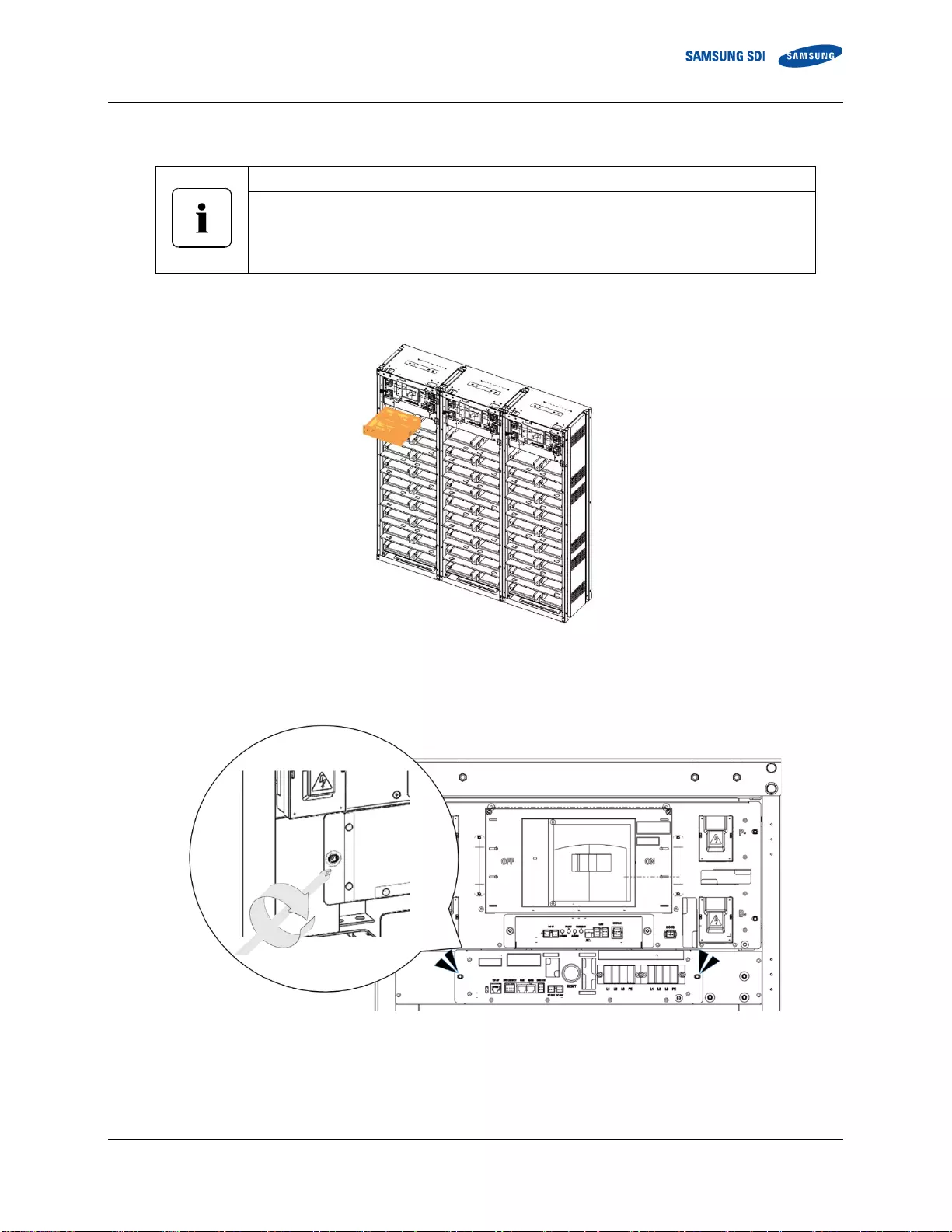
3. Installing the Product
English 7/2020. Rev 0.41 35
4. Insert SMPS Assembly into the rack frames designated for SMPS Assembly as shown in Figure 3-22: Inserting SMPS Assembly
Important
Attach the inserted SMPS Assemblies to the rack frames by fastening each with four M5 x
10Lscrews
(Torque: 5.1–6.1 Nm [50–60 kgf cm])
Verify that the torque setting is correct.
5. Slide the SMPS Assembly into the rack frame on the shelf designated for the SMPS Assembly as shown below.
Figure 3-22: Inserting SMPS Assembly
6. After all SMPS Assemblies are inserted into the rack frames, attach them to the rack frame with screws (Torque: 5.1–6.1 Nm
[50–60 kgf cm])
Figure 3-23: Attaching the SMPS Assembly
7. After all SMPS Assemblies are attached to the rack frames, connect the ground cables.
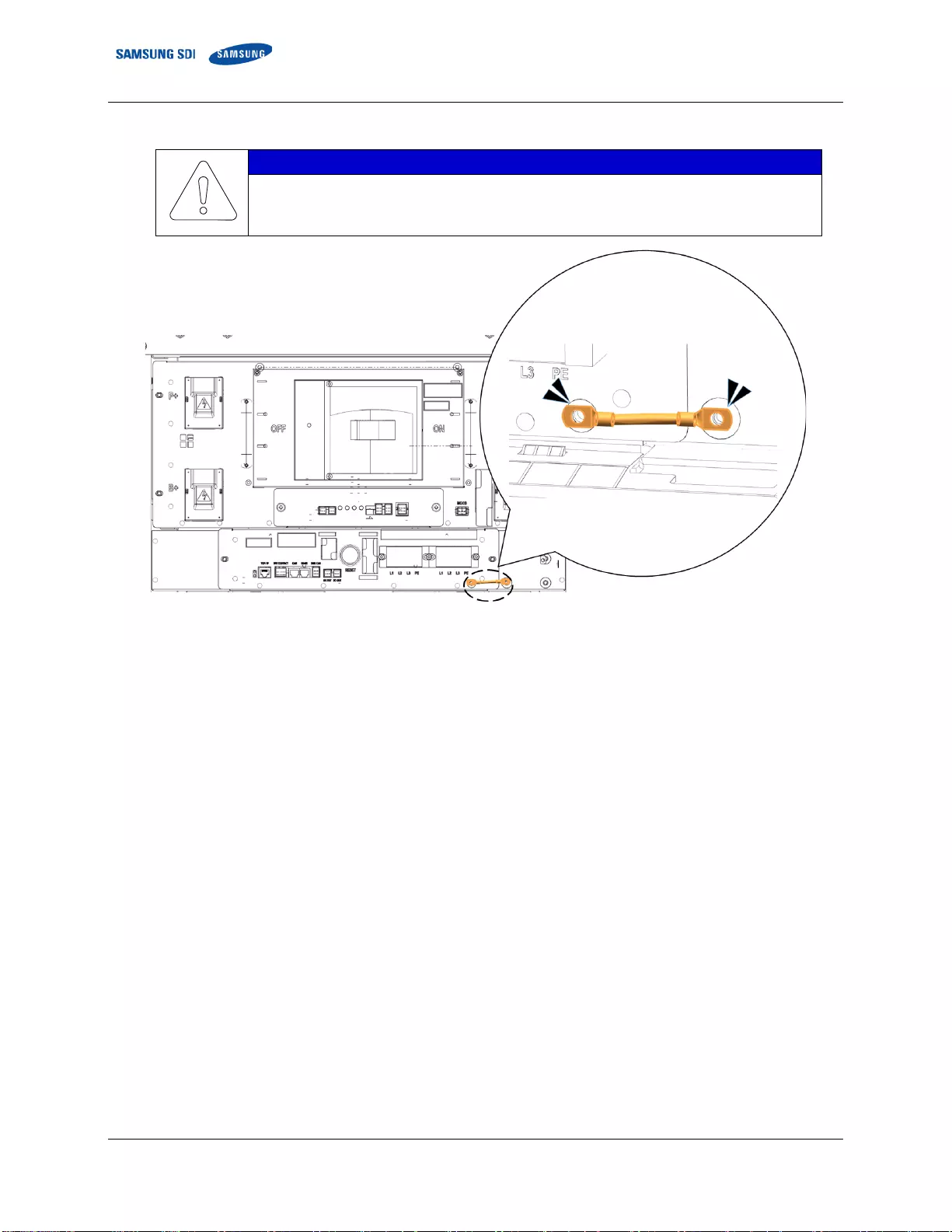
3. Installing the Product
36 English 7/2020. Rev 0.41
NOTICE
Connect a ground cable between the SMPS Assembly and the Rack Frame with an M5 x 10L
screw. (Torque: 5.1–6.1 Nm [50–60 kgf cm])
Verify that the torque setting is correct.
Figure 3-24: Ground Cable Connection to the SMPS Assembly
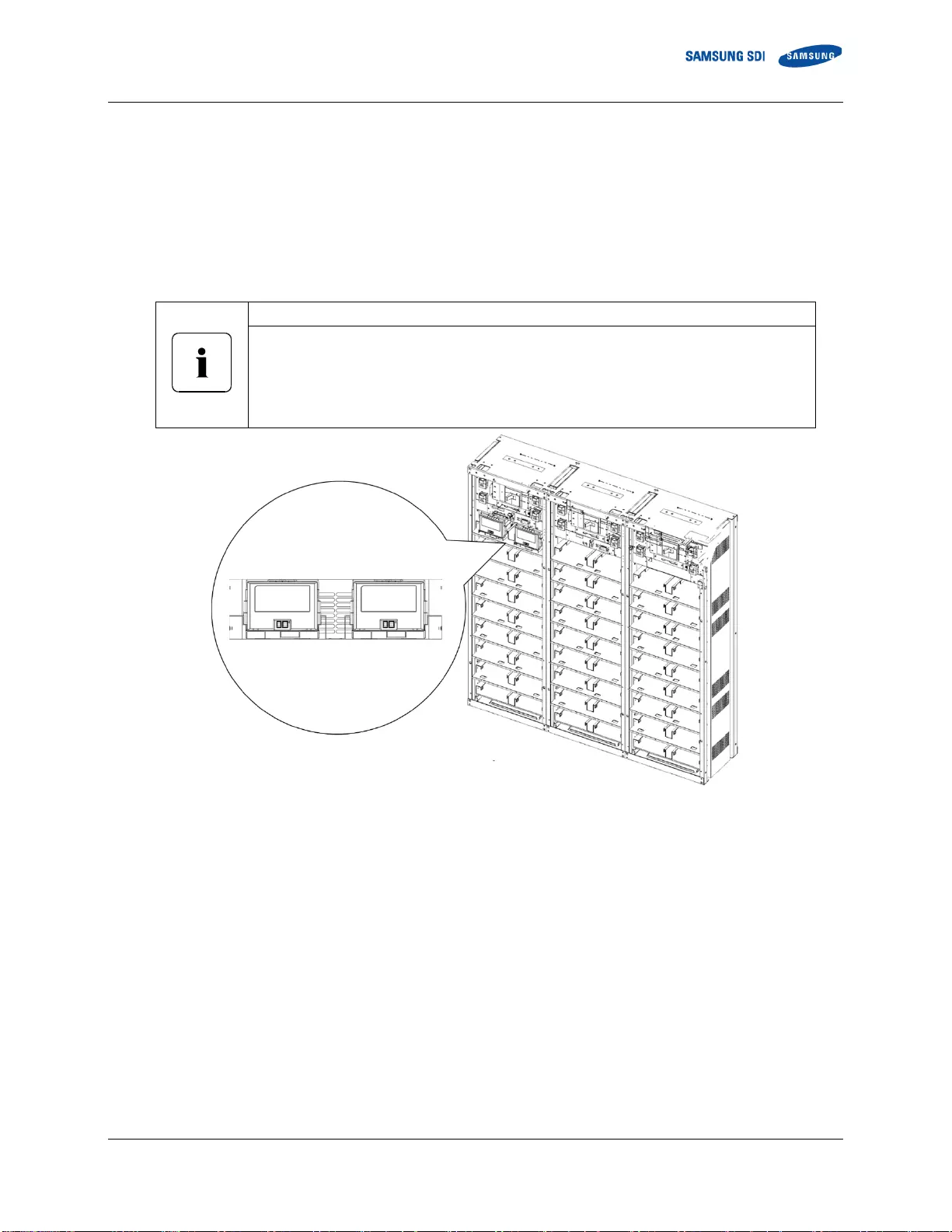
3. Installing the Product
English 7/2020. Rev 0.41 37
3.10.3 Battery Module Installation
1. Transport battery modules to the installation location.
2. Measure the modules’ voltage and internal impedance. All modules in one rack frame must be near the same state of charge.
The batteries must have an output within 300mV of each other and internal impedance difference of 1.3mΩ. Refer to Table
3-8: Module Voltage and Internal Impedance.
3. Place the battery modules on the rack frame.
Important
Samsung recommends installing Battery Modules in the upper shelves first and proceeding to
the bottom.
(Two Type B battery modules are inserted in the ninth shelf from the bottom.)
Ten battery modules can be inserted into a rack frame as shown in Figure 3-27.
Refer to 2.1.1 for information on the different battery module types.
Figure 3-25: Insertion of Modules on the Ninth Shelf from the Bottom
Two Type B Battery
Modules
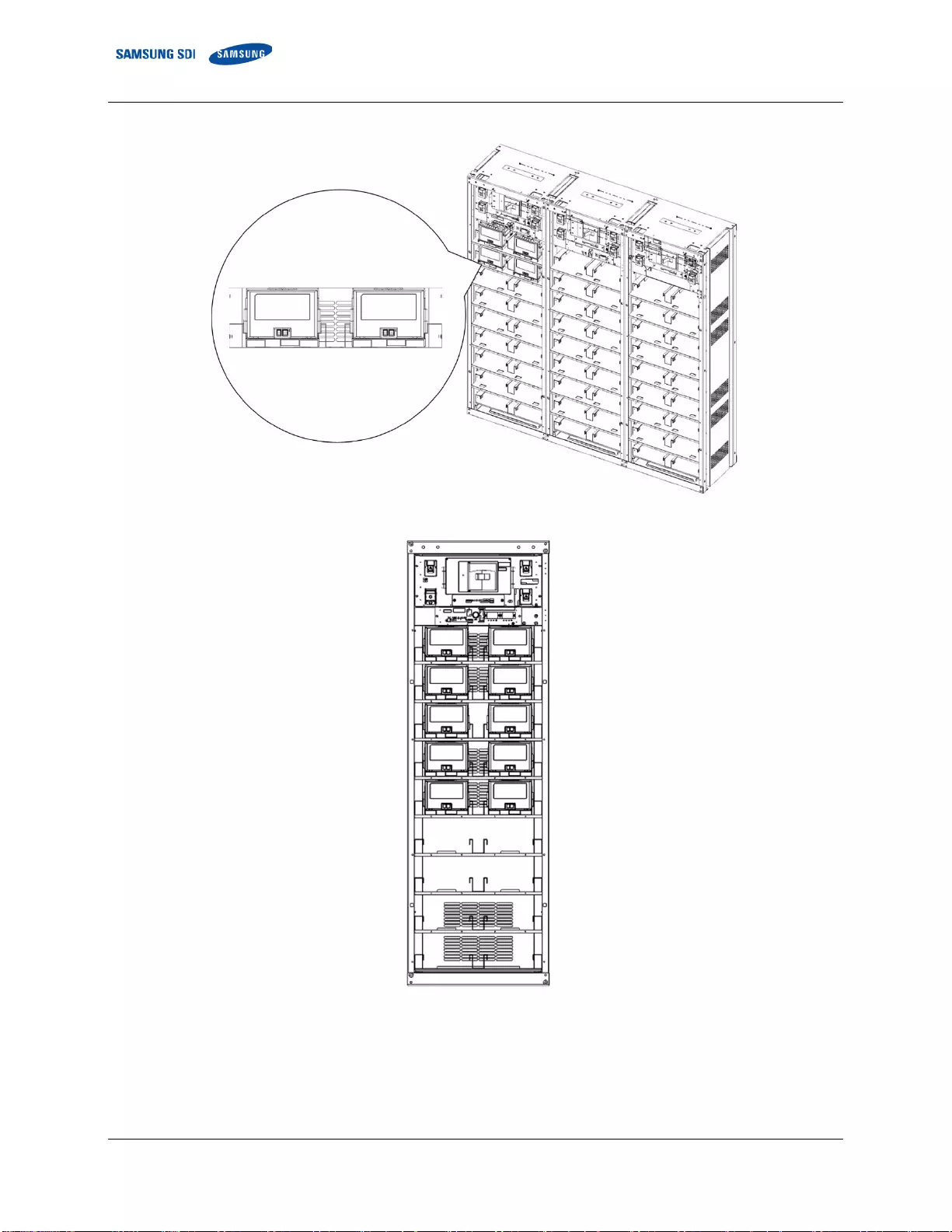
3. Installing the Product
38 English 7/2020. Rev 0.41
Figure 3-26: Battery Module Arrangement on the Eighth Shelf
Figure 3-27: Battery Module Arrangement
Two Type A
Battery Modules
Two Type B Battery Modules
Two Type A Battery Modules
Two Type B Battery Modules
Two Type A Battery Modules
Two Type B Battery Modules
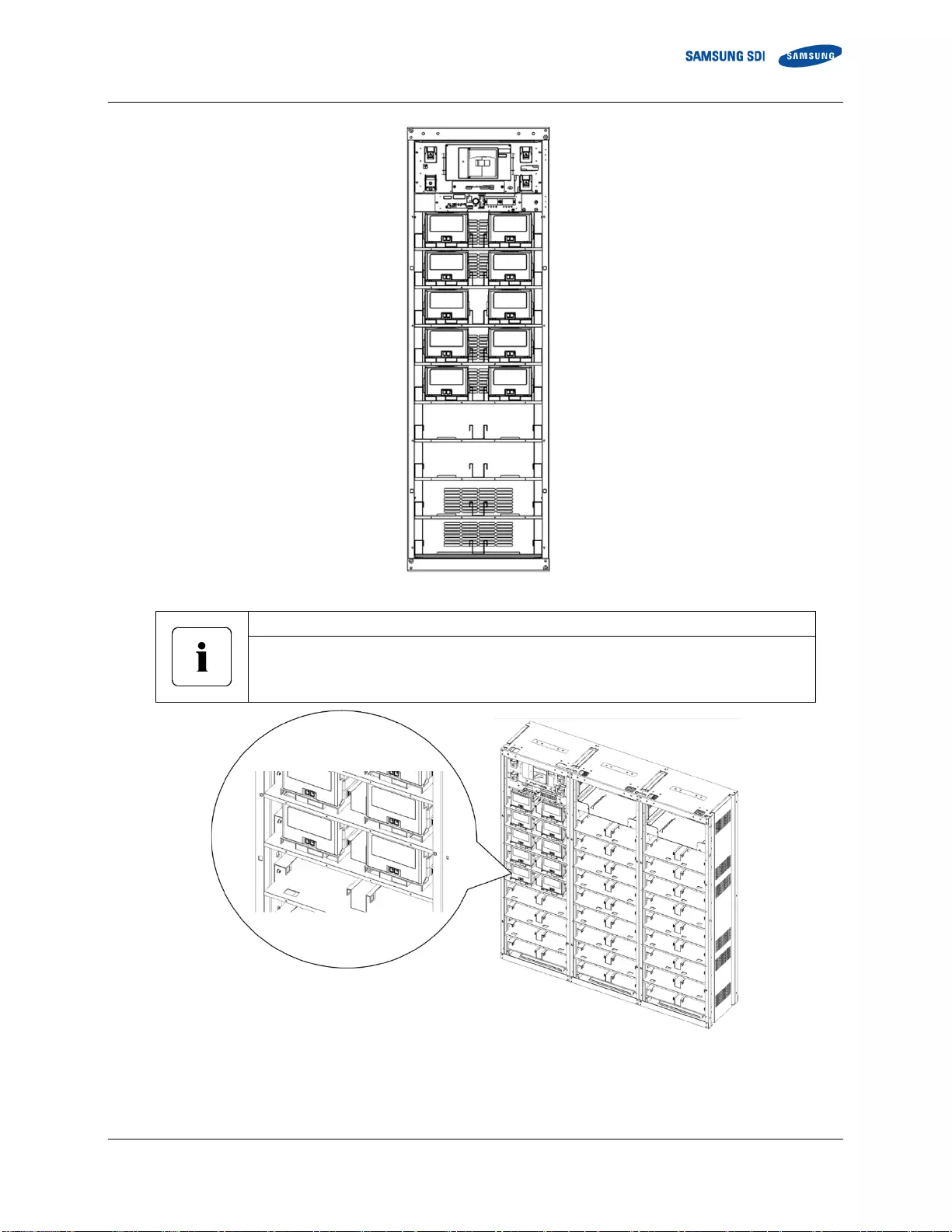
3. Installing the Product
English 7/2020. Rev 0.41 39
Figure 3-28 : Module Number
Important
Samsung recommends installing modules from top to bottom.
The bottom shelf (5th shelf) has two Type B modules, as shown in Figure 3-29.
Figure 3-29: Insertion of modules on 5th shelf
Module #5
Module #4
Module #3
Module #2
Module #1
Module #6
Module #7
Module #8
Module #9
Module #10
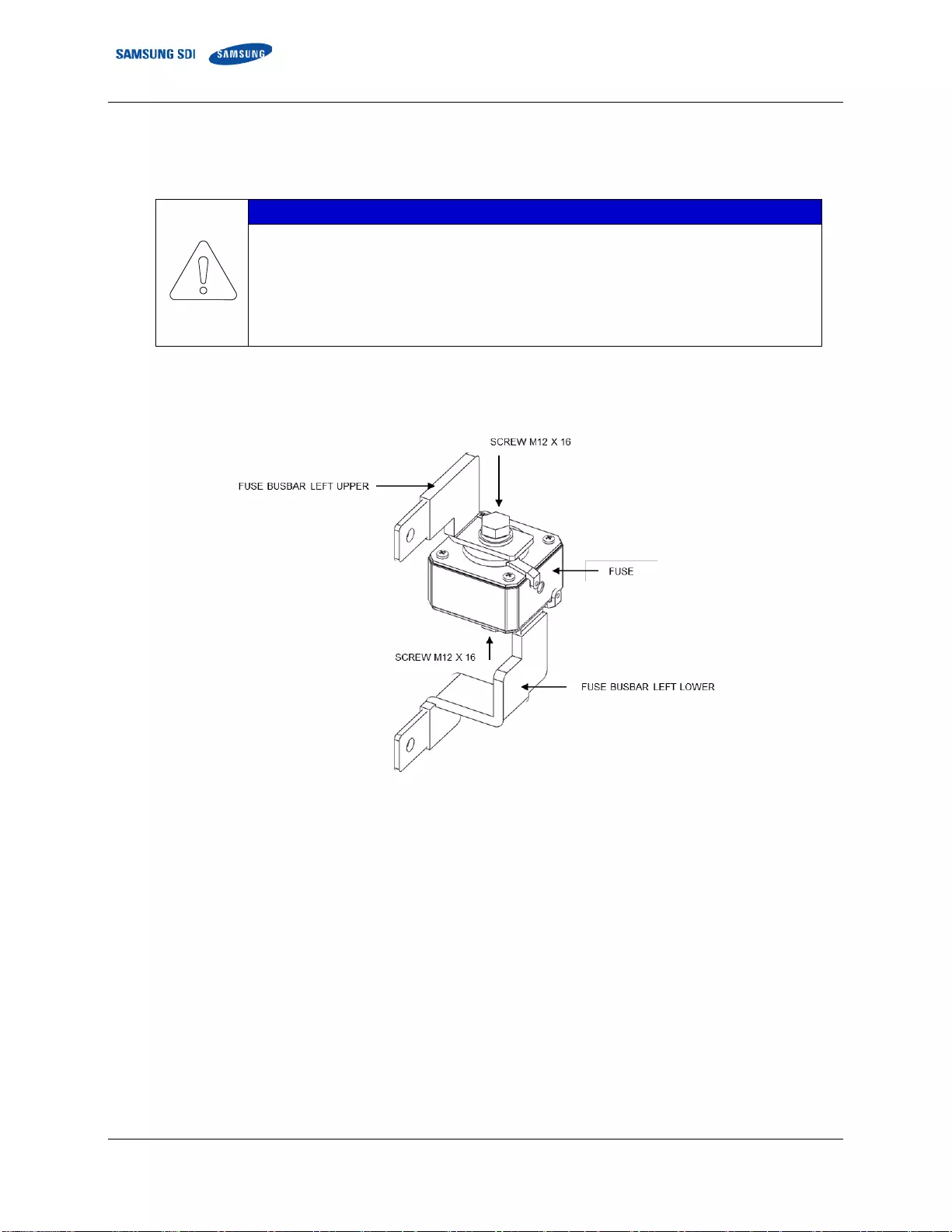
3. Installing the Product
40 English 7/2020. Rev 0.41
3.10.4 Fuse-Busbar Assembly
Three types of fuse-busbar assemblies must be assembled before installing them to the Battery Modules.
NOTICE
Rack Fuse Busbar Assembly is assembled at the installation location.
M12 X 16L screws are used to assemble the busbars and fuse.
The fastening torque should be 30 Nm (300 kgf/cm).
After torqueing, torque mark the screws using a colored marker or a torque seal.
When assembling the fuse, make sure the “red indicator arm” on the fuse is facing the front of
the unit.
1. Assemble the Fuse Busbar Left Assembly.
Fuse Busbar Left Assembly is comprised of one “FUSE BUSBAR LEFT UPPER”, one one “FUSE BUSBAR LEFT LOWER”, two
“SCREW M12 X 16”, two “FUSE COVER #2”, and one “FUSE”
Figure 3-30: Fuse Busbar Left Assembly
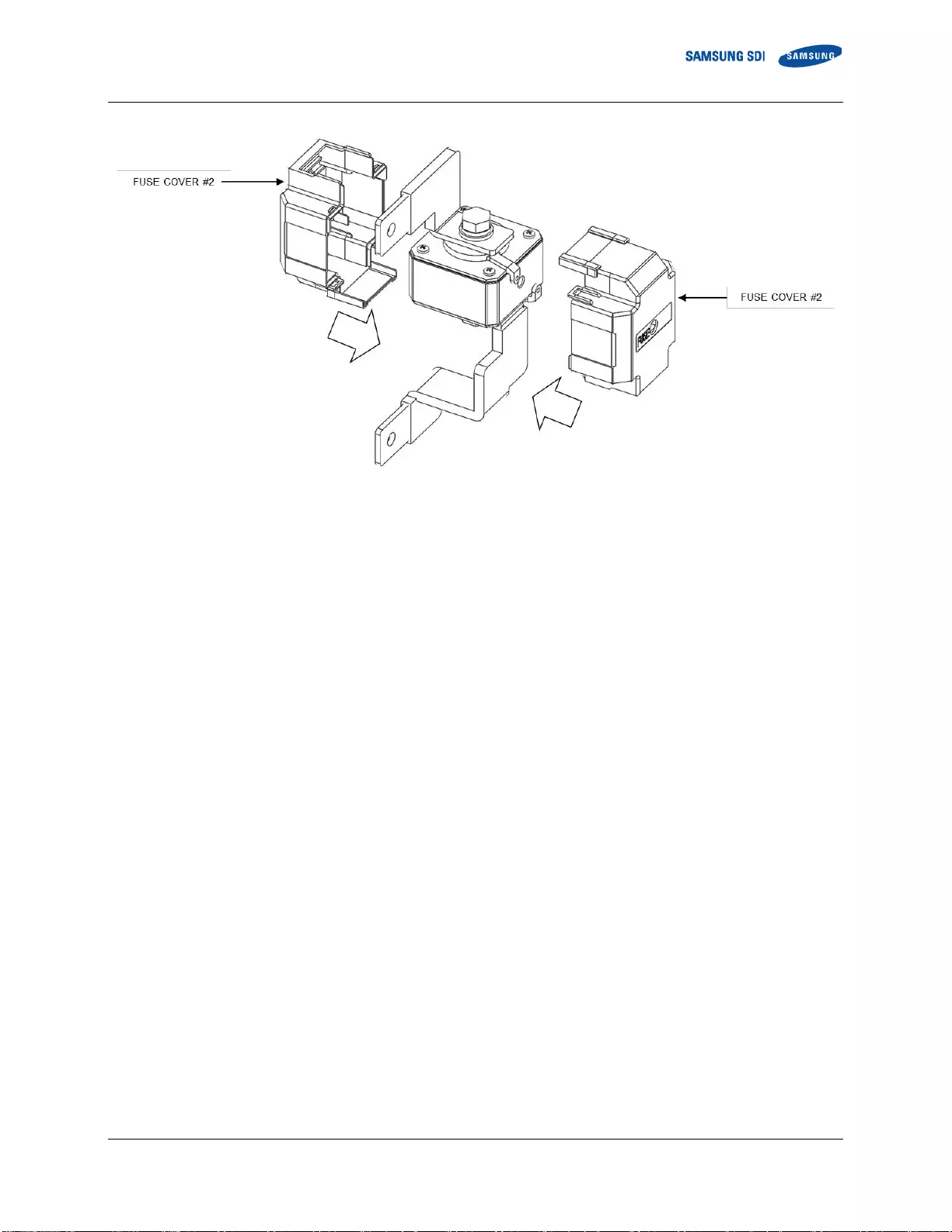
3. Installing the Product
English 7/2020. Rev 0.41 41
Figure 3-31: Fuse Busbar Left Assembly (Fuse Cover)
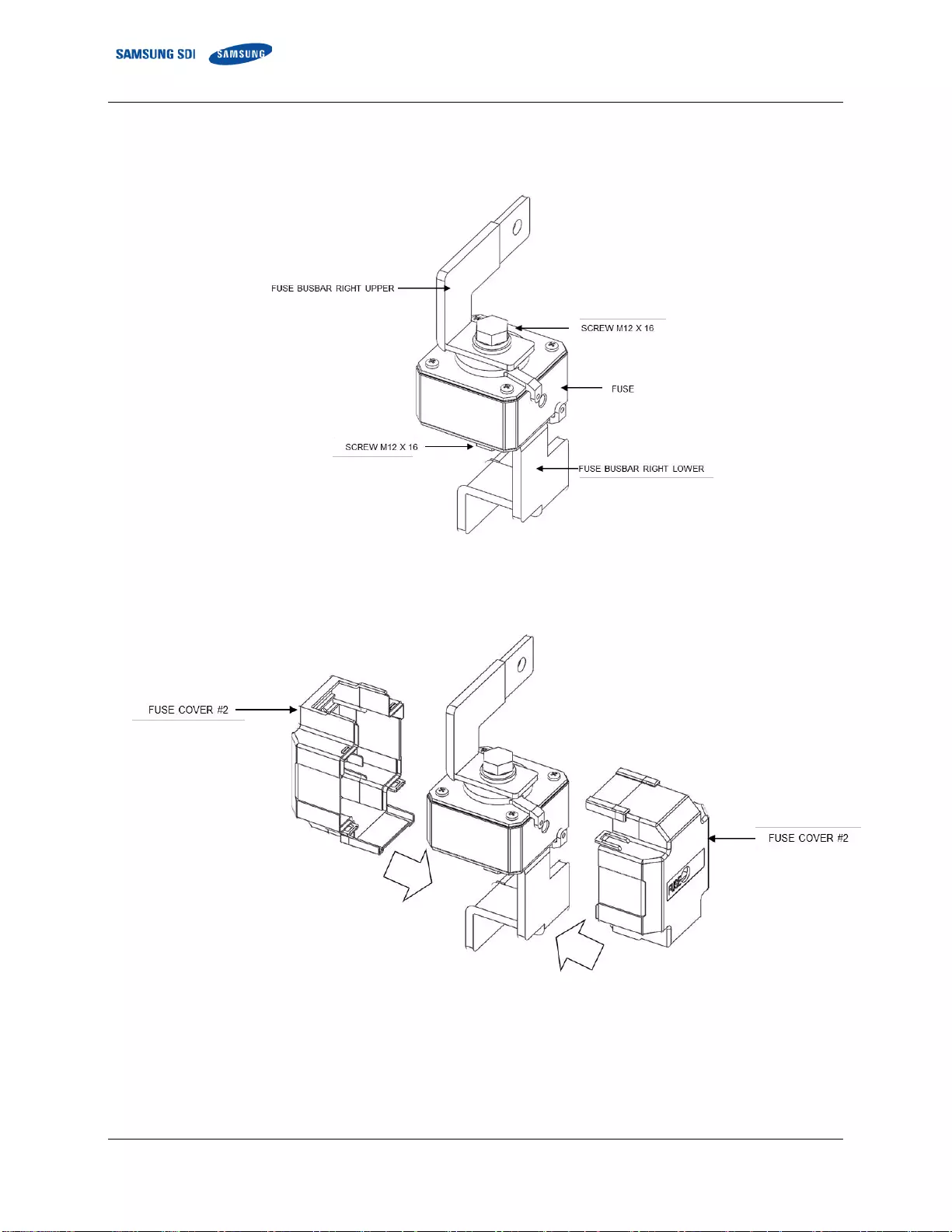
3. Installing the Product
42 English 7/2020. Rev 0.41
2. Assemble the Fuse Busbar Right Assembly.
Fuse Busbar Right Assembly is comprised of one “FUSE BUSBAR RIGHT UPPER”, one one “FUSE BUSBAR RIGHT LOWER”, two
“SCREW M12 X 16”, two “FUSE COVER #2”, and one “FUSE”
Figure 3-32: Fuse Busbar Right Assembly
Figure 3-33: Fuse Busbar Right Assembly (Fuse Cover)
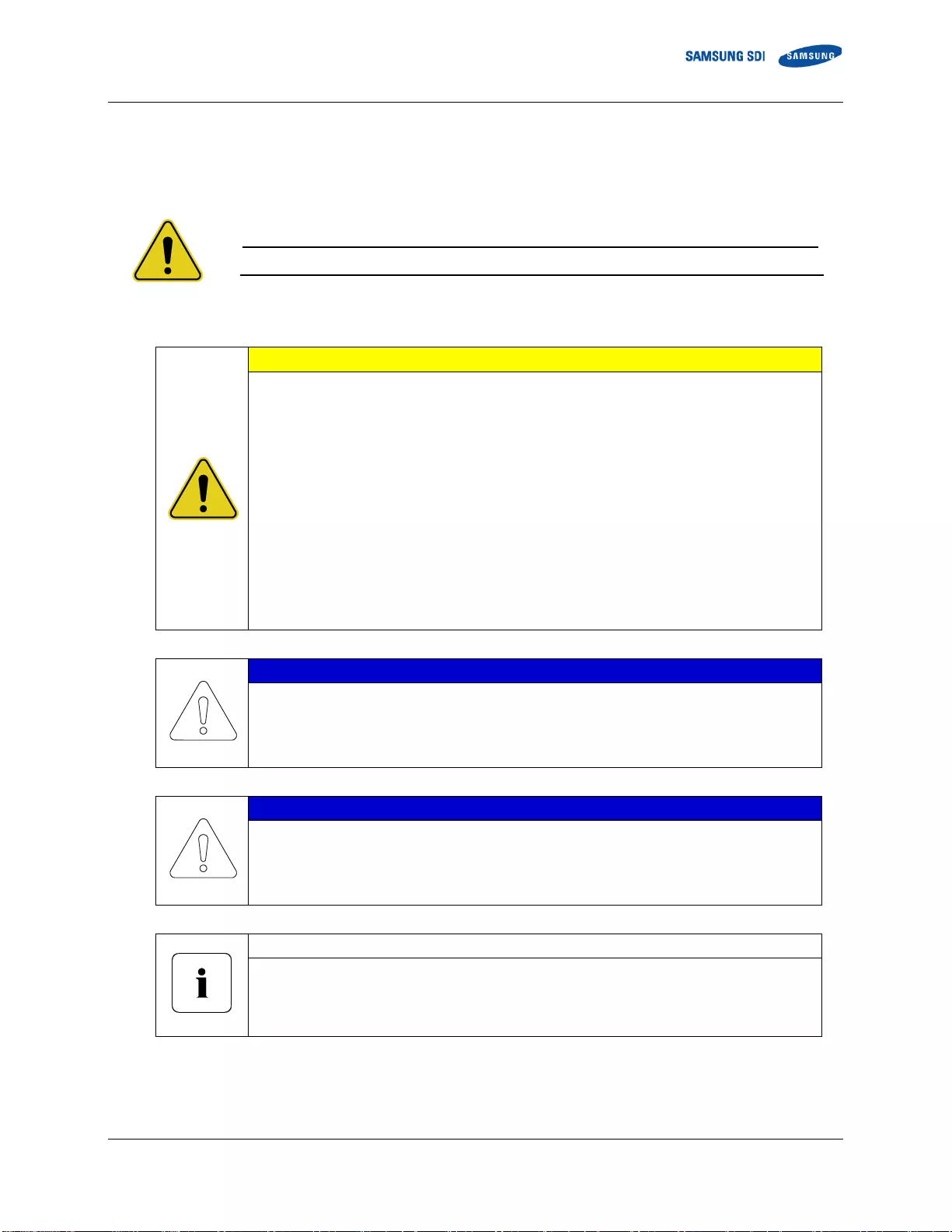
3. Installing the Product
English 7/2020. Rev 0.41 43
3.10.5 Busbar Installation
Connect the power busbars between modules
Verify with a voltmeter that no power is present on the system.
Use lock out/tag out procedures to secure the UPS and batteries.
CAUTION
Please follow the instructions to protect the module BMS against damage.
Important: DO NOT deviate from the sequence of steps below.
The system’s voltage will increase proportionally as battery modules are connected. Exercise
extreme caution to prevent the terminals from contacting anything except their intended
mounting points.
Terminals and their connected wires have either positive or negative polarity (Positive: B+, P+;
Negative: B-, P-). The polarity of a terminal or a wire connected to the terminal is on the front
of each module and SMU. Exercise extreme caution to prevent the terminals and/or wires with
opposite polarity from contacting with each other.
It is recommended not to touch the battery positive(+) or negative(-) terminal for the batteries
with rack frame. There is no evidence of dielectric breakdown because of electrical isolation
between the battery positive (+) or negative (-) terminals and rack frame. However, it is
recommended not to touch them for safety because It is possible to touch between battery
positive (+) and negative (-) through the rack frame.
NOTICE
Connect the power busbar with an M8 screw for battery module terminals
The fastening torque should be 12.2–14.0 Nm (124–142 kgf/cm).
Use an insulated torque wrench extension with a 13 mm socket.
After torqueing, torque mark the screws using a colored marker or a torque seal.
NOTICE
Connect the power bus-bar with an M12 screw for SMU terminals
The fastening torque should be 30 Nm/300 kgf∙cm.
Use an insulated torque wrench extension with a 19 mm socket.
After torqueing, torque mark the screws using a colored marker or a torque seal.
Important
The power terminals, such as “B+,” “B-,” “P+,” and “P-,” of the module and SMU are covered
with the power terminal cover to guard against a short circuit.
At each step in this process, you must remove the cover prior to connecting a power busbar
and reattach the cover immediately after connecting the power busbars.
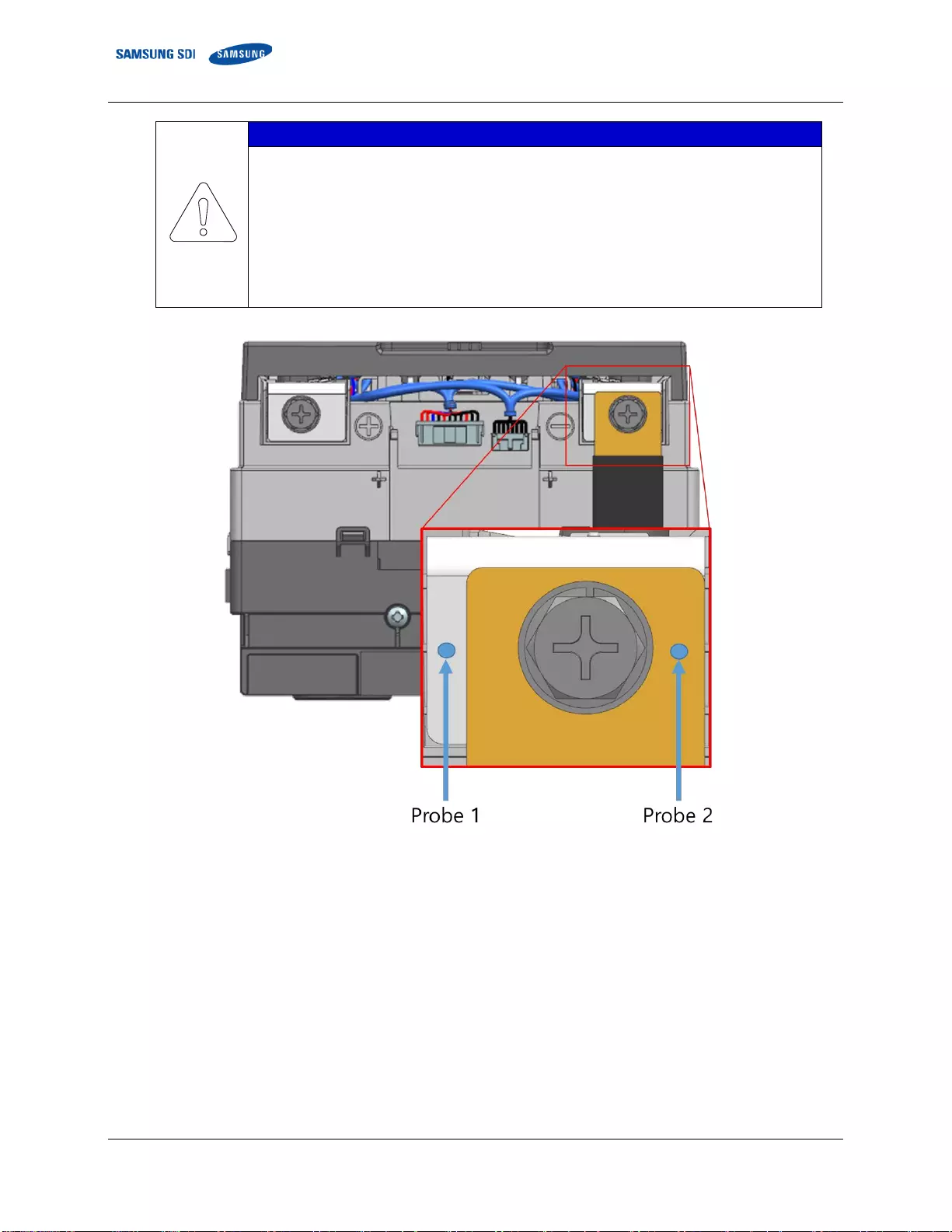
3. Installing the Product
44 English 7/2020. Rev 0.41
NOTICE
After connecting the busbar to the terminals (battery module, SMU, fuse), measure the contact
resistance between the terminals and the busbars using a low resistance meter. Refer to Figure
3-34: Contact Resistance Probe Points (Battery Module Terminal to Busbar) for location of the
measurement. Use similar probe locations for SMU terminal to busbar contact resistance, and
fuse to busbar contact resistance. Make sure each probe is in contact with only the intended
location.
The contact resistance must be measured below 40μΩ. It is recommended to keep the contact
resistance in all terminals below 30μΩ.
Figure 3-34: Contact Resistance Probe Points (Battery Module Terminal to Busbar)
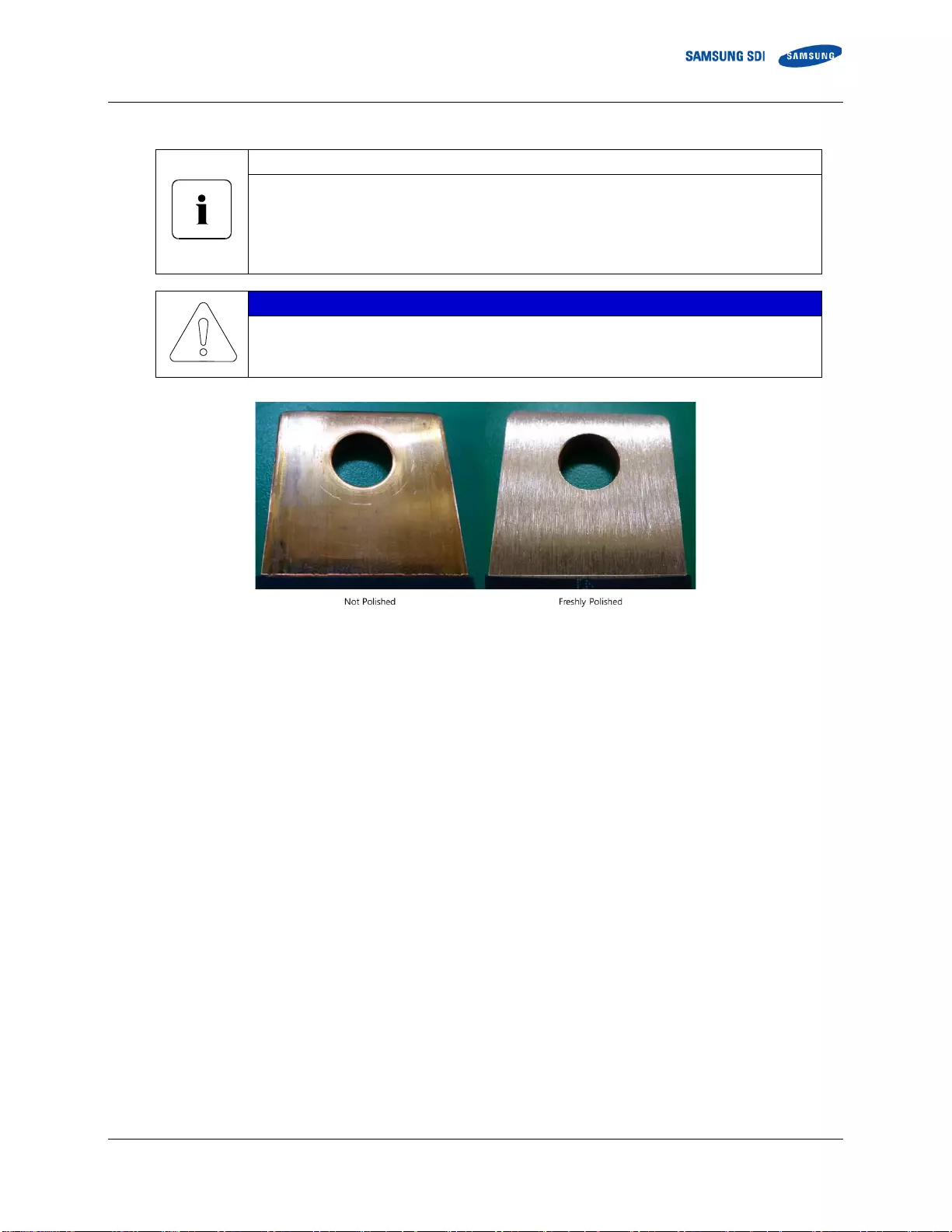
3. Installing the Product
English 7/2020. Rev 0.41 45
Important
For contacts with contact resistance that are greater than 40μΩ, it is recommended to polish
the joining surface of the bus bars with a fine abrasive material (grit 600 or higher) such as
sandpaper or scrubbing pad. Polish until the surface is evenly scratched and the color is
equivalent of “freshly polished” on color chart used in ASTM D-130 Copper Strip Corrosion
Standards. Refer to Figure 3-35: Copper Busbar Appearance.
NOTICE
After polishing the busbar, make sure the metallic particle does not settle on the electronics.
Clean the surface with a dry cloth before assembling the busbar to the terminal.
Figure 3-35: Copper Busbar Appearance
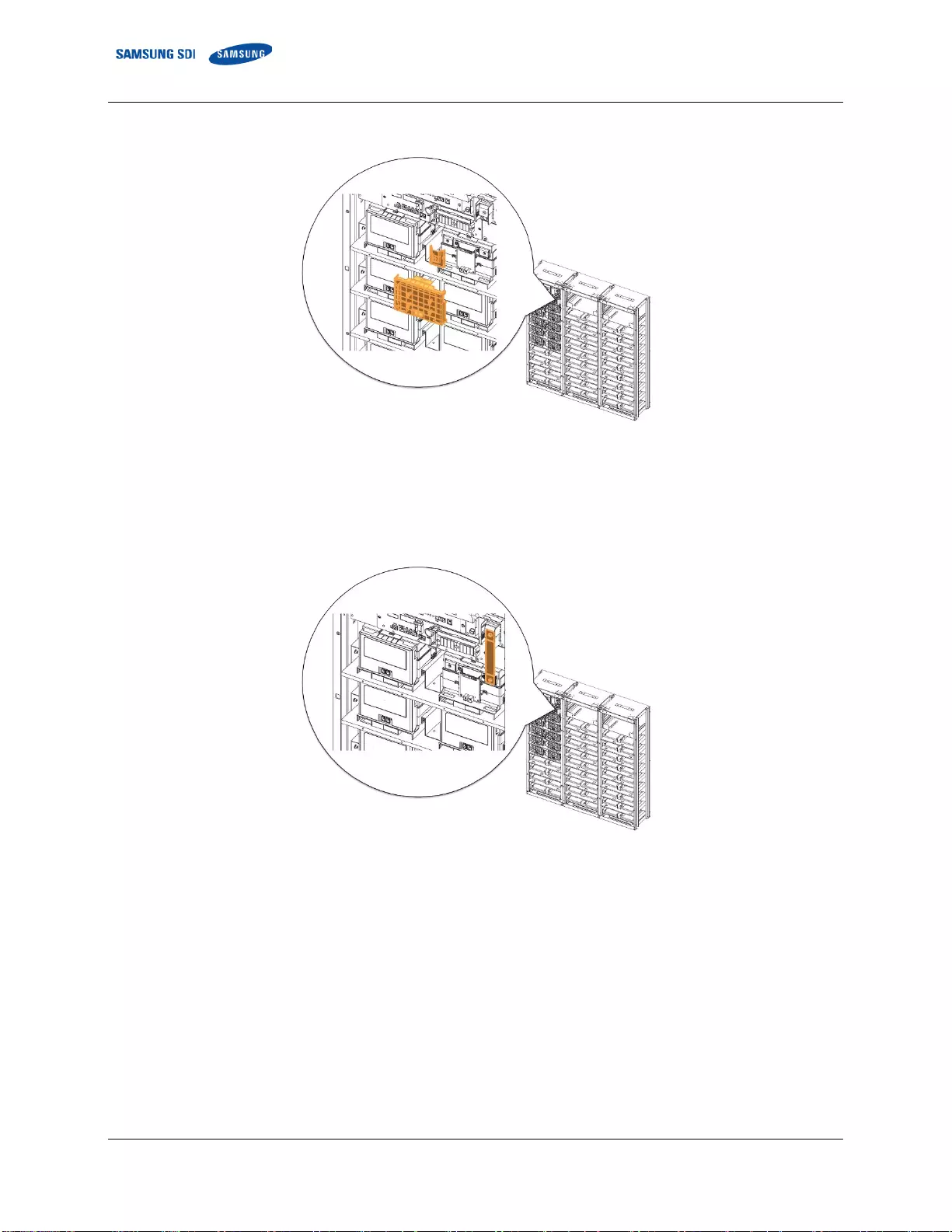
3. Installing the Product
46 English 7/2020. Rev 0.41
1. Remove Battery Module #1’s front cover and the SMU B- terminal cover.
Figure 3-36: Removing the Module #1’s Cover and SMU B- Terminal Cover
2. Connect SMU B- and Module #1 B- using “BUSBAR M TO SMU.” SMU B- terminal is connected using an M12 screw and
Battery Module #1 B- terminal is connected using an M8 screw. Measure the contact resistance between the terminals and
the bus bar.
Figure 3-37: Connect SMU B- and Module #1 B-
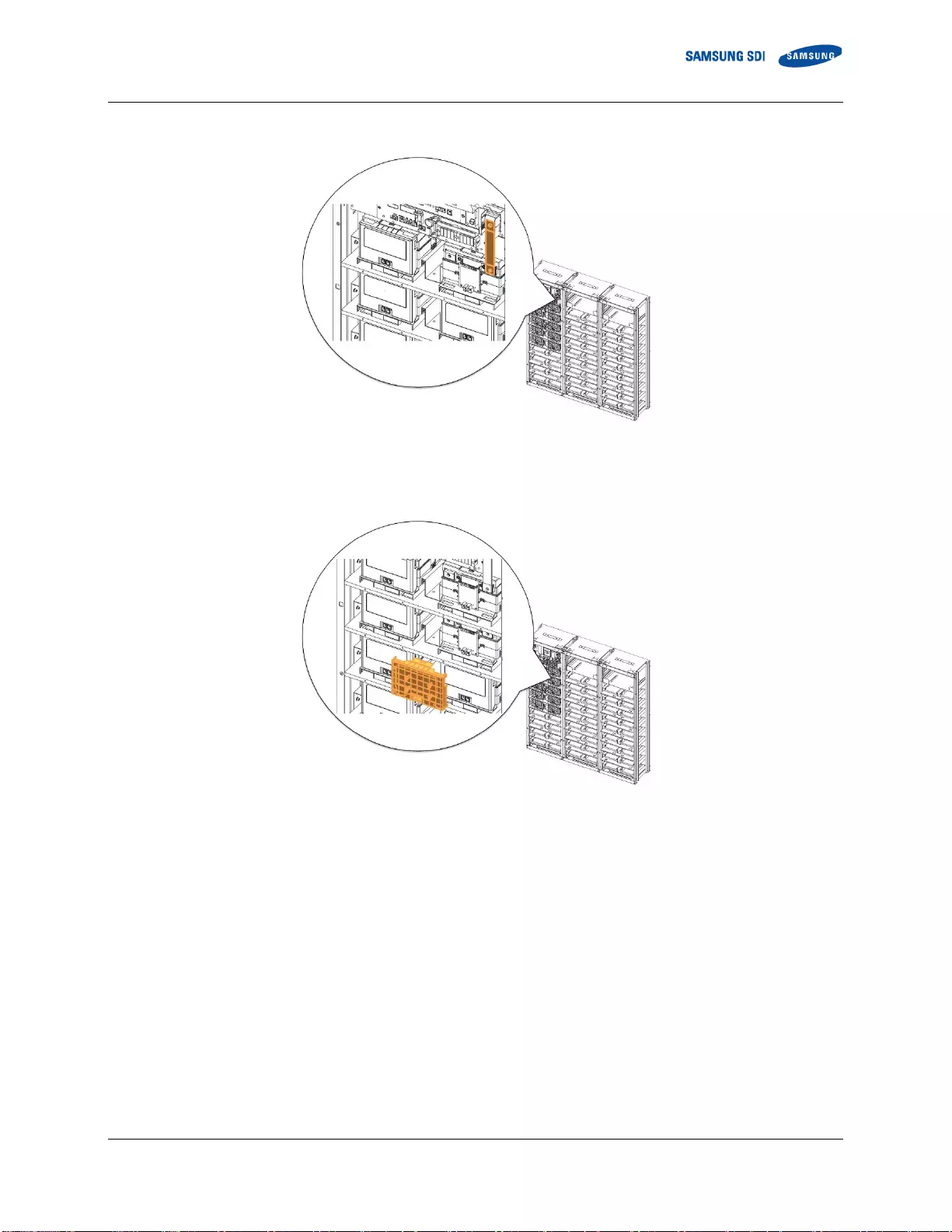
3. Installing the Product
English 7/2020. Rev 0.41 47
3. Reattach SMU’s B- terminal cover.
Figure 3-38: Restore SMU’s B- Terminal
4. Remove Battery Module #2’s front cover.
Figure 3-39: Remove Battery Module #2’s Front Cover
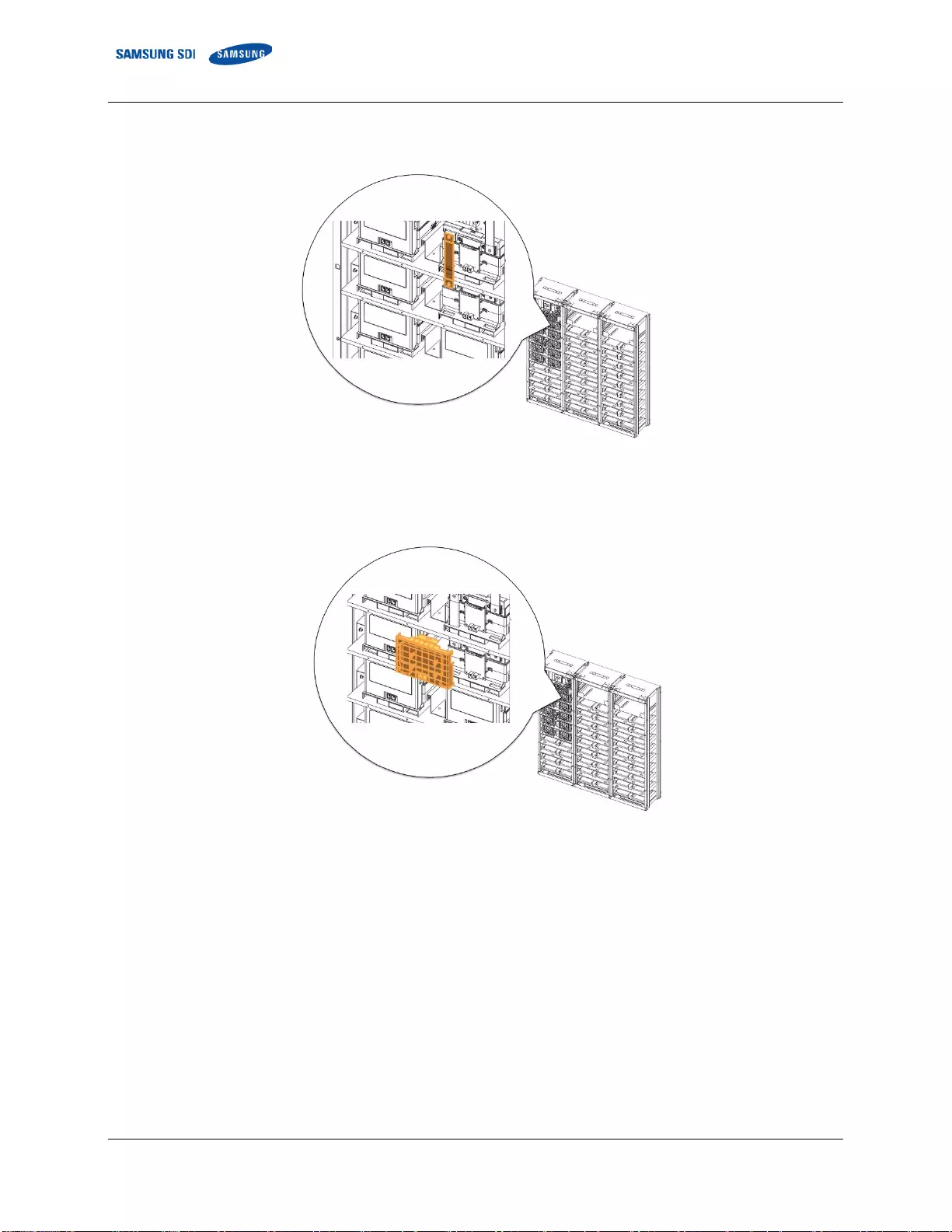
3. Installing the Product
48 English 7/2020. Rev 0.41
5. Connect Battery Module #1 B+ and Module #2 B- using “BUS-BAR MAIN.” Connect using an M8 screw. Measure the contact
resistance between the terminal and the bus bar.
Figure 3-40: Connect Battery Module #1 B+ and Battery Module #2 B-.
6. Reattach Battery Module #1’s front cover and remove Battery Module #3’s front cover.
Figure 3-41: Reattach Battery Module #1’s Front Cover
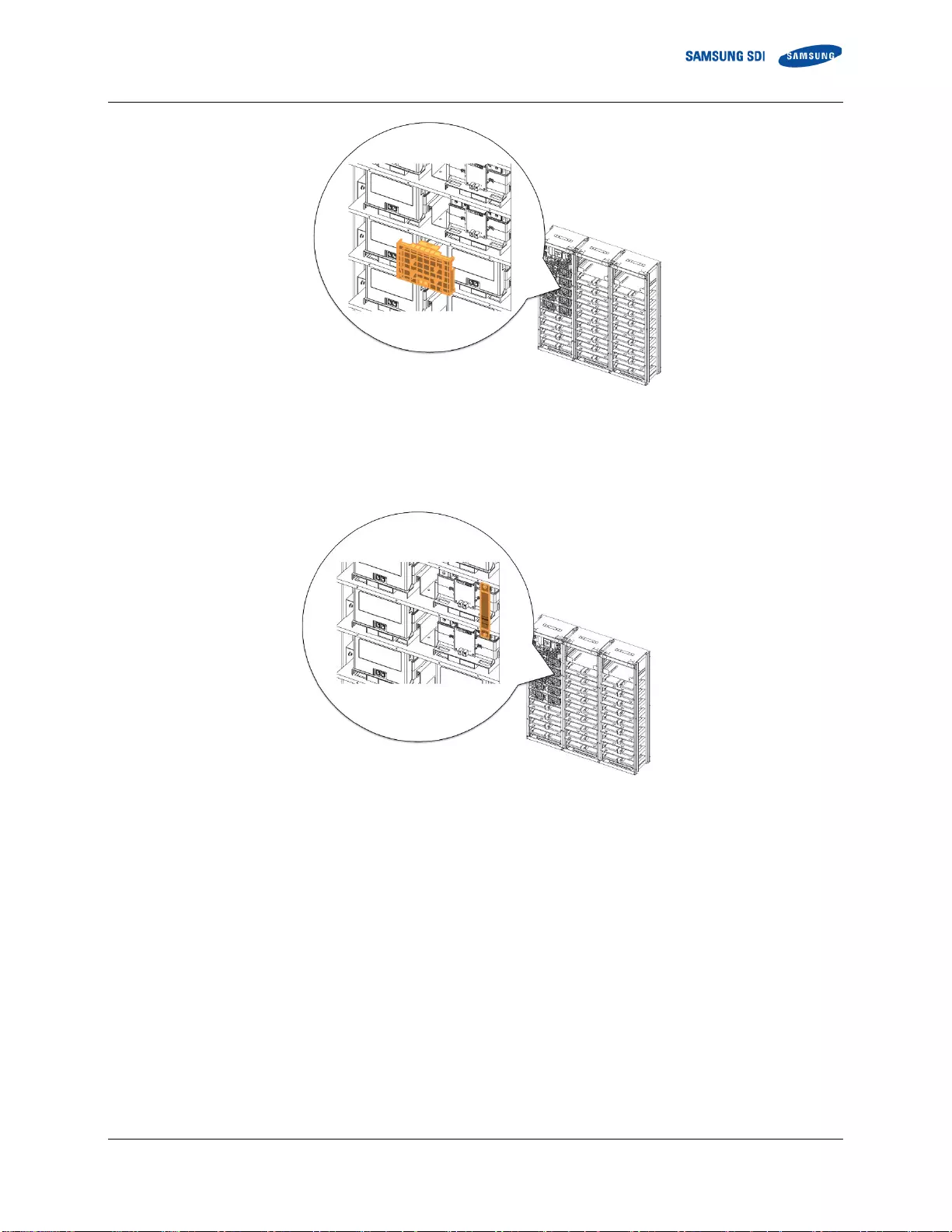
3. Installing the Product
English 7/2020. Rev 0.41 49
Figure 3-42: Remove Battery Module #2’s Front Cover
7. Connect Battery Module #2 B+ and Battery Module #3 B- using “BUS-BAR MAIN.” Connect using an M8 screw. Measure the
contact resistance between the terminal and the bus bar.
Figure 3-43: Connect Battery Module #2 B+ and Battery Module #3 B-.
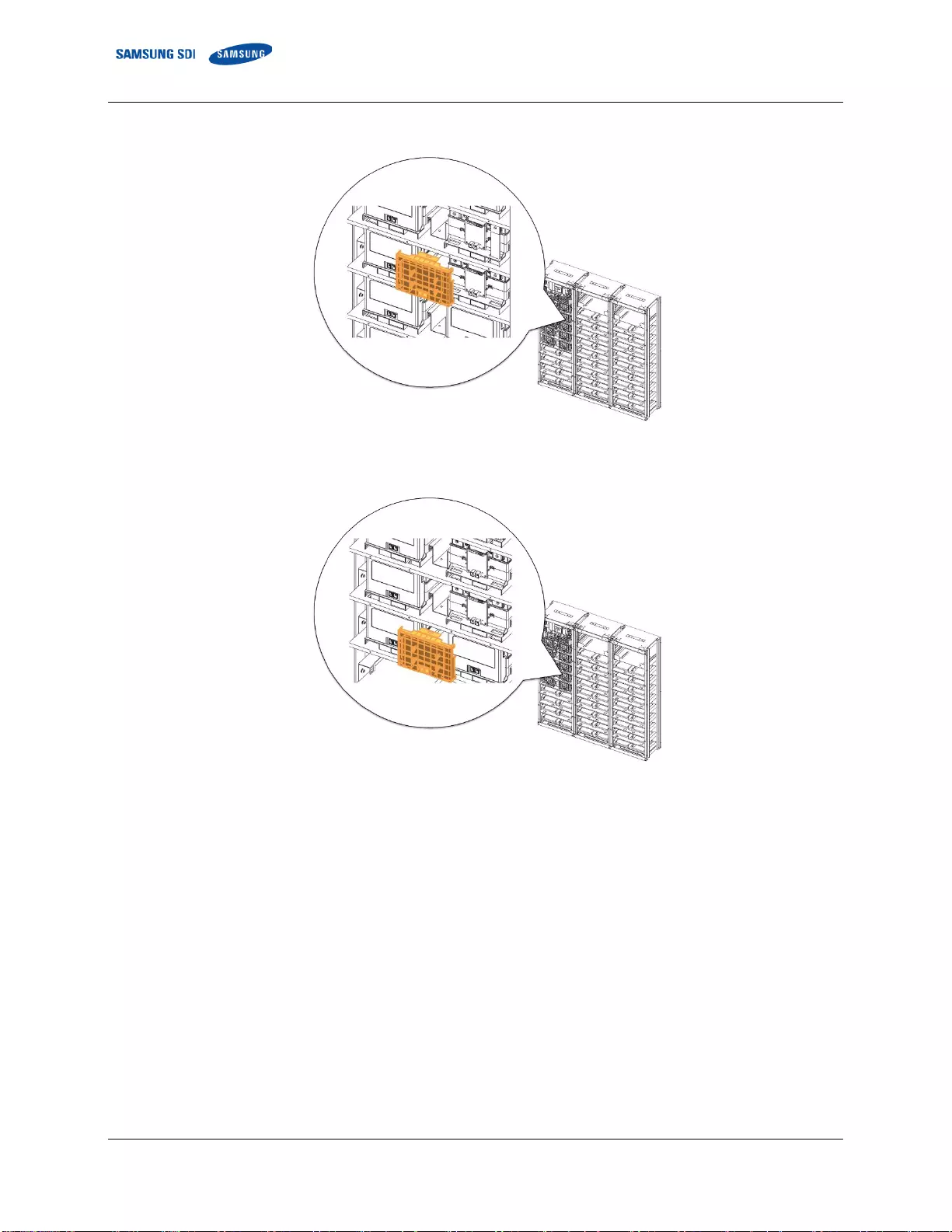
3. Installing the Product
50 English 7/2020. Rev 0.41
8. Reattach Battery Module #2’s front cover and remove Battery Module #4’s front cover.
Figure 3-44: Reattach Battery Module #2’s Front Cover
Figure 3-45: Remove Battery Module #4’s Front Cover
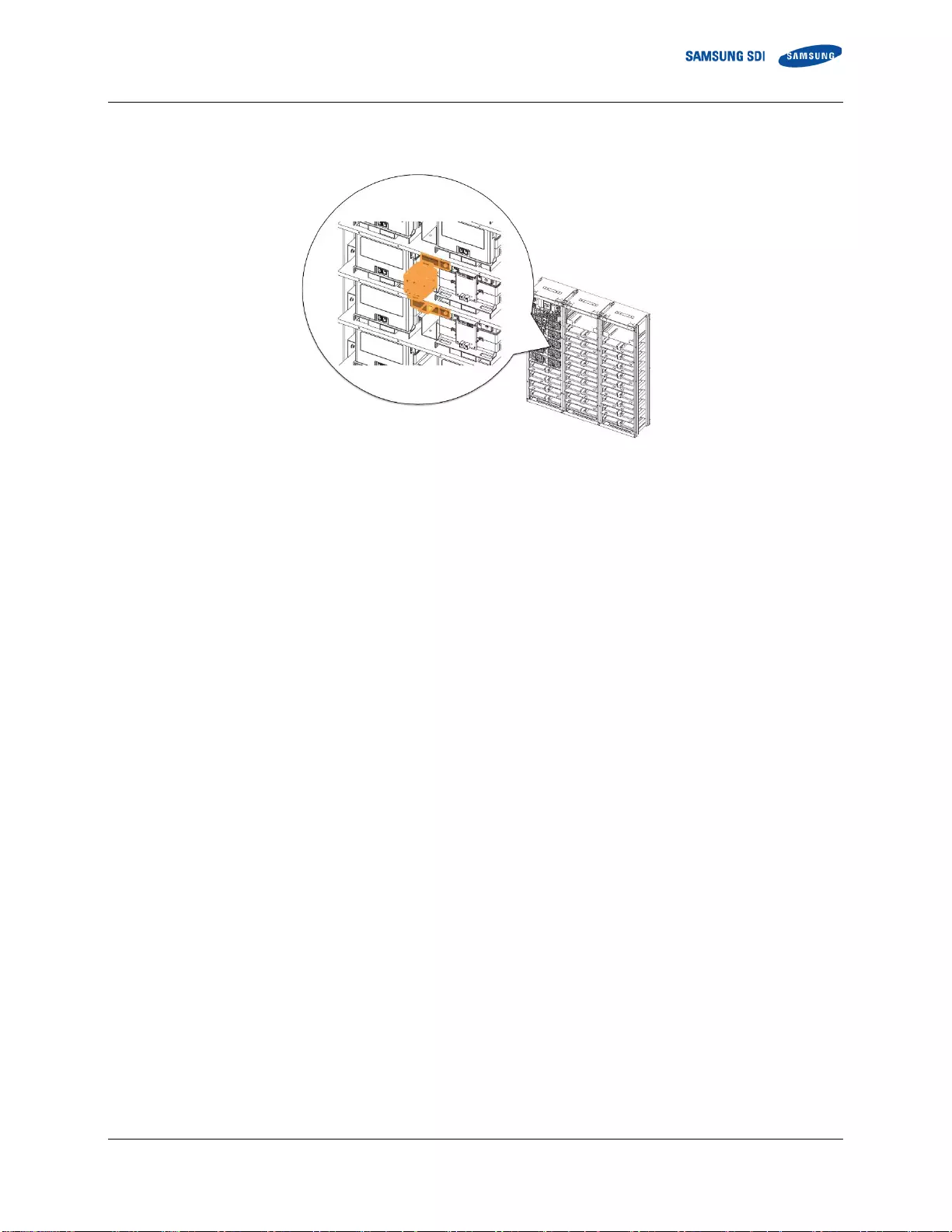
3. Installing the Product
English 7/2020. Rev 0.41 51
9. Connect Battery Module #3 B+ and Module #4 B- using “FUSE BUSBAR RIGHT ASSEMBLY”. Connect using an M8 screw.
Measure the contact resistance between the terminal and the bus bar.
Figure 3-46: Connect Battery Module #3 B+ and Module #4 B-.
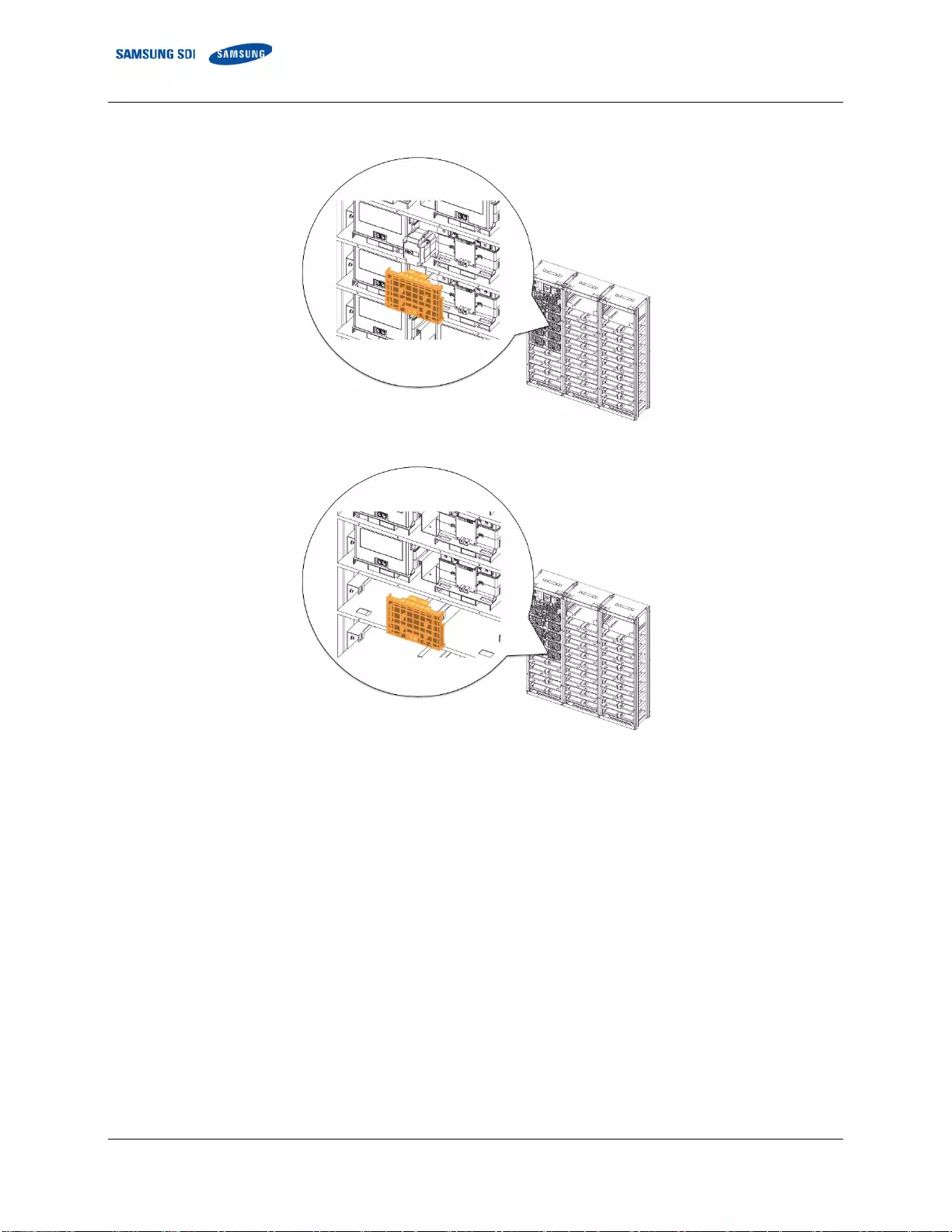
3. Installing the Product
52 English 7/2020. Rev 0.41
10. Reattach Battery Module #3’s front cover and remove Battery Module #5’s front cover.
Figure 3-47: Reattach Battery Module #3’s Front Cover
Figure 3-48: Remove Battery Module #5’s Front Cover
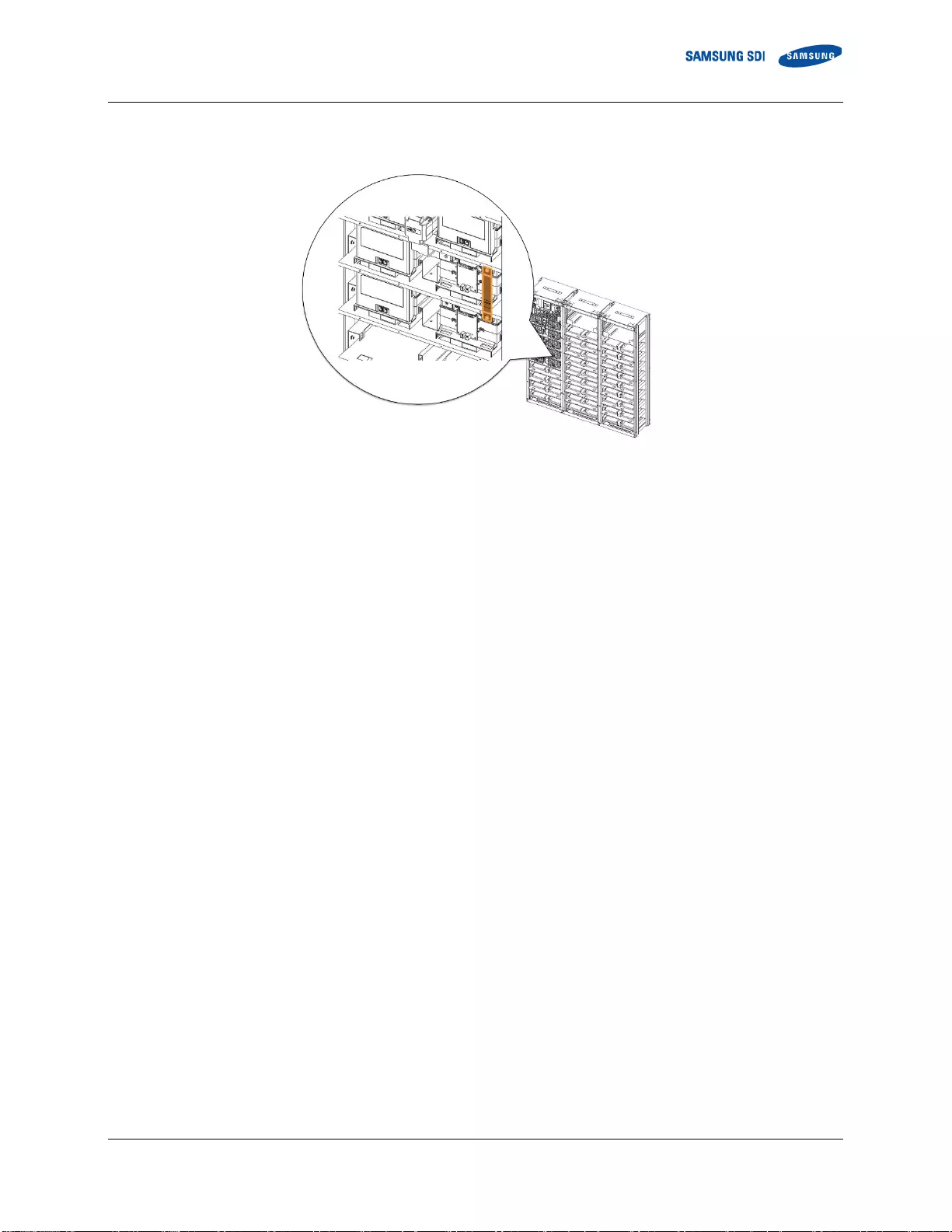
3. Installing the Product
English 7/2020. Rev 0.41 53
11. Connect Battery Module #4 B+ and Battery Module #5 B- using “BUS-BAR MAIN.” Connect using an M8 screw. Measure the
contact resistance between the terminal and the bus bar.
Figure 3-49: Connect Battery Module #4 B+ and Battery Module #5 B-.
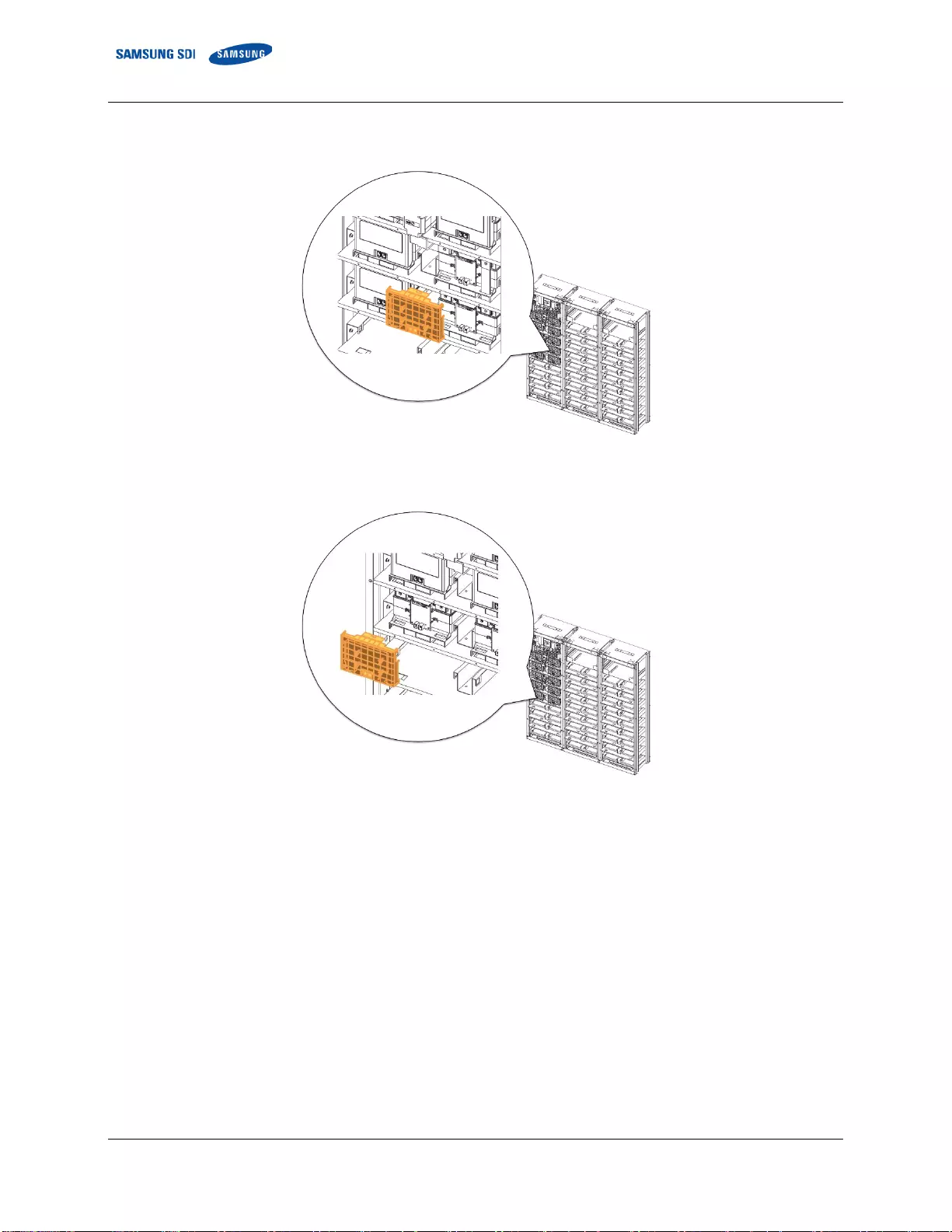
3. Installing the Product
54 English 7/2020. Rev 0.41
12. Reattach Battery Module #4’s front cover and remove Battery Module #6’s front cover.
Figure 3-50: Reattach Battery Module #4’s Front Cover
Figure 3-51: Remove Battery Module #6’s Front Cover
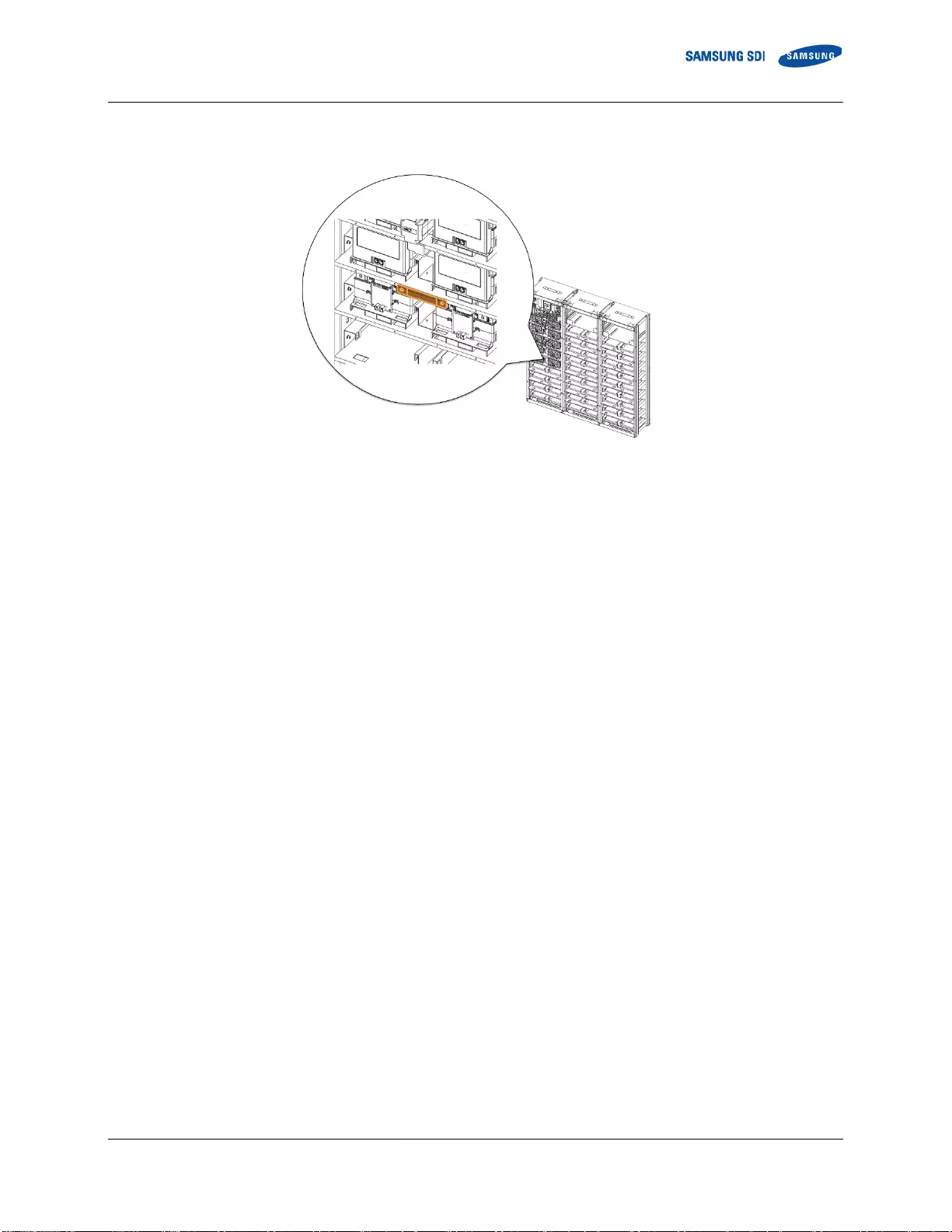
3. Installing the Product
English 7/2020. Rev 0.41 55
13. Connect Battery Module #5 B+ and Battery Module #6 B- using “BUSBAR 80S”. Connect using an M8 screw. Measure the
contact resistance between the terminal and the bus bar.
Figure 3-52: Connect Battery Module #5 B+ and Battery Module #6 B-.
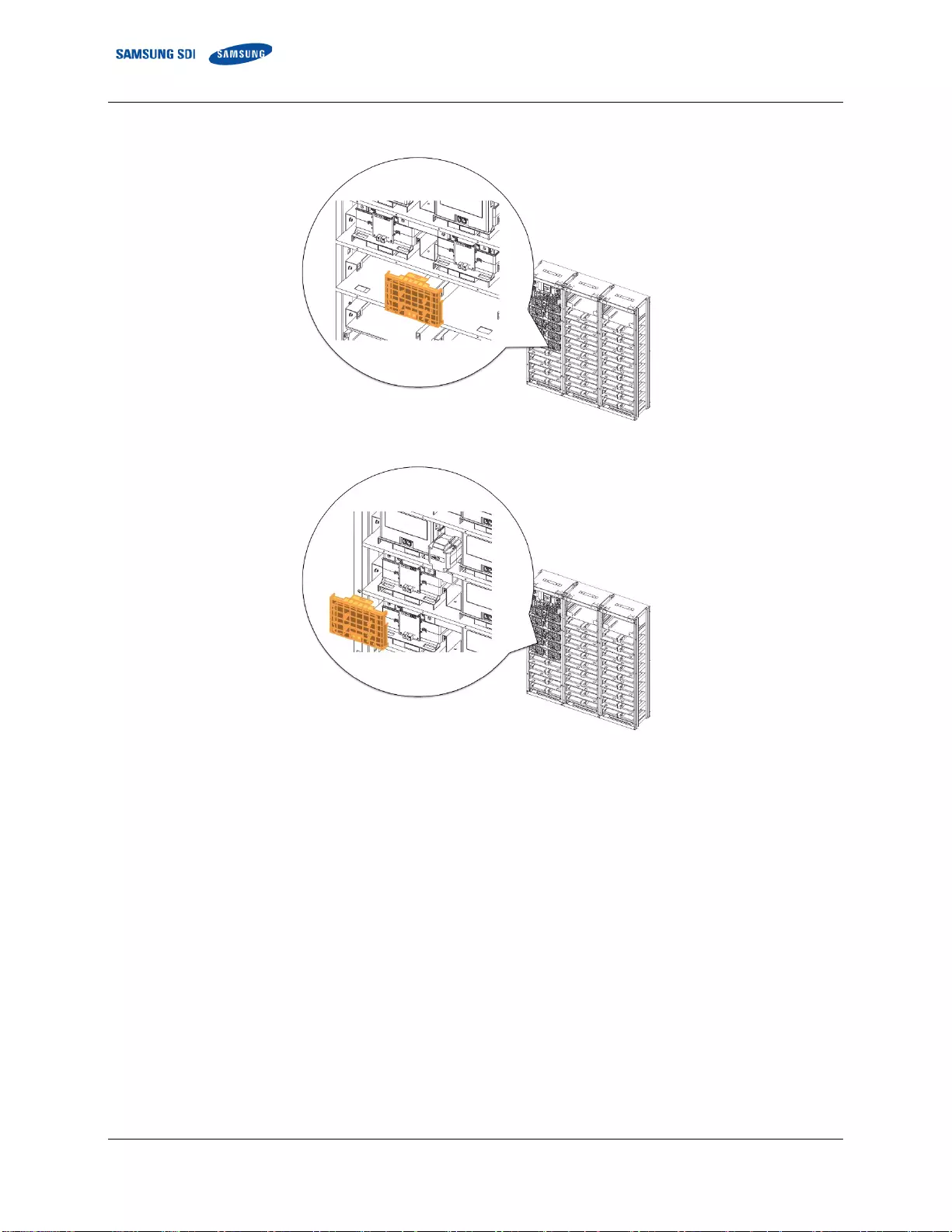
3. Installing the Product
56 English 7/2020. Rev 0.41
14. Reattach Battery Module #5’s front cover and remove Battery Module #7’s front cover.
Figure 3-53: Reattach Battery Module #5’s Front Cover
Figure 3-54: Remove Battery Module #7’s Front Cover
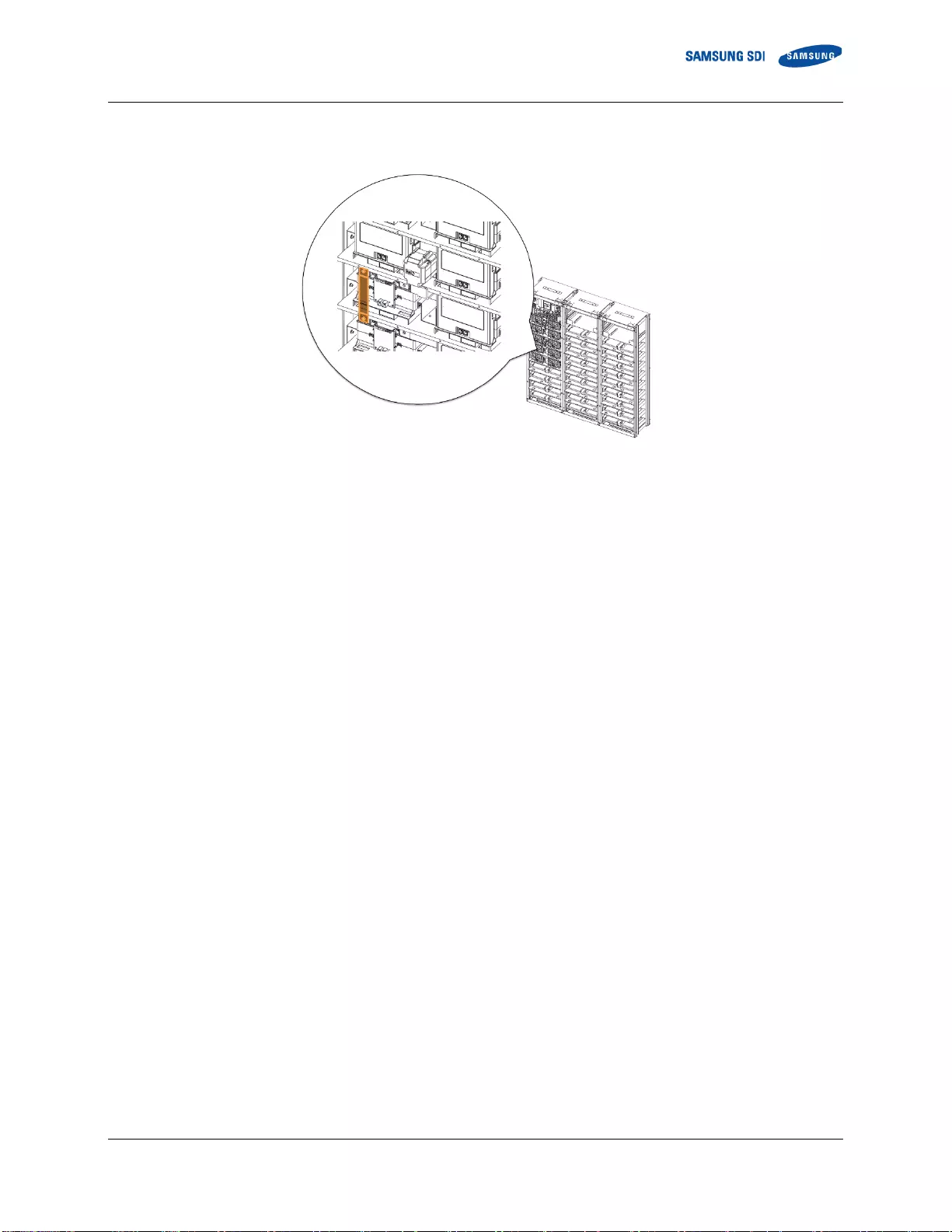
3. Installing the Product
English 7/2020. Rev 0.41 57
15. Connect Battery Module #6 B+ and Battery Module #7 B- using “BUS-BAR MAIN.” Connect using an M8 screw. Measure the
contact resistance between the terminal and the bus bar.
Figure 3-55: Connect Battery Module #6 B+ and Battery Module #7 B-
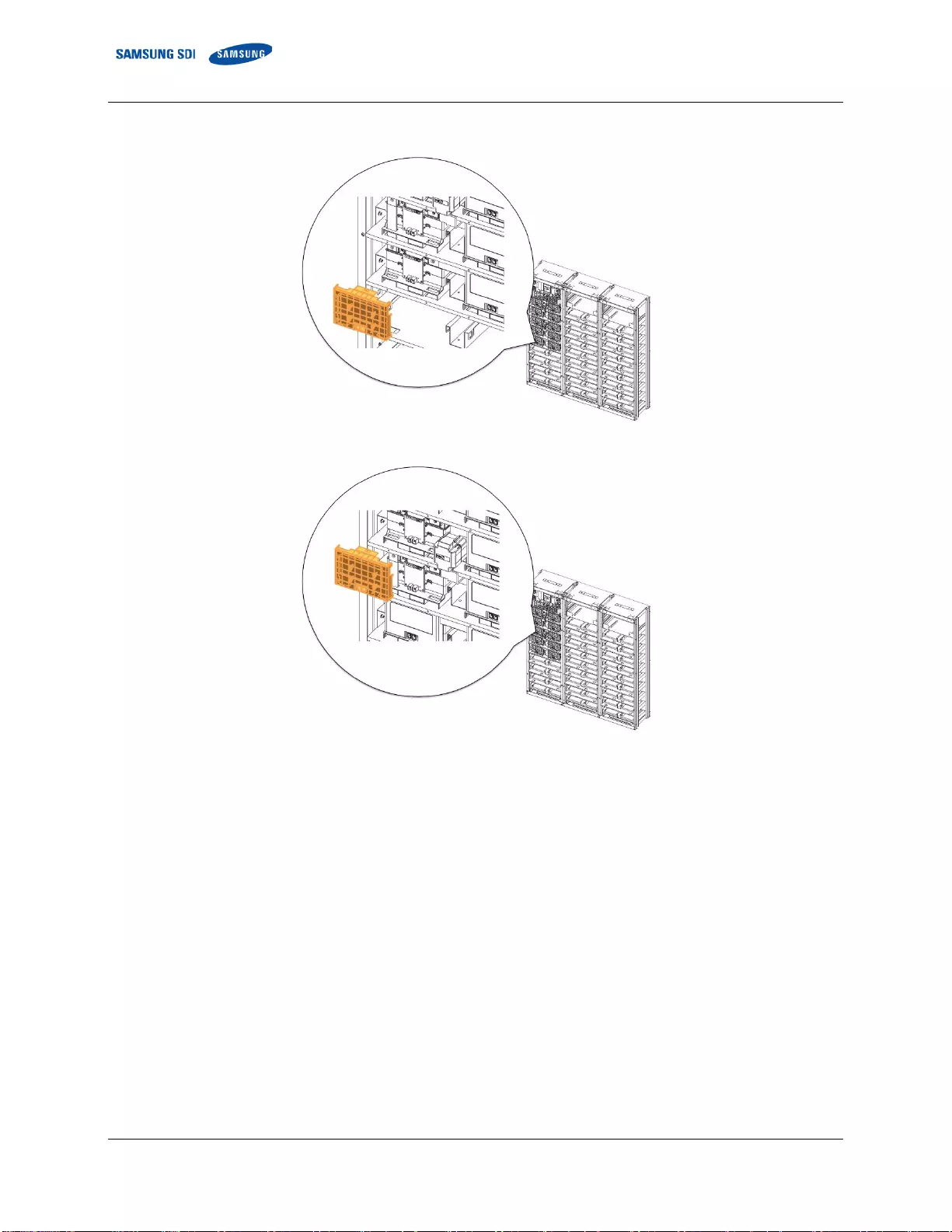
3. Installing the Product
58 English 7/2020. Rev 0.41
16. Reattach Battery Module #6’s front cover and remove Battery Module #8’s front cover.
Figure 3-56: Reattach Battery Module #6’s Front Cover
Figure 3-57: Remove Battery Module #8’s Front Cover
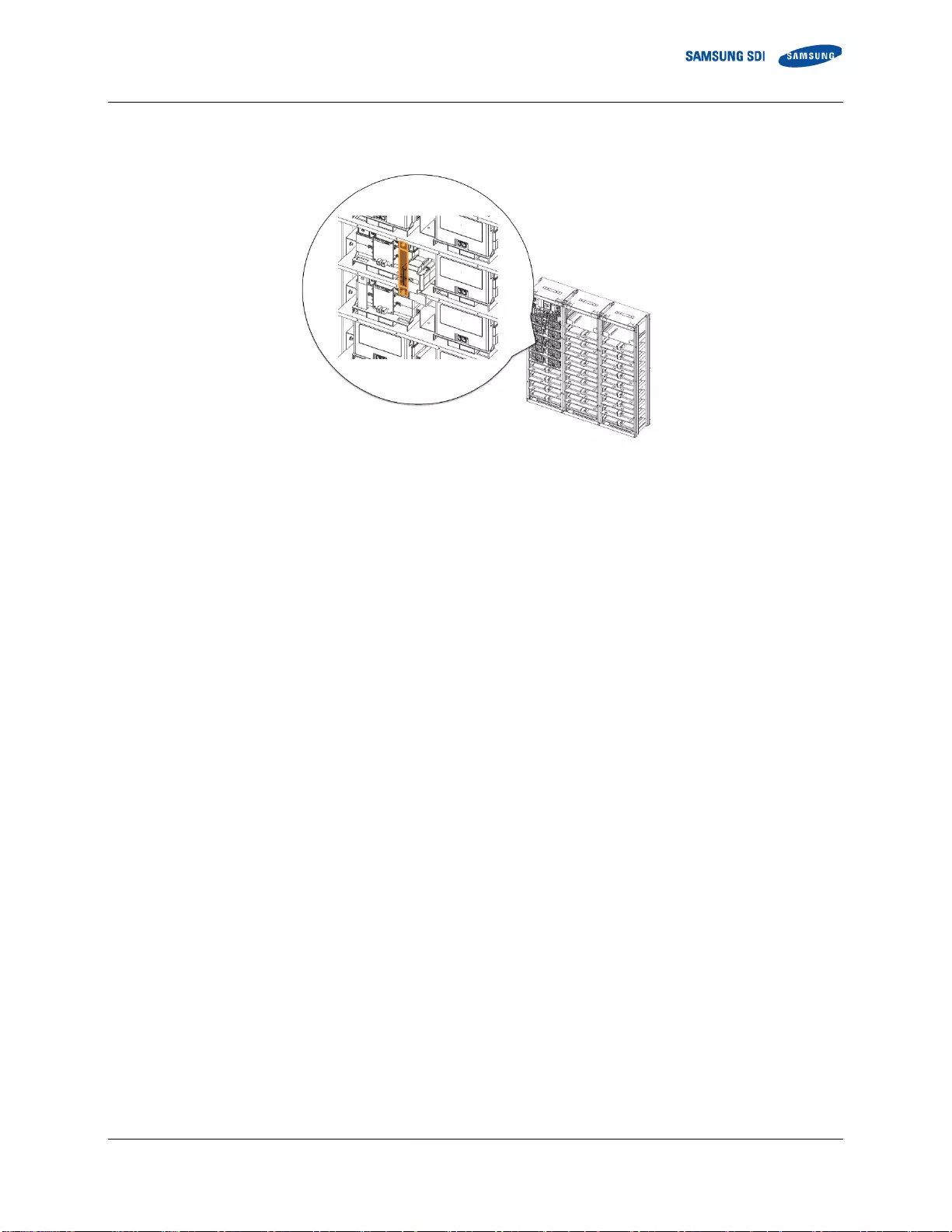
3. Installing the Product
English 7/2020. Rev 0.41 59
17. Connect Battery Module #7 B+ and Battery Module #8 B- using “BUS-BAR MAIN.” Connect using an M8 screw. Measure the
contact resistance between the terminal and the bus bar.
Figure 3-58: Connect Battery Module #7 B+ and Battery Module #8 B-
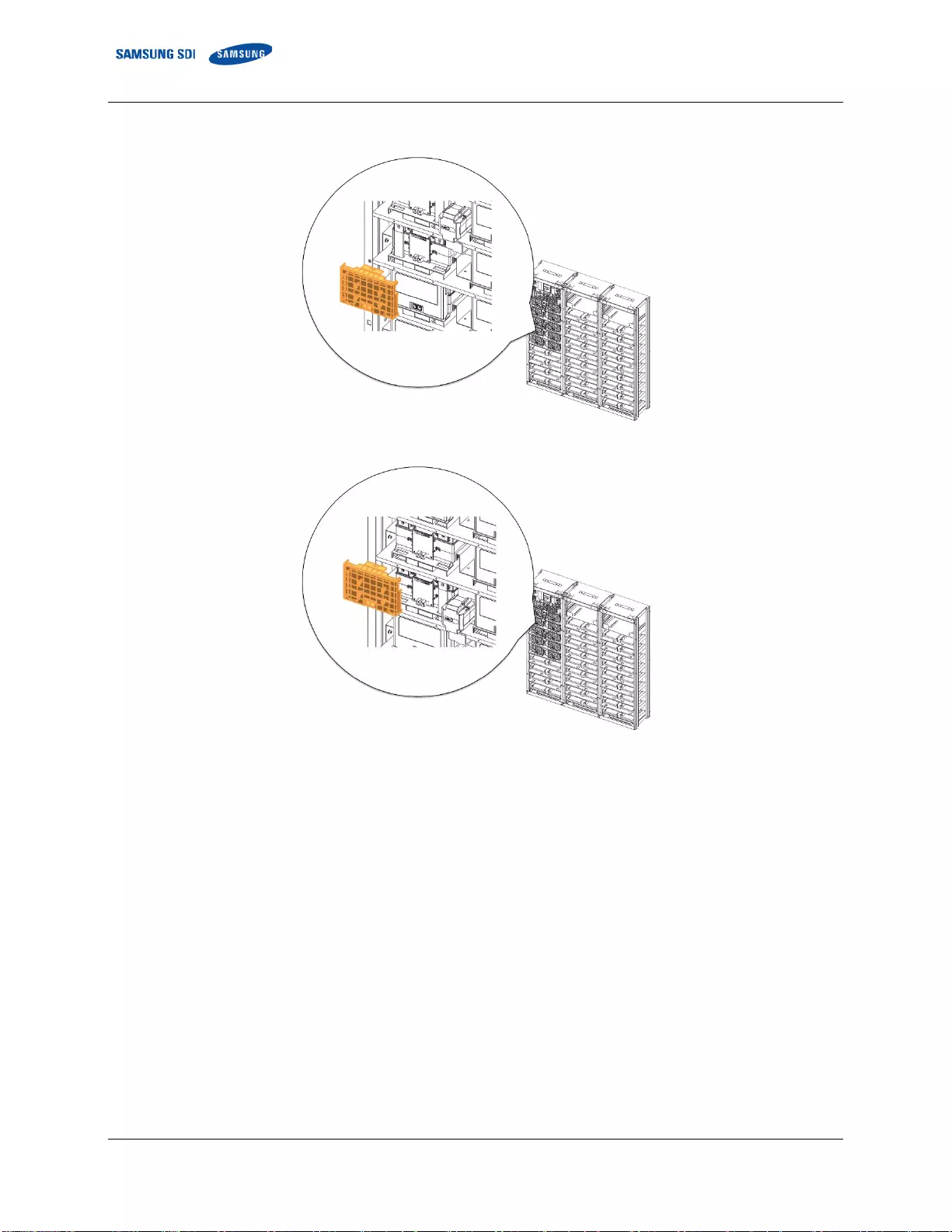
3. Installing the Product
60 English 7/2020. Rev 0.41
18. Reattach Battery Modules #7’s front cover and remove Battery Modules #9’s front cover.
Figure 3-59: Reattach Battery Modules #7’s Front Cover
Figure 3-60: Remove Battery Modules #9’s Front Cover
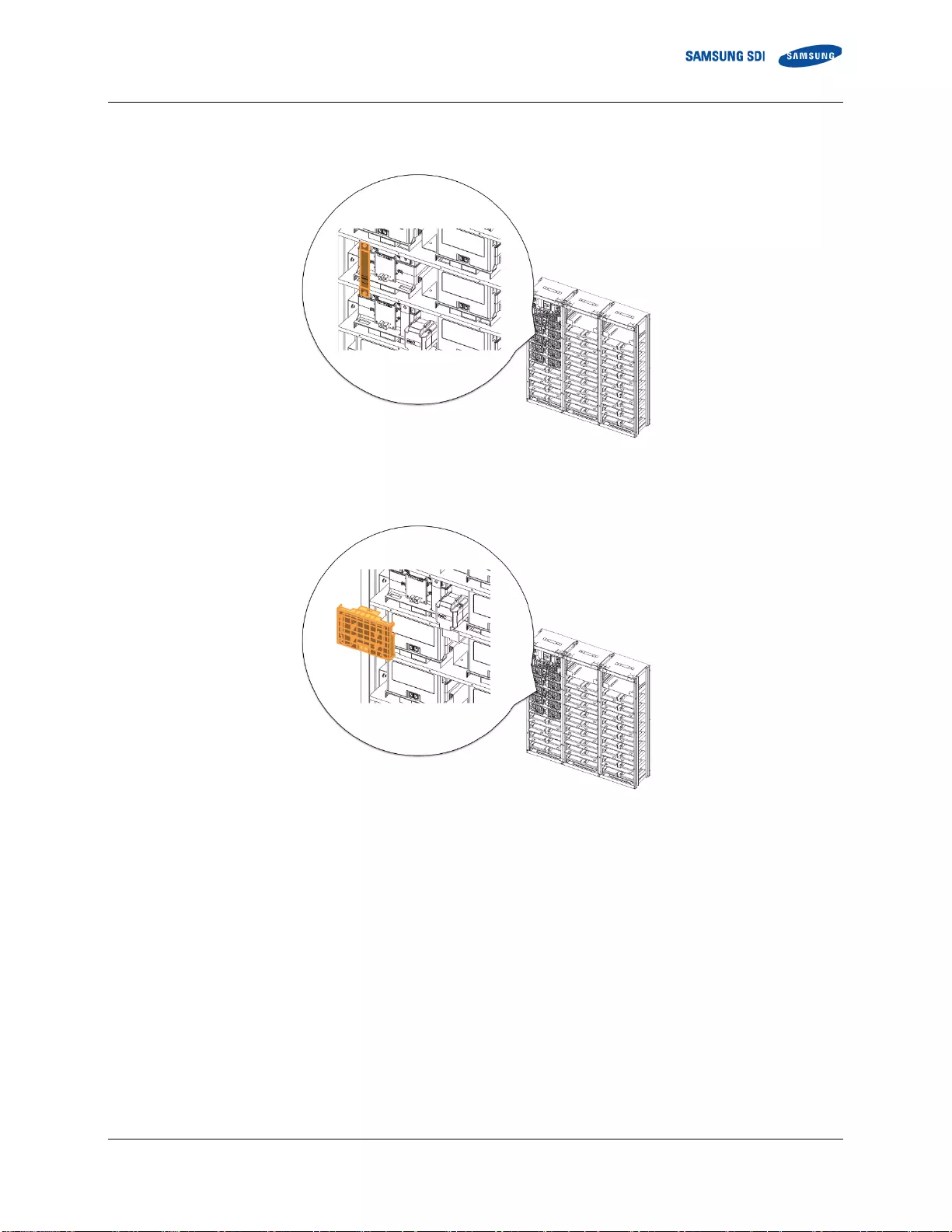
3. Installing the Product
English 7/2020. Rev 0.41 61
19. Connect Battery Module #8 B+ and Battery Module #9 B- using “BUS-BAR MAIN.” Connect using an M8 screw. Measure the
contact resistance between the terminal and the bus bar.
Figure 3-61: Connect Battery Module #8 B+ and Battery Module #9 B-.
20. Reattach Battery Module #8’s front cover and remove Battery Module #10’s front cover.
Figure 3-62: Reattach Battery Modules #8’s Front Cover
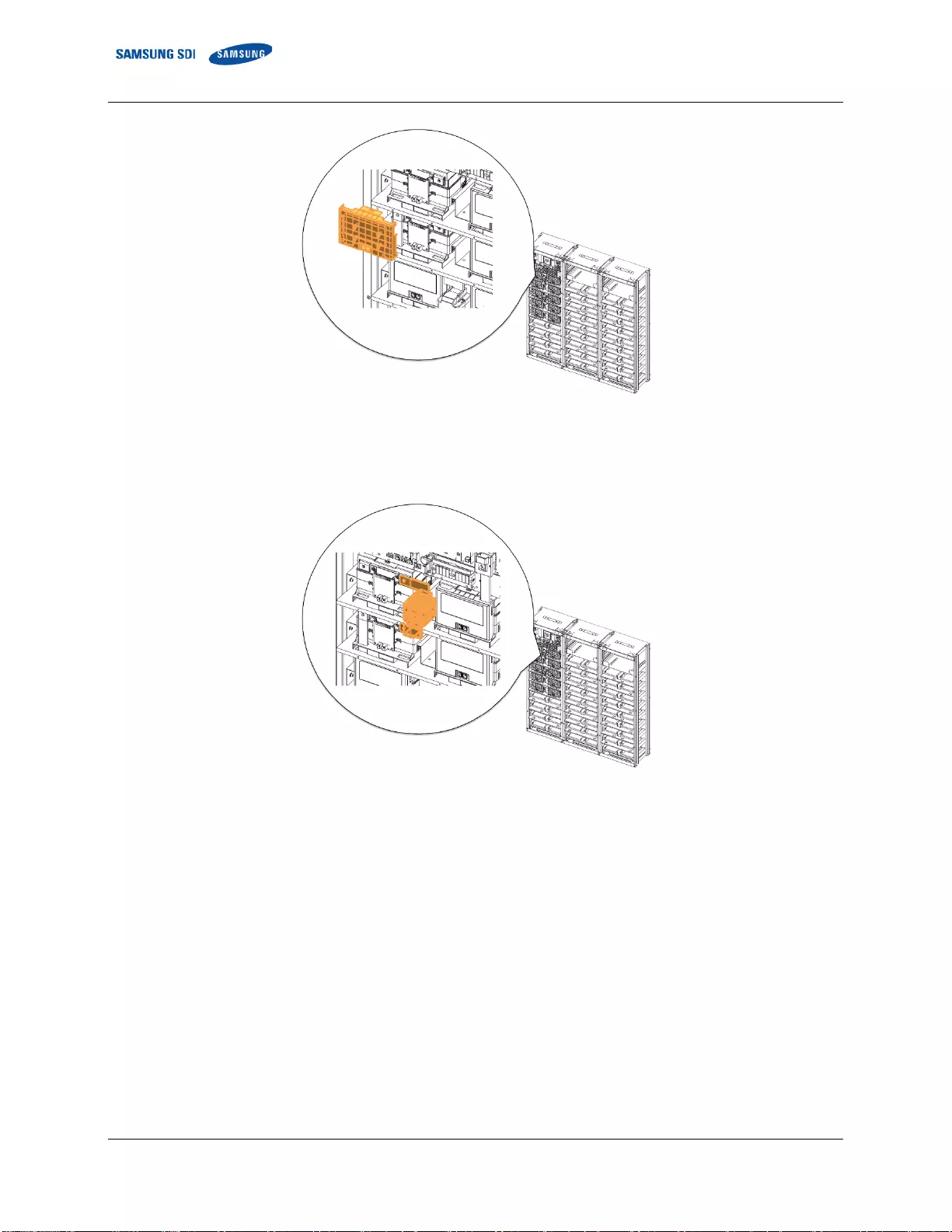
3. Installing the Product
62 English 7/2020. Rev 0.41
Figure 3-63: Remove Battery Modules #10’s Front Cover
21. Connect Battery Module #9 B+ and Battery Module #10 B- using “FUSE BUSBAR LEFT ASSEMBLY.” Connect using an M8 screw.
Measure the contact resistance between the terminal and the bus bar.
Figure 3-64 Connect Battery Module #9 B+ and Battery Module #10 B-.
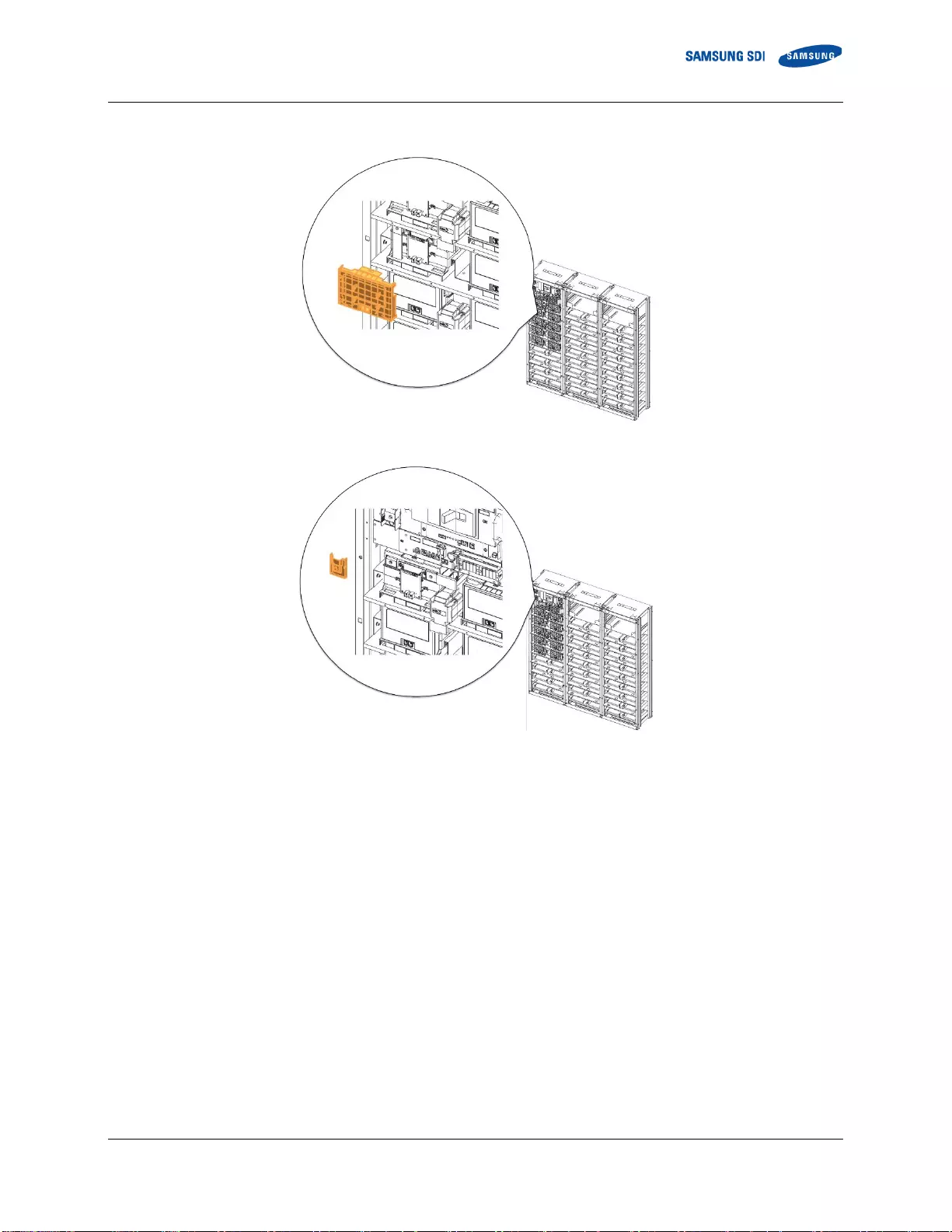
3. Installing the Product
English 7/2020. Rev 0.41 63
22. Reattach Battery Module #9’s front cover and remove SMU’s B+ terminal cover.
Figure 3-65: Reattach Battery Module #9’s Front Cover
Figure 3-66: Remove SMU B+ Terminal Cover
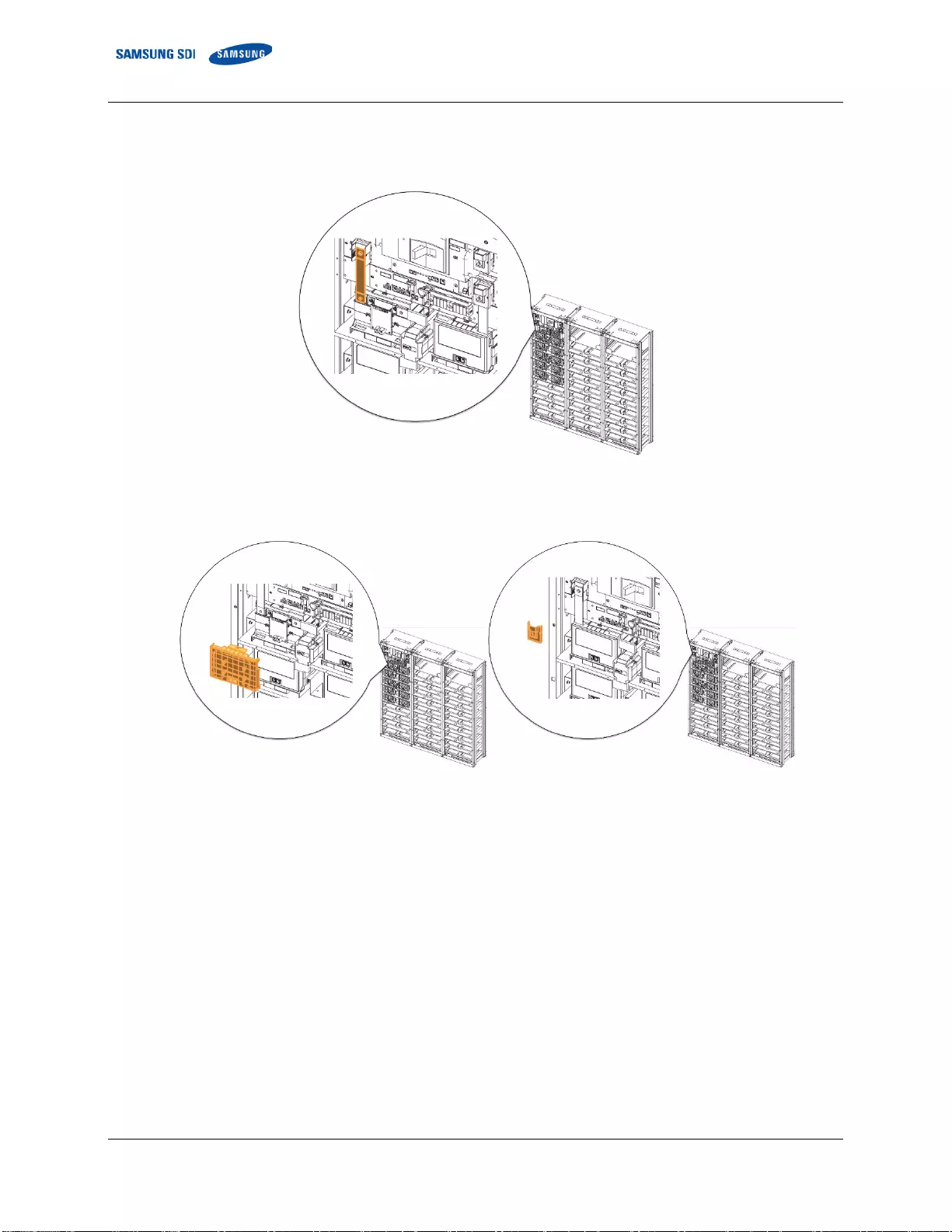
3. Installing the Product
64 English 7/2020. Rev 0.41
23. Connect SMU B+ and Battery Module #10 B+ using “BUSBAR M TO SMU.” SMU B+ terminal is connected using an M12xL25
screw and Module #10 B+ terminal is connected using an M8 screw. Measure the contact resistance between the terminal
and the bus bar.
Figure 3-67: Connect SMU B+ and Module #10 B+.
24. Reattach Battery Module #10’s front cover and SMU B+ terminal cover.
Figure 3-68: Reattach Battery Module #10’s Front Cover and SMU B+ Terminal Cover
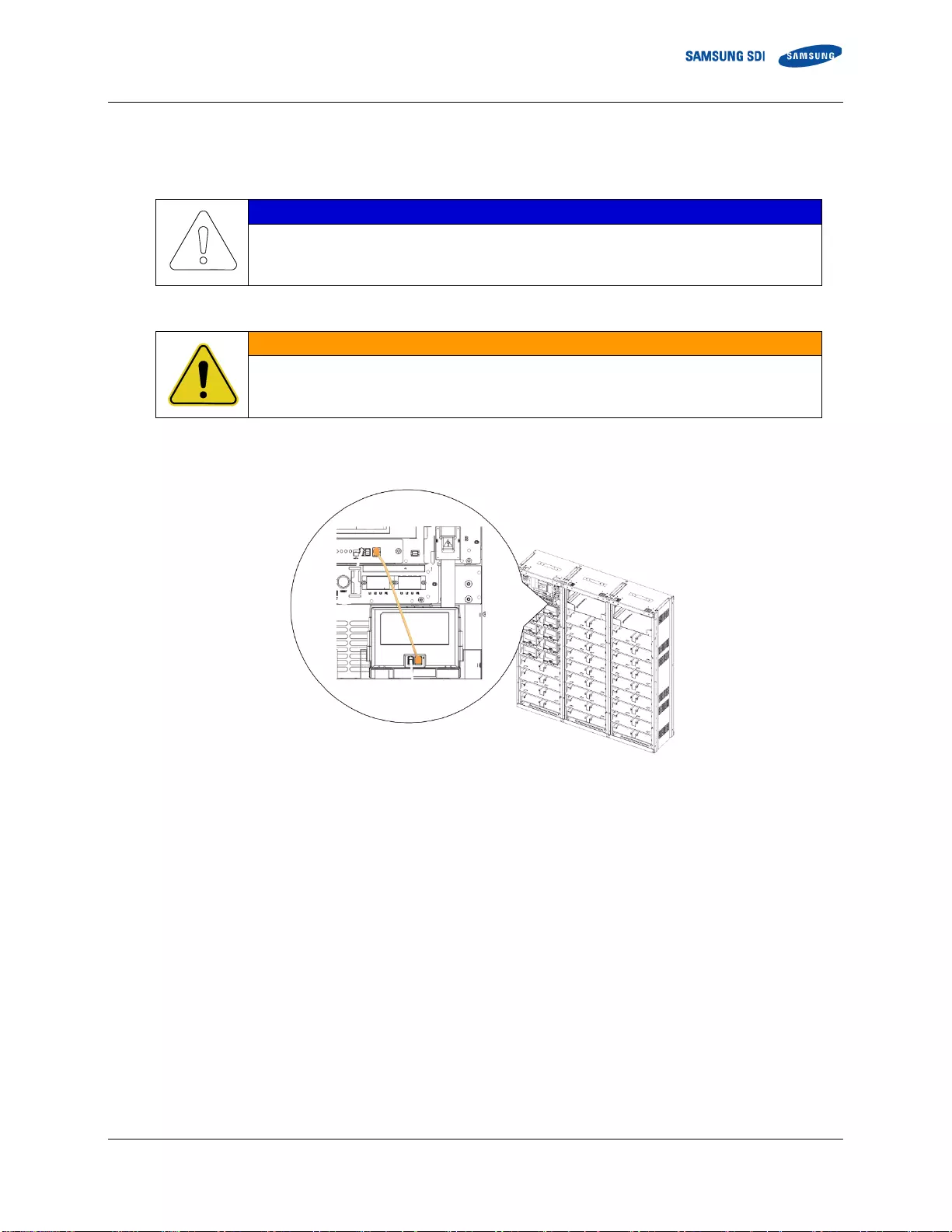
3. Installing the Product
English 7/2020. Rev 0.41 65
3.10.6 Module and SMU Signal Cable Connection
Connect the signal cables for SMU and Module BMS’s for each module.
NOTICE
Use the proper signal cables as specified by the part numbers below.
WARNING
Rack BMS / Module BMS Damage
Do not insert both ends of the signal cable WIRE ASSY MODULE TO MODULE #1 or WIRE ASSY
MODULE TO MODULE #2 into the same Battery Module.
1. Connect the signal cable “WIRE ASSY RACK TO MODULE” between the SMU “MODULE” connector and
Module #1 “Right Connector”.
Figure 3-69: SMU to Module #1 Signal Cable
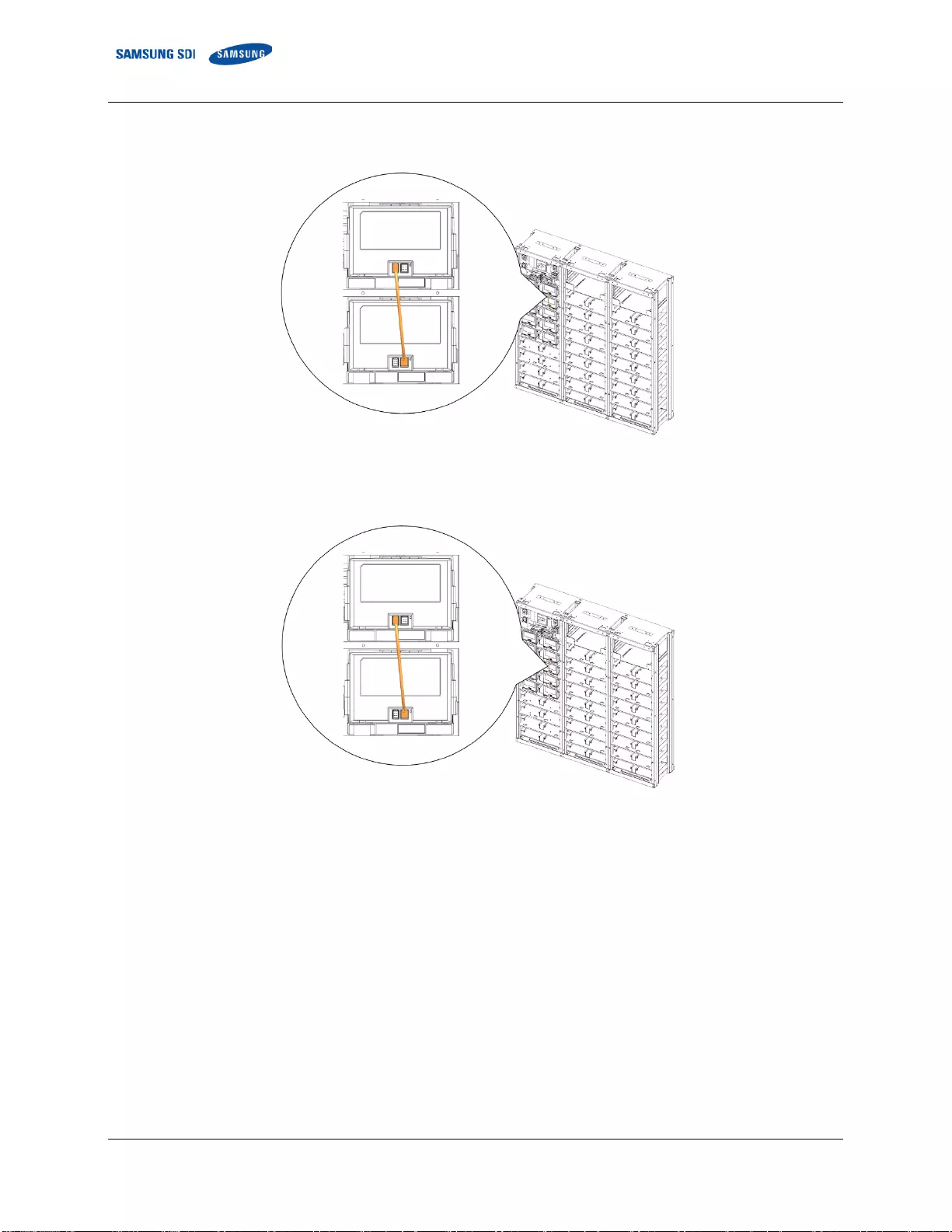
3. Installing the Product
66 English 7/2020. Rev 0.41
2. Connect the signal cable “WIRE ASSY MODULE TO MODULE #1" from Module #1 “Left Connector” to
Module #2 “Right Connector.”
Figure 3-70: Module #1 to Module #2 Signal Cabling
3. Connect the signal cable “WIRE ASSY MODULE TO MODULE #1" from Module #2 “Left Connector” to
Module #3 “Right Connector.”
Figure 3-71: Module #2 to Module #3 Signal Cabling
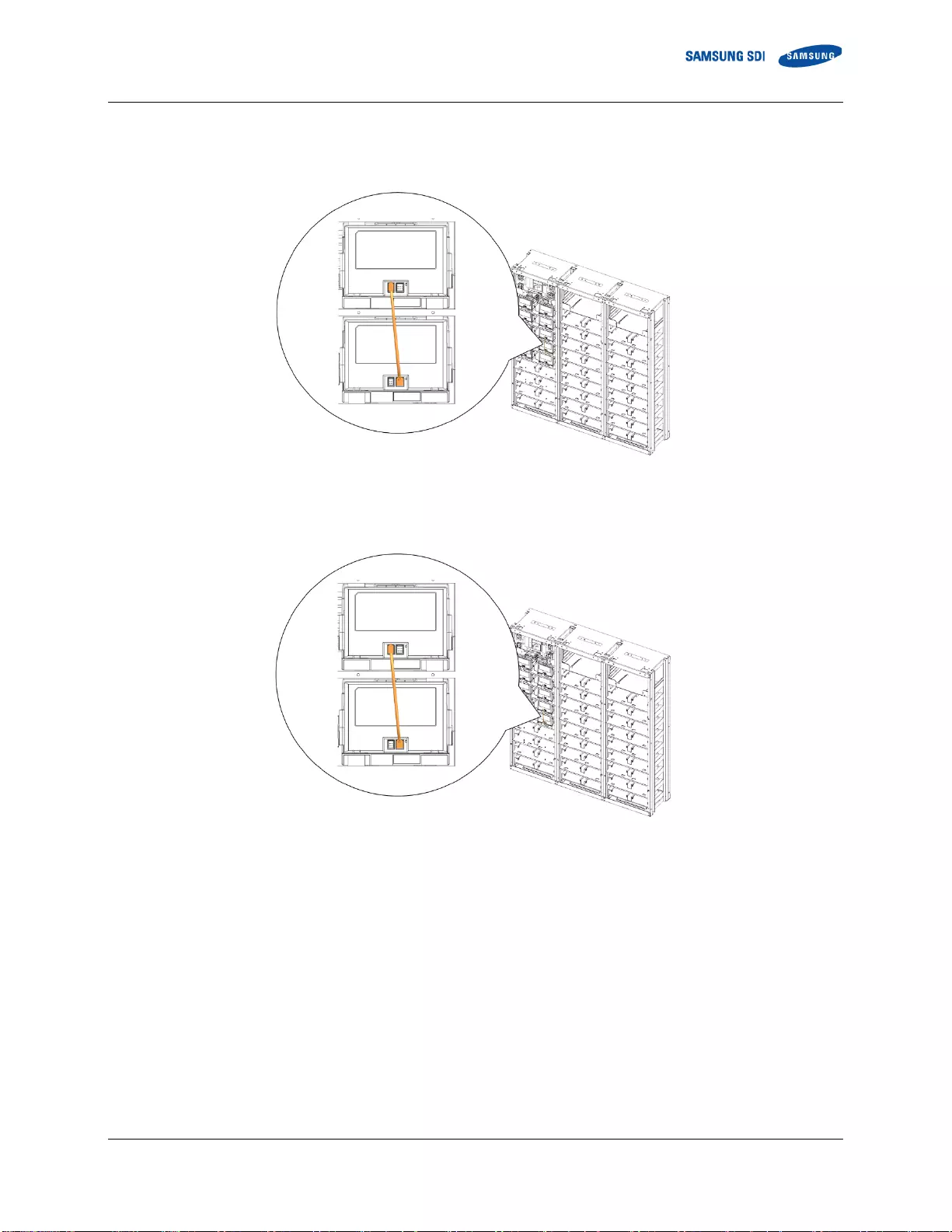
3. Installing the Product
English 7/2020. Rev 0.41 67
4. Connect the signal cable “WIRE ASSY MODULE TO MODULE #1" from Module #3 “Left Connector” to
Module #4 “Right Connector.”
Figure 3-72: Module #3 to Module #4 Signal Cabling
5. Connect the signal cable “WIRE ASSY MODULE TO MODULE #1" from Module #4 “Left Connector” to
Module #5 “Right Connector.”
Figure 3-73: Module #4 to Module #5 Signal Cabling
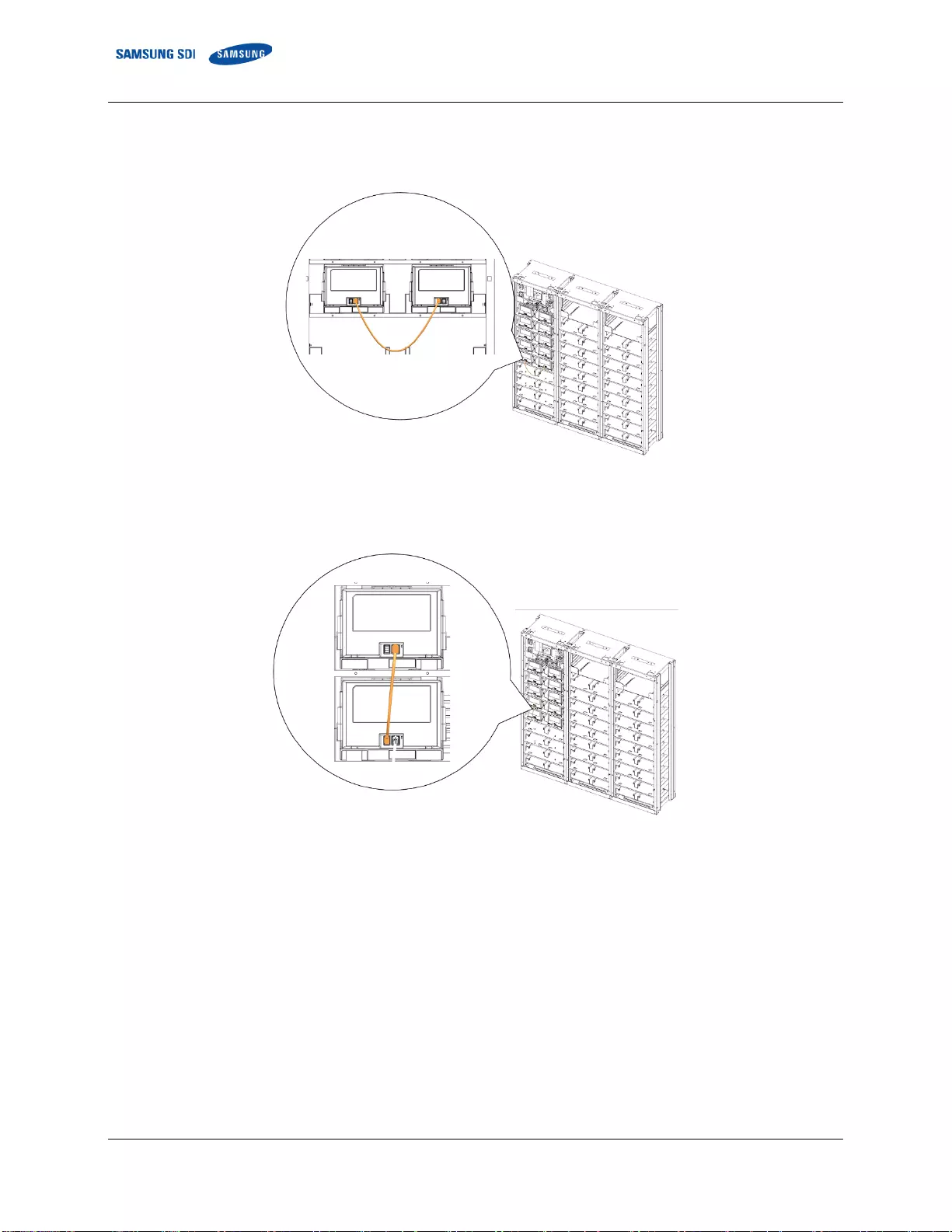
3. Installing the Product
68 English 7/2020. Rev 0.41
6. Connect the signal cable “WIRE ASSY MODULE TO MODULE #2" from Module #5 “Left Connector” to
Module #6“Right Connector”.
Figure 3-74: Module #5 to Module #6 Signal Cabling
7. Connect the signal cable “WIRE ASSY MODULE TO MODULE #1" from Module #6 “Left Connector” to
Module #7 “Right Connector.”
Figure 3-75: Module #6 to Module #7 Signal Cabling
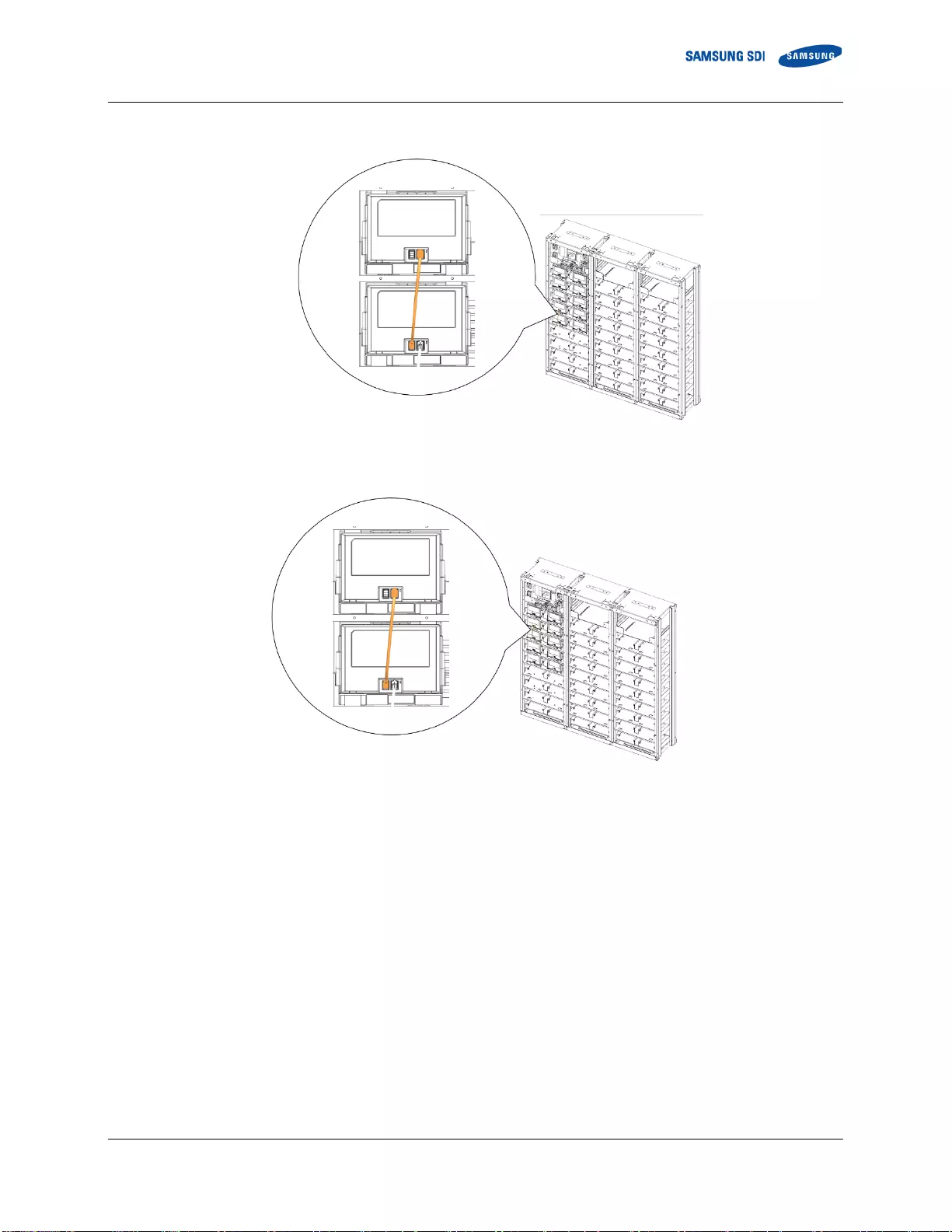
3. Installing the Product
English 7/2020. Rev 0.41 69
8. Connect the signal cable “WIRE ASSY MODULE TO MODULE #1" from Module #7 “Left connector” to
Module #8 “Right connector”.
Figure 3-76: Module #7 to Module #8 Signal Cabling
9. Connect the signal cable “WIRE ASSY MODULE TO MODULE #1" from Module #8 “Left Connector” to
Module #9 “Right Connector.”
Figure 3-77: Module #8 to Module #9 Signal Cabling
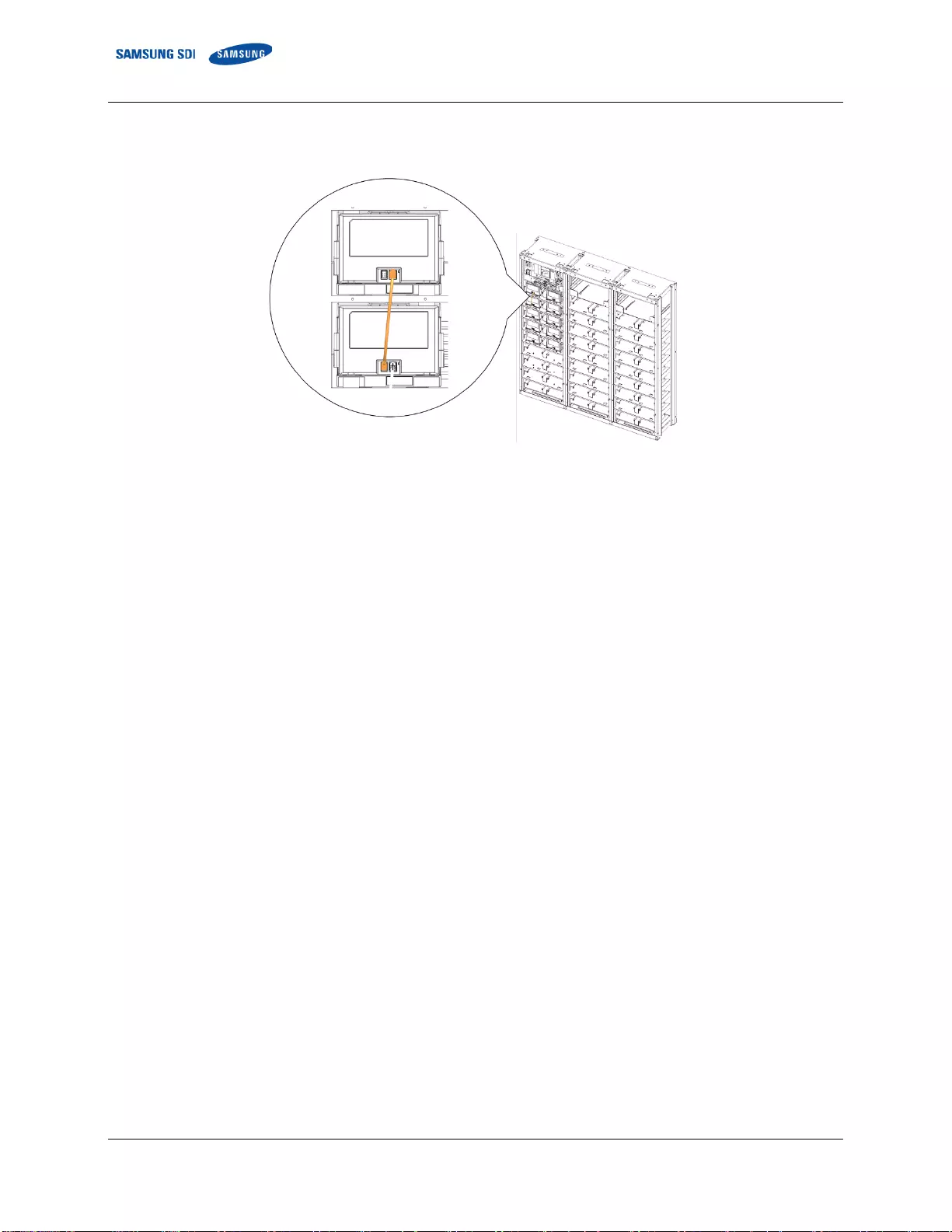
3. Installing the Product
70 English 7/2020. Rev 0.41
10. Connect the signal cable “WIRE ASSY MODULE TO MODULE #1" from Module #9 “Left Connector” to
Module #10 “Right Connector.”
No connection to Module #10 “Left Connector” is needed.
Figure 3-78: Module #9 to Module #10 Signal Cabling
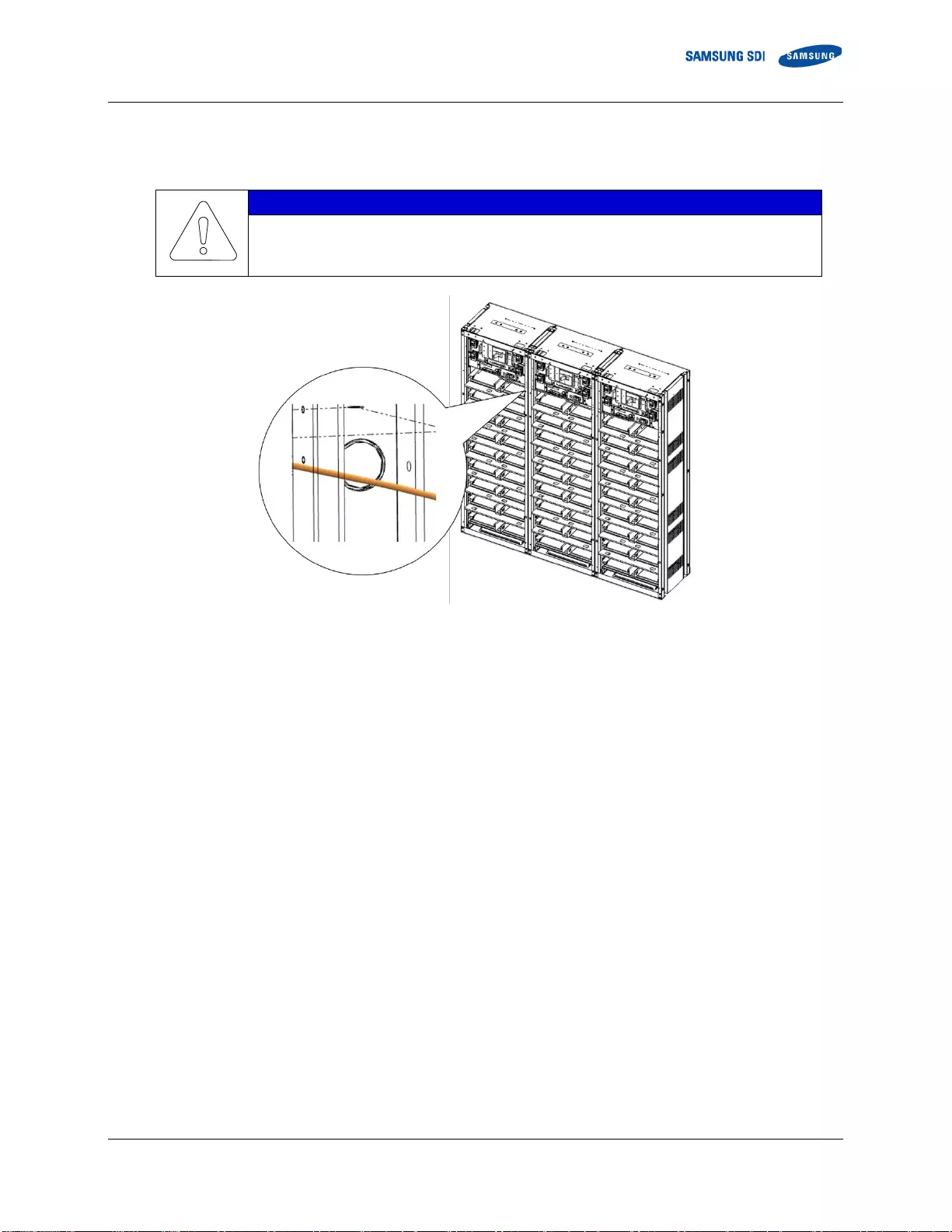
3. Installing the Product
English 7/2020. Rev 0.41 71
11. For a multiple rack system, connect the signal cables “WIRE ASSY RACK TO RACK #2” between each rack’s SMU. Push
the pre-punched hole to pass the cable through a circular hole in the side of the rack frame and through the opening
above Module #1 and Module #16.
NOTICE
See the examples for correct signal cable wire connections for both left and right rack
alignments.
Figure 3-79: Pre-Punched Hole for Signal Cable
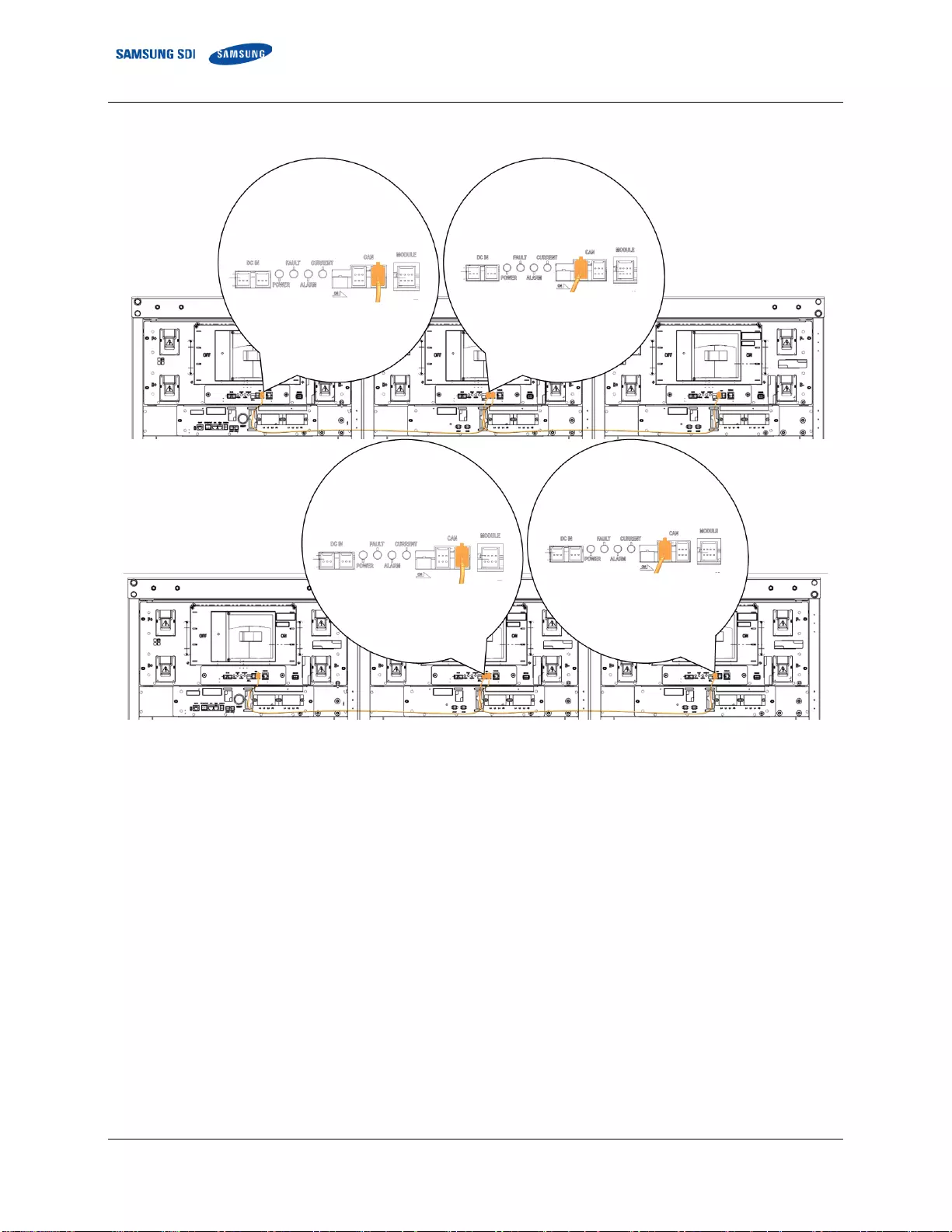
3. Installing the Product
72 English 7/2020. Rev 0.41
Signal Cabling Examples of Left Alignment of Trays (System BMS on the left)
Figure 3-80: Signal Cabling Examples of Left Alignment of SMU
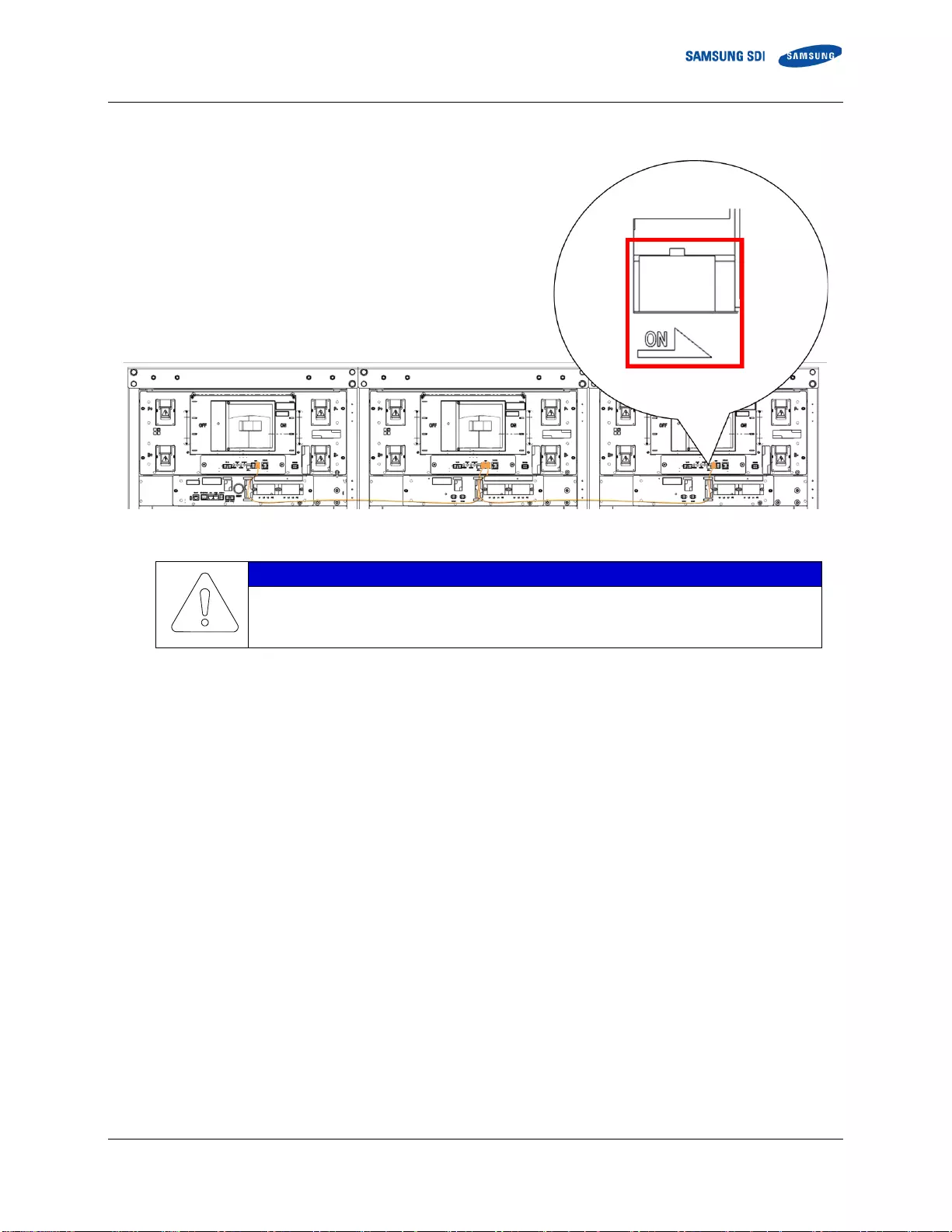
3. Installing the Product
English 7/2020. Rev 0.41 73
12. Turn the termination resistor switch on for the last SMU in the CANbus loop.
Figure 3-81: Termination Resistor Setting for Last SMU
.
NOTICE
Factory-provided cables are adequate for systems with Rack Frames bolted together. Different
configurations may require cable length modification.
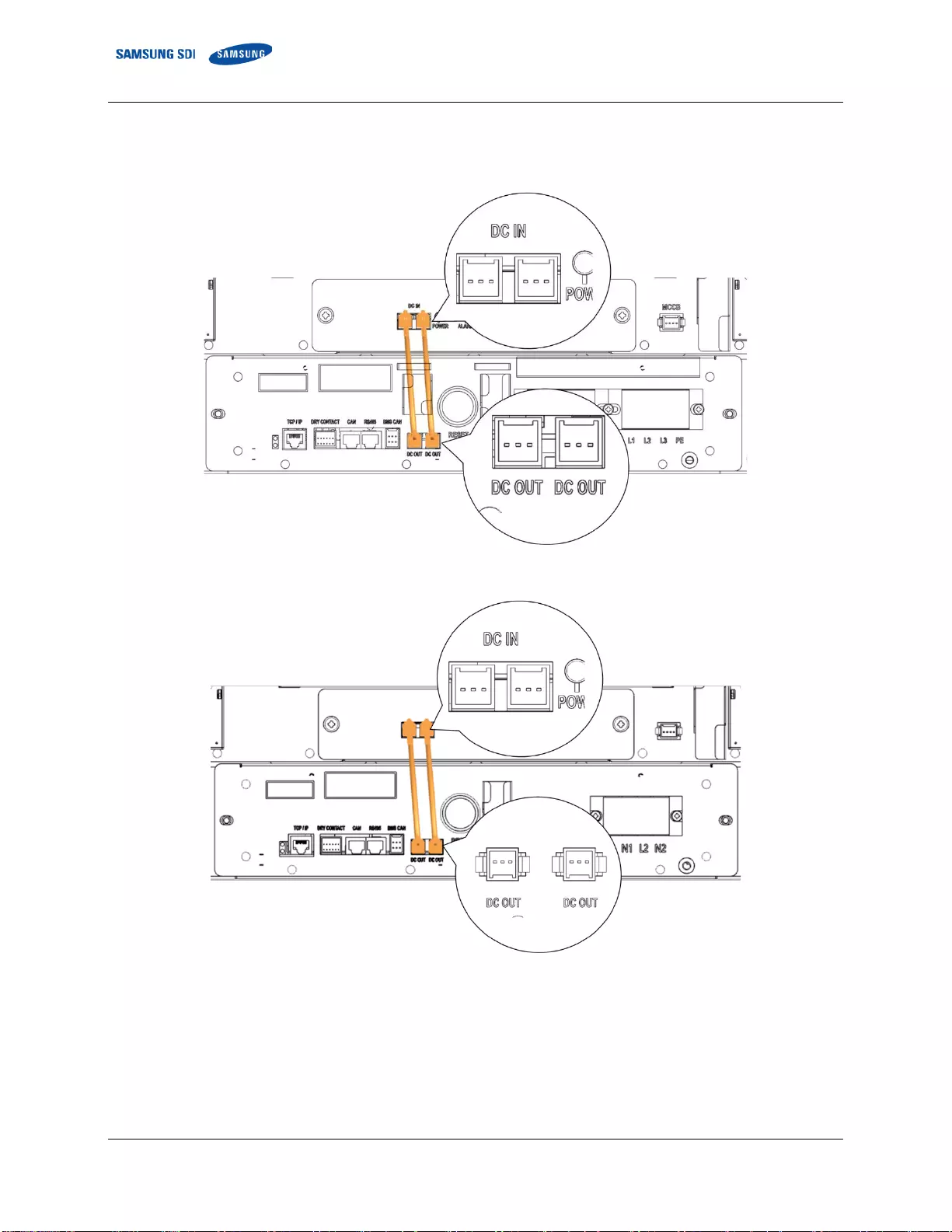
3. Installing the Product
74 English 7/2020. Rev 0.41
3.10.7 SMPS Assembly and SMU Power Cable Connection
Connect the SMU DC power cables.
Figure 3-82: DC Power Cables from SMPS Assembly 3 Phase Type A to SMU
Figure 3-83: DC Power Cables from SMPS Assembly 1 Phase Type A to SMU
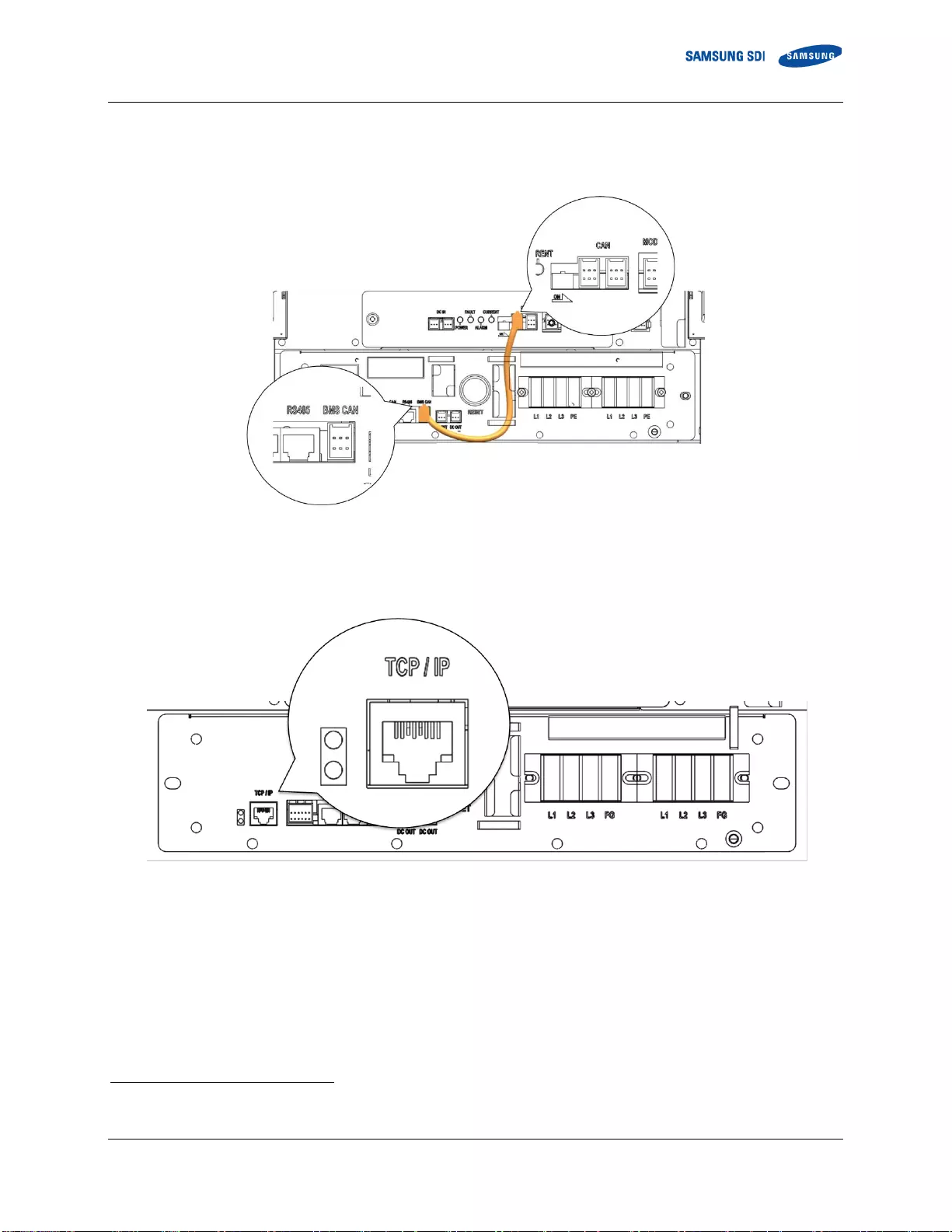
3. Installing the Product
English 7/2020. Rev 0.41 75
3.10.8 SMPS Assembly and SMU Signal Cable Connection
1. Connect the signal cable from the SMPS Assembly to SMU “WIRE ASSY RACK TO SYSTEM.”
Figure 3-84: CAN Signal Cable Connection from SMPS Assembly 3 Phase Type A to SMU
2. Connect the MODBUS TCP/IP Cable
4
to the SMPS Assembly Type A.
Figure 3-85: TCP/IP Cable Connection to SMPS Assembly
3. Connect the Dry Contact Cable to SMPS Assembly Type A
4
Not factory-provided. Must be provided by the installer or customer.
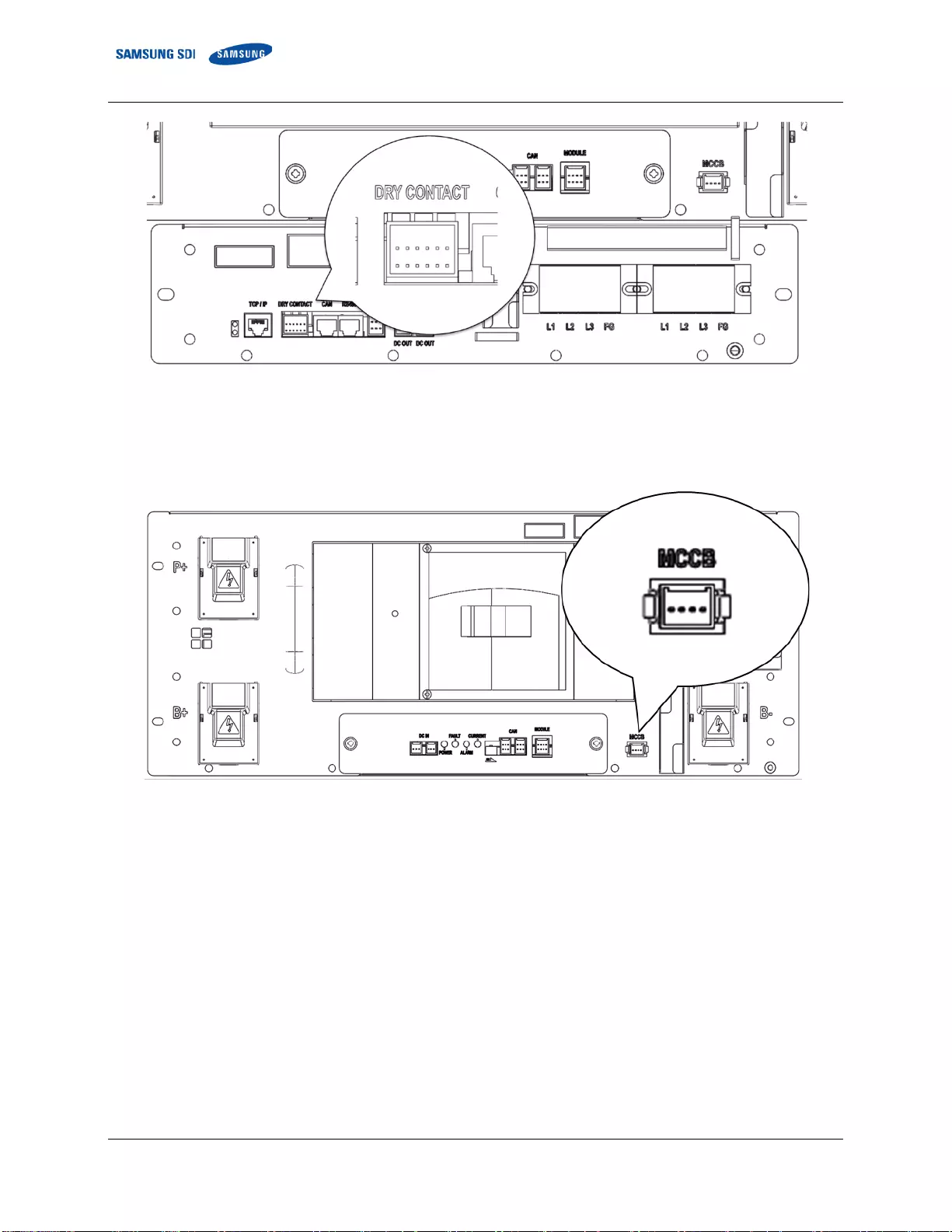
3. Installing the Product
76 English 7/2020. Rev 0.41
Figure 3-86: Dry Contact Cable Connection to SMPS Assembly
4. Optional: Connect the SMU MCCB Cable.
Figure 3-87: MCCB Extra Auxiliary Connection
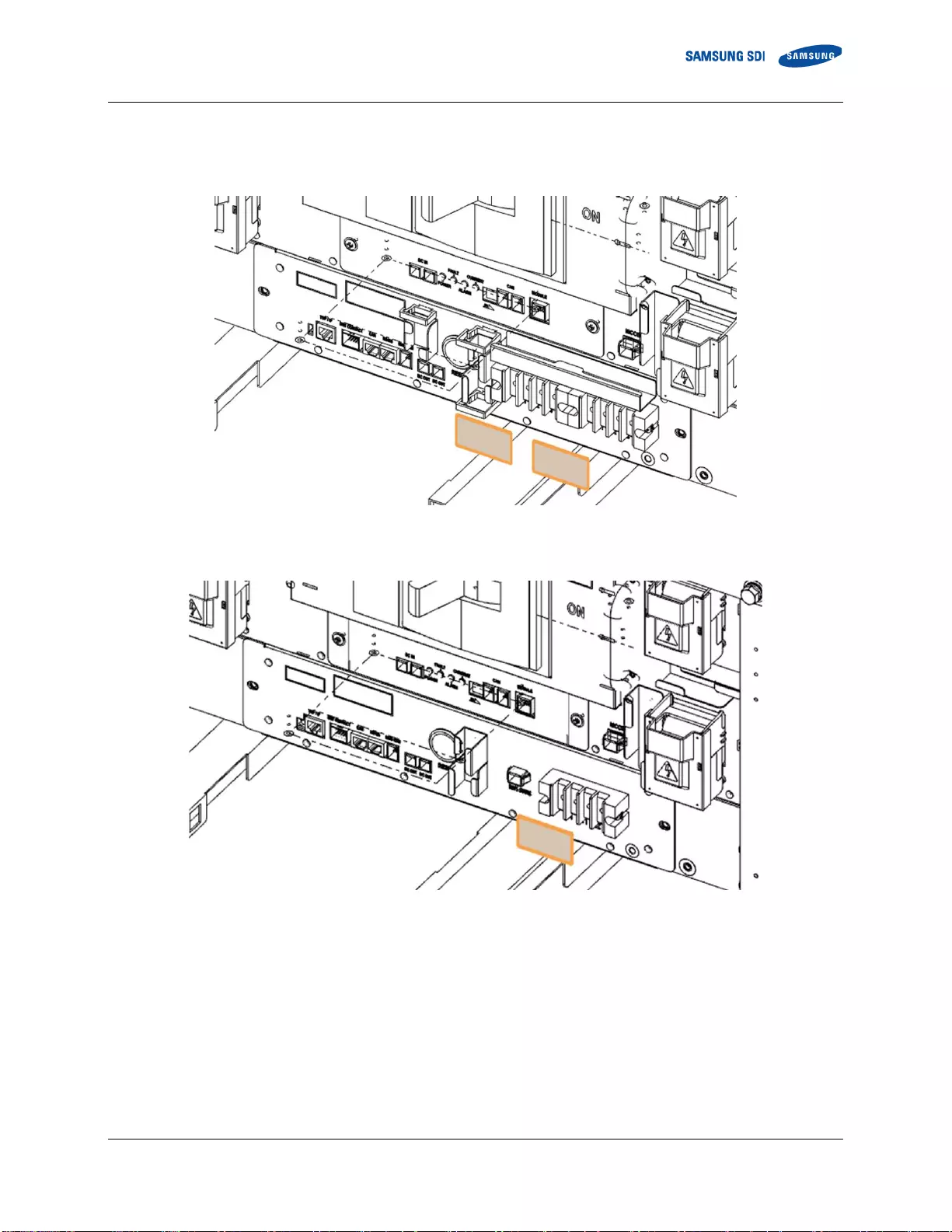
3. Installing the Product
English 7/2020. Rev 0.41 77
3.10.9 SMPS Assembly AC Input Connection
1. Remove the protective covers from the AC input terminals.
Figure 3-88: AC Input Terminals of SMPS Assembly 3 Phase Type A
Figure 3-89: AC Input Terminals of SMPS Assembly 1 Phase Type A
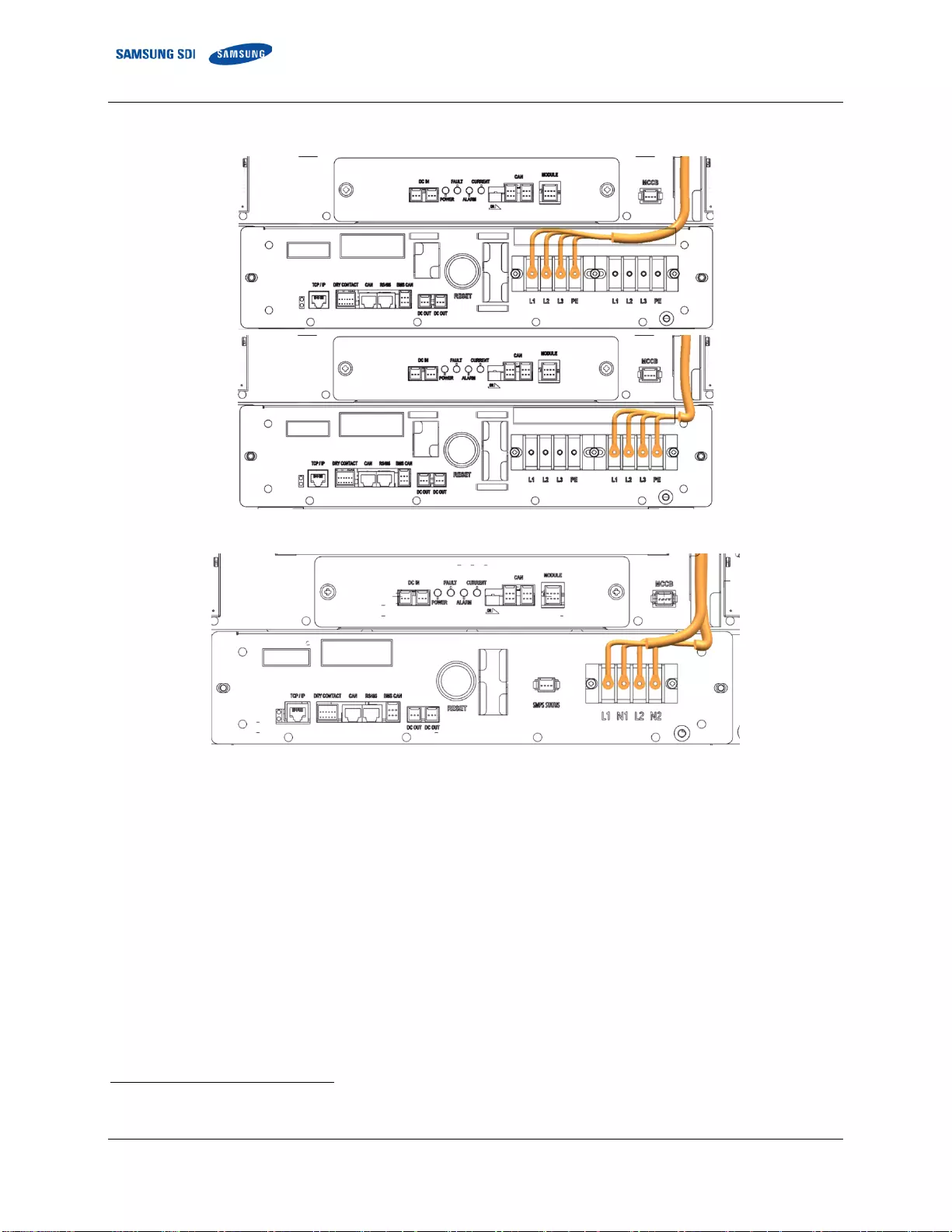
3. Installing the Product
78 English 7/2020. Rev 0.41
2. Connect each AC input in the SMPS Assembly. Make sure the AC cables are not energized.
5
Figure 3-90: SMPS Assembly 3 Phase Type A - AC Input Terminals with Cables Attached
Figure 3-91: SMPS Assembly 1 Phase Type A - AC Input Terminals with Cables Attached
5
AC Cables are not factory-provided. They must be provided by the installer or customer.
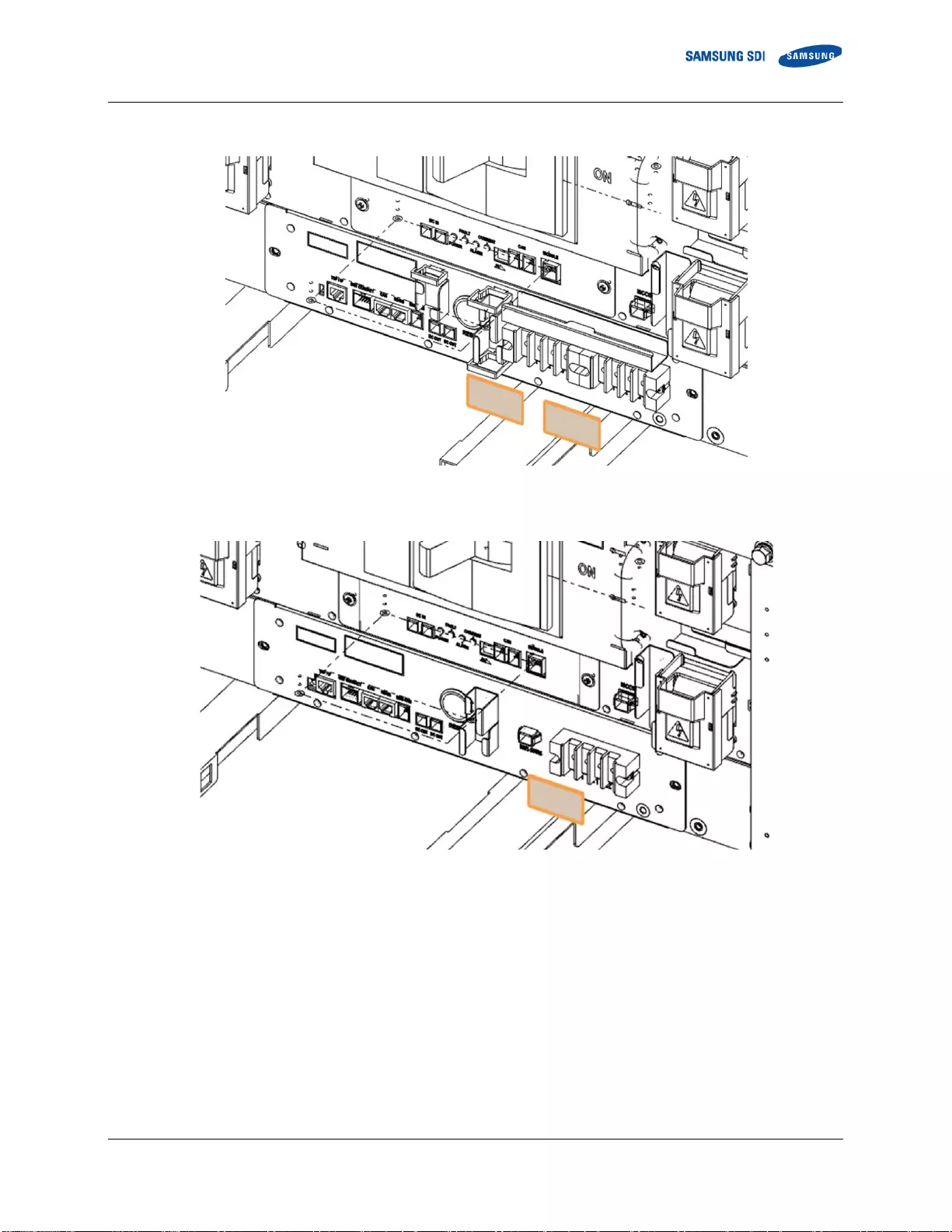
3. Installing the Product
English 7/2020. Rev 0.41 79
3. Reattach the protective covers to the AC input.
Figure 3-92: AC Input Terminals of SMPS Assembly 3 Phase Type A
Figure 3-93: AC Input Terminals of SMPS Assembly 1 Phase Type A
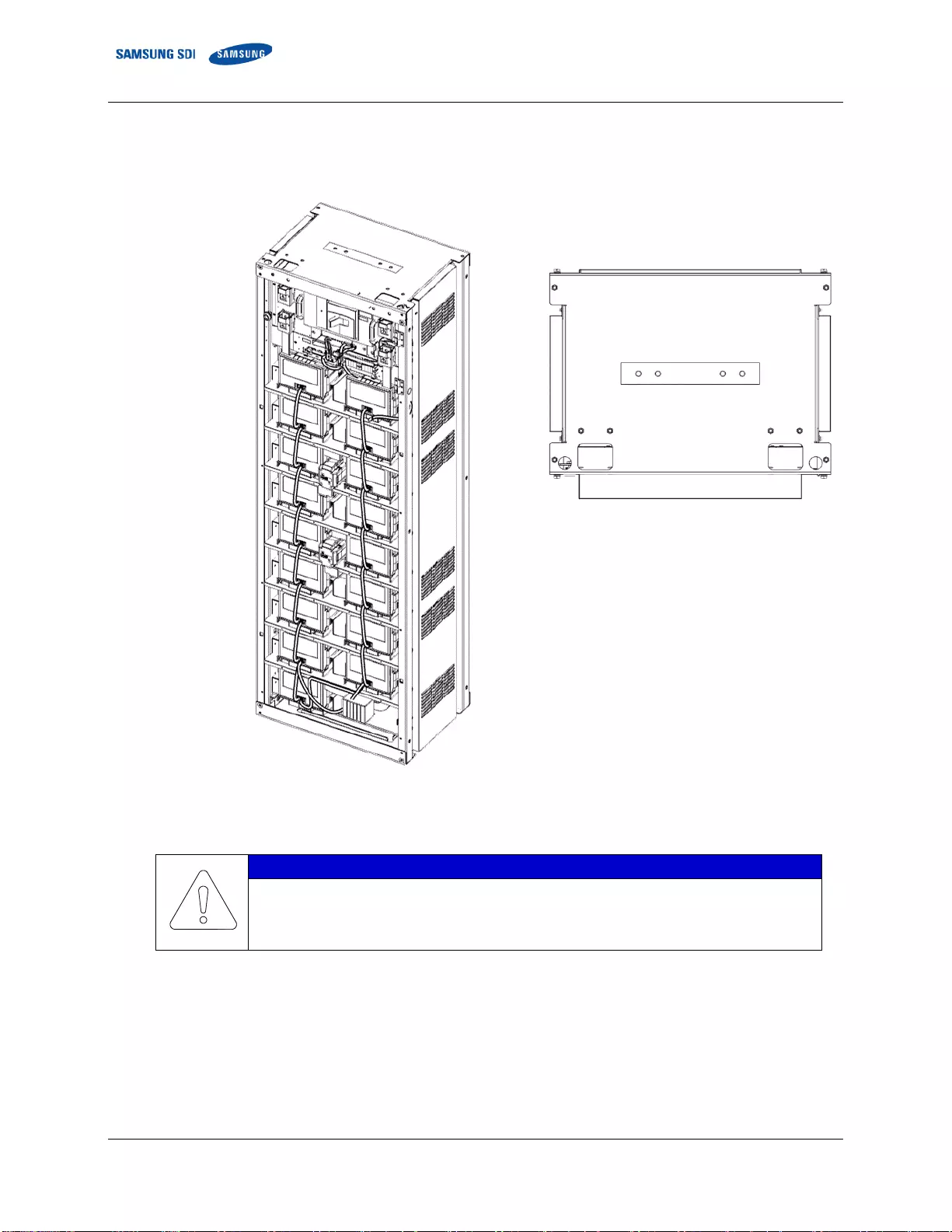
3. Installing the Product
80 English 7/2020. Rev 0.41
3.10.10 DC Link Cable Connection
1. Connect the ground cables.
Figure 3-94: Grounding Points (2 EA)
NOTICE
Connect the rack ground wire with an M12 screw. Rack ground screws and cables are not
factory-provided and must be provided by the installer or customer.
The fastening torque should be 30Nm (300kgf∙cm).
45 mm Pitch
Between Holes
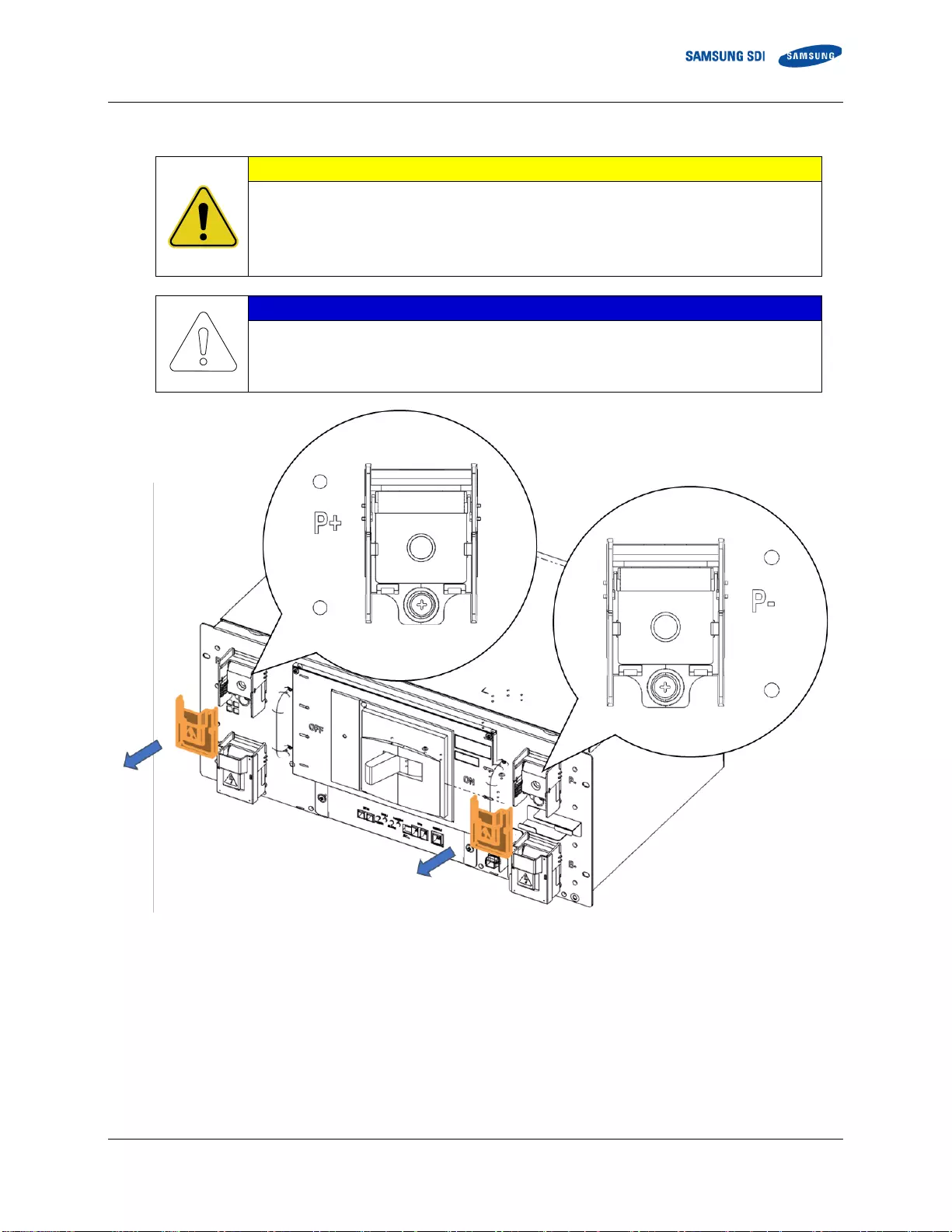
3. Installing the Product
English 7/2020. Rev 0.41 81
2. Connect the DC link high-voltage terminals from the UPS.
CAUTION
Verify with a voltmeter that no power is present on the system. Disconnect all input power
supplies. Use lock out/tag out procedures to secure the UPS and battery system before
beginning this step.
In this step, the battery and UPS are isolated by the SMU because the circuit breaker in the
SMU is opened.
NOTICE
Connect the high-voltage terminals using an M12 bolt.
The fastening torque should be 30 Nm (300 kgf/cm).
Figure 3-95: Connecting the DC Link High Current Terminals
3. Special case: if connecting the battery system in three-wire system, connect two racks to the three-wire DC bus connection
according to the diagram below. System BMS must be configured to operate correctly with this connection.
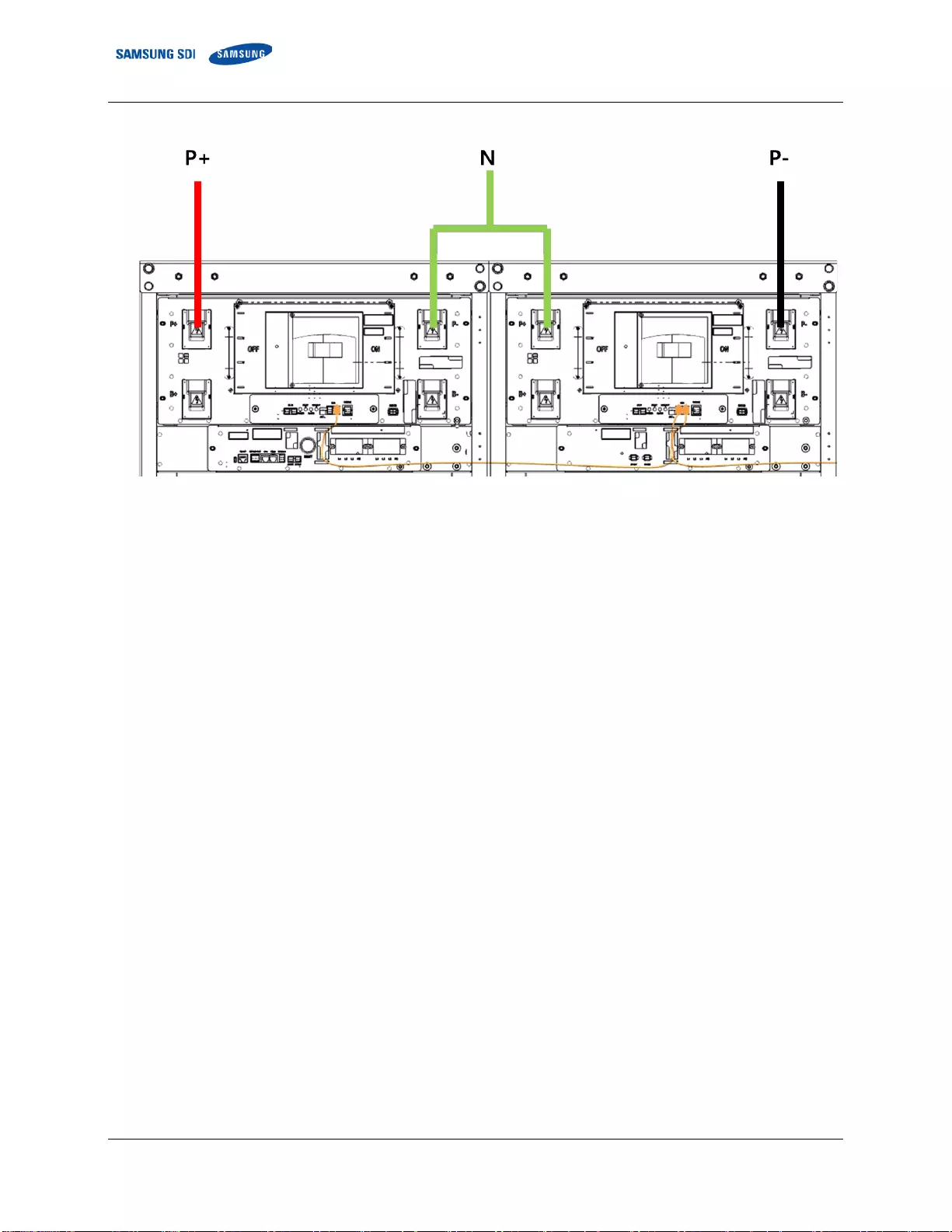
3. Installing the Product
82 English 7/2020. Rev 0.41
After installation is complete, check the following:
Bolt fastening condition
Screw fastening torque by sampling
High-voltage cable connection
Module connections
SMU connections

3. Installing the Product
English 7/2020. Rev 0.41 83
3.10.11 AC Input Commissioning
When the installation of the battery system is complete, SMPS Assembly’s AC inputs must be powered to turn the
BMS on.

3. Installing the Product
84 English 7/2020. Rev 0.41
3.10.12 BMS Configuration
NOTICE
It is recommended that the configuration of the Rack BMS and System BMS be done by
experienced service personnel. Incorrect configuration of the Rack BMS and System BMS will
cause communication failure.
This section has been removed from the customer facing copy of the installation manual.
3.10.13 Communication Check
This section has been removed from the customer facing copy of the installation manual.
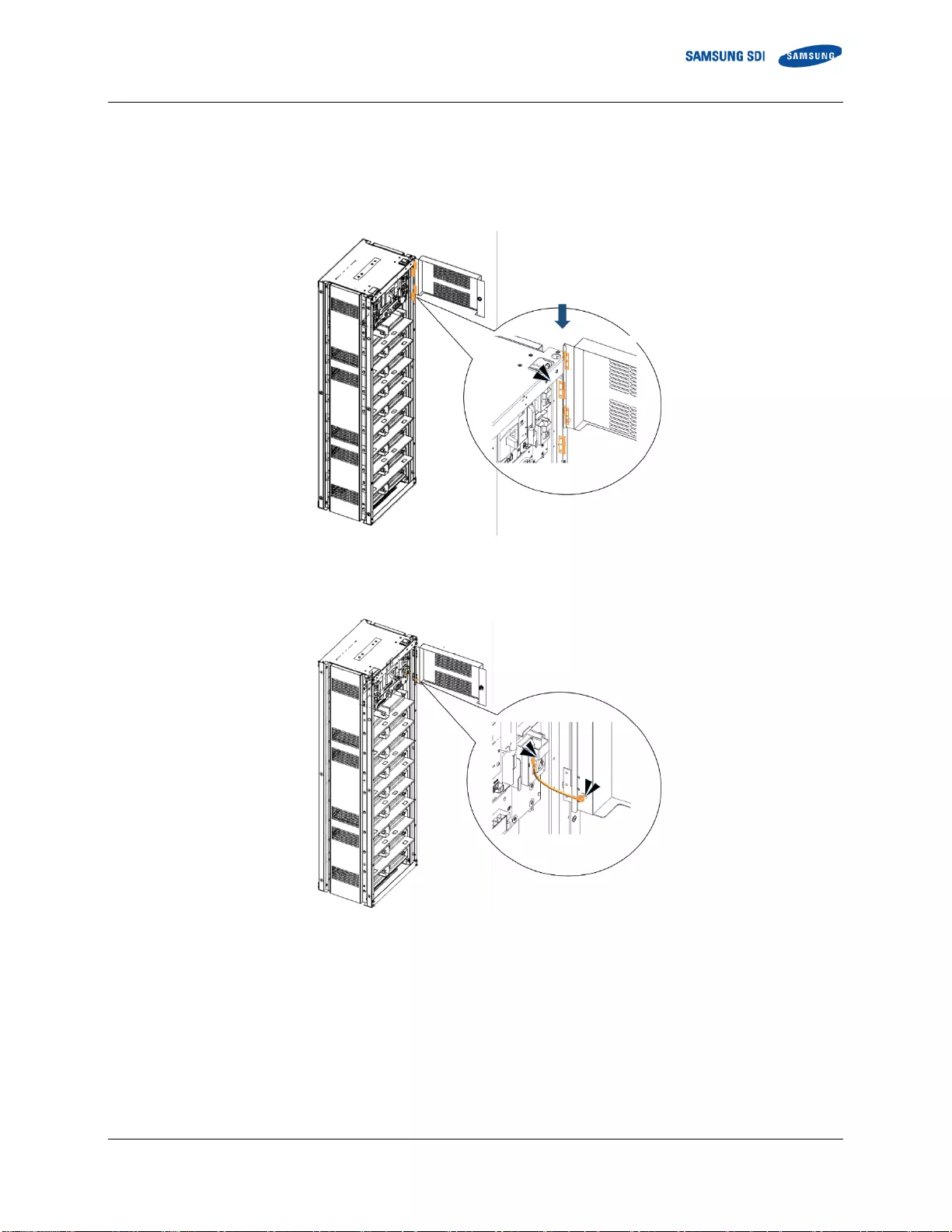
3. Installing the Product
English 7/2020. Rev 0.41 85
3.10.14 Reinstall the Front Door
1. Reinstall the front door to cover the battery rack and prevent further access to high voltage parts of the SMU and SMPS
Assembly.
2. Align the hinges on the rack frame and front door and slide the door down.
Figure 3-96: Reattaching the Front Door
3. Reattach the earth cable from the rack frame to the front door.
Figure 3-97: Reattaching the earth cable.
4. Close and lock the front door using the provided key. Do not misplace the key.
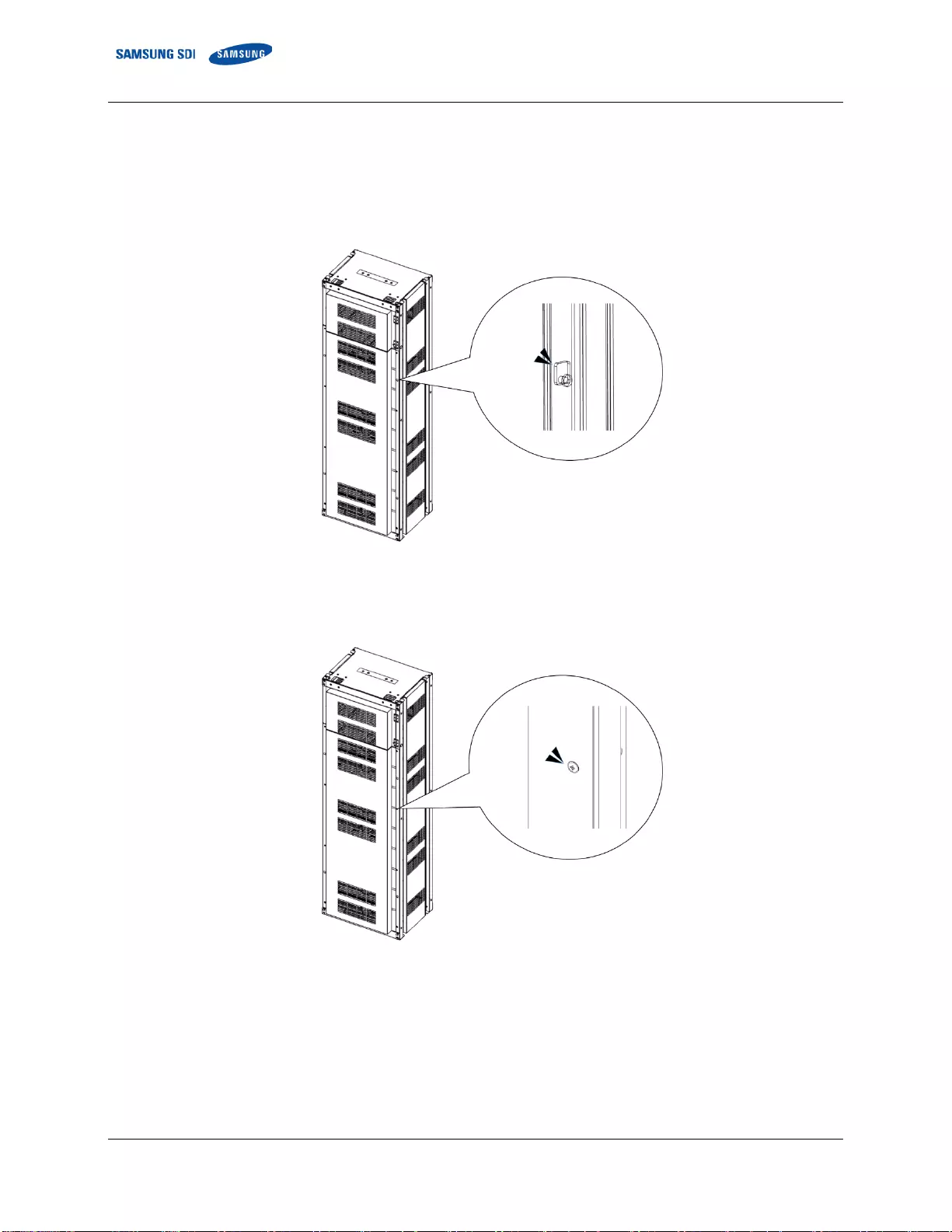
3. Installing the Product
86 English 7/2020. Rev 0.41
3.10.15 Reinstall the Front Panel
1. Reinstall the front panel to cover the battery rack and prevent further access to high voltage parts of the battery modules.
2. Locate the hooks that hold the front panel to the slots in the rack frame and insert the front panel to the rack frame. Make
sure all the hooks are inserted to the slot and the panel is flush with the rack frame before screwing.
Figure 3-98: Front panel hooks (four)
3. Screw in the front panel using the provided M5 screws for each front panel. Fasten the screws using torque of 5.1–6.1 Nm
(50–60 kgf/cm)
Figure 3-99: Front panel screws (eight)
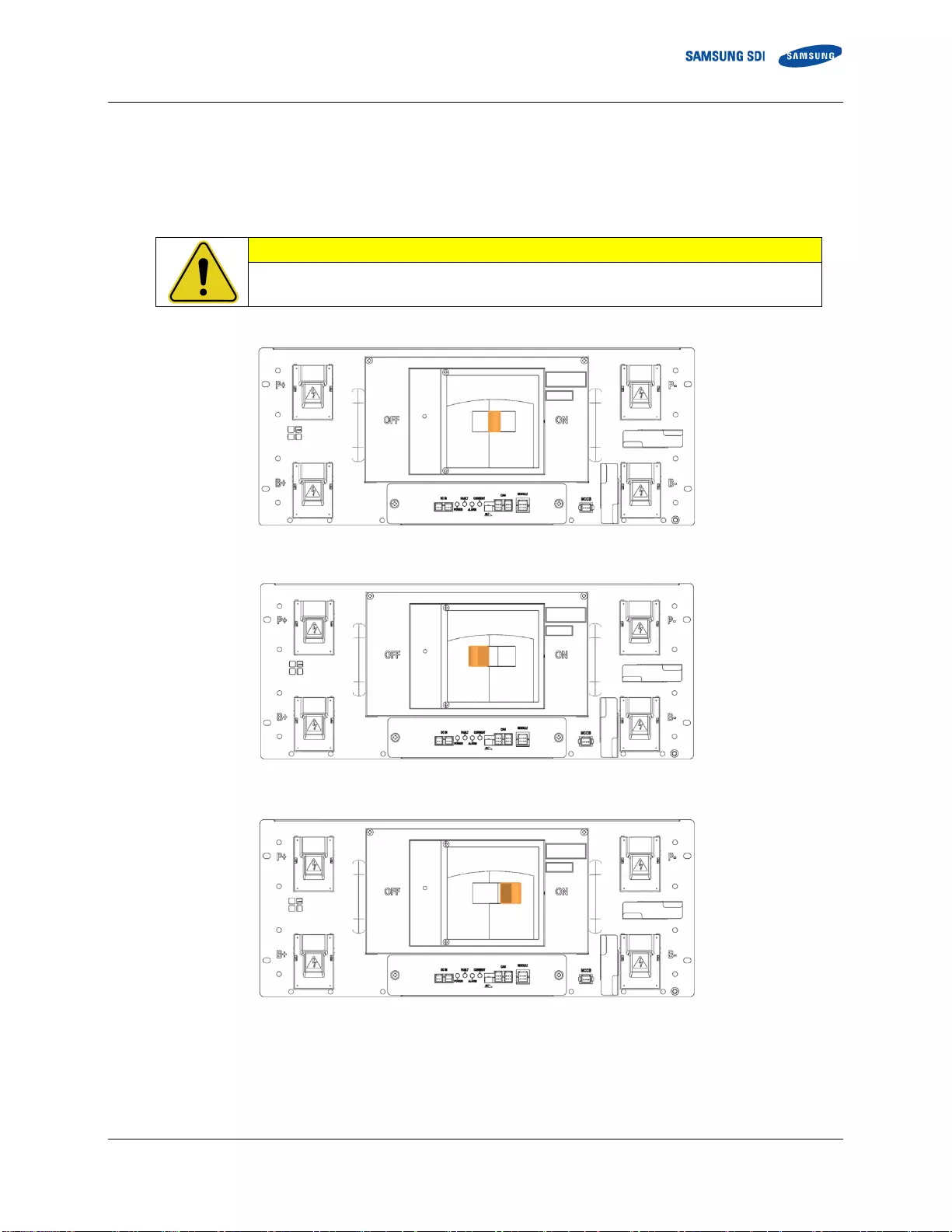
3. Installing the Product
English 7/2020. Rev 0.41 87
3.10.16 Switching on the MCCB
After powering on the battery system’s SMPS Assembly and SMU, and configuring the System BMS and the Rack
BMS according to the installation, check the indicator LED to determine whether the system status is normal. Refer
to the “Product Specification” and “Operation and Maintenance Manual” for information on the indicator LED.
CAUTION
Follow the instruction and guidelines for the UPS on connecting the battery to the UPS before
switching on the MCCB.
The MCCB in the SMU should be in the “TRIP” position during installation.
Figure 3-100: MCCB Handle in Trip Position
Shift the handle of the MCCB to “OFF.”
Figure 3-101: MCCB Handle in Off Position
Then shift the handle to “ON” to connect the battery system to the UPS DC link.
Figure 3-102: MCCB Handle in On Position

Memo

Memo

Memo

www.SamsungSDI.com

